Viavi Solutions 22060931 SmartClass TPS User Manual
Viavi Solutions Inc. SmartClass TPS Users Manual
Users Manual

SmartClass
Triple Play Services Tester
User’s Guide
SmartClass TPS User’s Guide
ii 22035456, Rev 001 May 2014
Notice
Every effort was made to ensure that the information in this document was accurate at the time of
printing. However, information is subject to change without notice, and JDSU reserves the right to
provide an addendum to this document with information not available at the time that this document
was created.
Copyright
© Copyright 2014, JDS Uniphase Corporation. All rights reserved. JDSU, Enabling Broadband and
Optical Innovation, Communications Test and Measurement Solutions, and the JDSU logo are
trademarks of JDS Uniphase Corporation (“JDS Uniphase”). All other trademarks are the property
of their respective owners. No part of this guide may be reproduced or transmitted electronically or
otherwise without written permission of the publisher.
Copyright release
Reproduction and distribution of this guide is authorized for Government purposes only.
Trademarks
Broadcom is either a trademark or registered trademark of Broadcom Corporation in the United
States and/or other countries.
Cisco is a registered trademark of Cisco Systems, Inc. and/or its affiliates in the U.S. and certain
other countries.
iPad is a registered trademark of Apple, Inc. in the United States and/or other countries.
JDS Uniphase, JDSU, and SmartClass are trademarks or registered trademarks of JDS Uniphase
Corporation in the United States and/or other countries.
Microsoft and Internet Explorer are either a trademarks or registered trademarks of Microsoft
Corporation in the United States and/or other countries.
Netscape and Netscape Navigator are either trademarks or registered trademarks of AOL LLC in
the United States and/or other countries.
NETGEAR is a registered trademark of NETGEAR, Inc. and/or its affiliates in the U.S. and certain
other countries.
Rolling Stream is either a trademark or registered trademark of UTStarcom Inc. in the United States
and/or other countries.
Specifications, terms, and conditions are subject to change without notice. All trademarks and regis-
tered trademarks are the property of their respective companies.
Ordering information
This guide is a product of JDSU's Technical Information Development Department, issued as part
of the SmartClass TPS. The catalog number for a printed guide is SCTP-Manual-Printed. The
catalog number for a USB stick containing all user documentation and utilities is SCTP-USB-G2.

SmartClass TPS User’s Guide
May 2014 22035456, Rev 001 iii
Terms and conditions
Specifications, terms, and conditions are subject to change without notice. The provision of hard-
ware, services, and/or software are subject to JDSU’s standard terms and conditions, available at
www.jdsu.com/terms.
Federal Communications Commission (FCC) Notice
This equipment has been tested and found to comply with the limits for a Class A digital device,
pursuant to Part 15 of the FCC Rules. These limits are designed to provide reasonable protection
against harmful interference in a residential installation. This equipment generates, uses and can
radiate radio frequency energy and, if not installed and used in accordance with the instructions,
may cause harmful interference to radio communications. However, there is no guarantee that inter-
ference will not occur in a particular installation.
This device complies with Part 15 of the FCC Rules. Operation is subject to the following two condi-
tions: (1) This device may not cause harmful interference, and (2) This device must accept any
interference received, including interference that may cause undesired operation.
If this equipment does cause harmful interference to radio or television reception, which can be
determined by turning the equipment off and on, the user is encouraged to try to correct the inter-
ference by one or more of the following measures:
– Reorient or relocate the receiving antenna.
– Increase the separation between the equipment and receiver.
– Connect the equipment into an outlet on a circuit different from that to which the receiver is
connected.
– Consult the dealer or an experienced radio/TV technician for help.
In order to maintain compliance with the limits of a Class A digital device JDSU requires that quality
interface cables be used when connecting to this equipment. Any changes or modifications not
expressly approved by JDSU could void the user's authority to operate the equipment.
CAUTION:
1To comply with FCC RF exposure compliance requirements, a separation distance of at least
20 cm must be maintained between the antenna of this device and all persons.
2This transmitter must not be co-located or operating in conjunction with any other antenna or
transmitter.
Industry Canada Requirements
This device complies with Industry Canada license-exempt RSS standard(s). Operation is subject
to the following two conditions: (1) this device may not cause interference, and (2) this device must
accept any interference, including interference that may cause undesired operation of the device.
Le présent appareil est conforme aux CNR d'Industrie Canada applicables aux appareils radio
exempts de licence. L'exploitation est autorisée aux deux conditions suivantes : (1) l'appareil ne doit
pas produire de brouillage, et (2) l'utilisateur de l'appareil doit accepter tout brouillage radioélec-
trique subi, même si le brouillage est susceptible d'en compromettre le fonctionnement.
This equipment complies with Industry Canada radiation exposure limits set forth for an uncon-
trolled environment.

SmartClass TPS User’s Guide
iv 22035456, Rev 001 May 2014
Cet équipement est conforme à l'exposition aux rayonnements Industry Canada limites établies
pour un environnement non contrôlé.
This Class A digital apparatus complies with Canadian ICES-003.
Cet appareil numérique de la classe A est conforme à la norme NMB-003 du Canada.
CAUTION:
This transmitter must not be co-located or operating in conjunction with any other antenna or trans-
mitter.
Cet émetteur ne doit pas être co-localisées ou opérant en conjonction avec une autre antenne ou
émetteur.
R&TTE Directive Compliance
This product is in compliance with essential requirements and other relevant provisions of
Directive 1999/5/EC.
Low Voltage Directive Compliance
This product was tested and conforms to the Low Voltage Directive, 73/23/EEC as amended by 93/
68/EEC. Conformity with this directive is based upon compliance with the harmonized safety stan-
dard, EN60950.
WEEE and Battery Directive Compliance
JDSU has established processes in compliance with the Waste Electrical and Electronic Equipment
(WEEE) Directive, 2002/96/EC, and the Battery Directive, 2006/66/EC.
This product, and the batteries used to power the product, should not be disposed of as unsorted
municipal waste and should be collected separately and disposed of according to your national
regulations. In the European Union, all equipment and batteries purchased from JDSU after 2005-
08-13 can be returned for disposal at the end of its useful life. JDSU will ensure that all waste equip-
ment and batteries returned are reused, recycled, or disposed of in an environmentally friendly
manner, and in compliance with all applicable national and international waste legislation.
It is the responsibility of the equipment owner to return equipment and batteries to JDSU for appro-
priate disposal. If the equipment or battery was imported by a reseller whose name or logo is
marked on the equipment or battery, then the owner should return the equipment or battery directly
to the reseller.
Instructions for returning waste equipment and batteries to JDSU can be found in the Environmental
section of JDSU’s web site at www.jdsu.com. If you have questions concerning disposal of your
equipment or batteries, contact JDSU’s WEEE Program Management team at
WEEE.EMEA@jdsu.com.

SmartClass TPS User’s Guide
May 2014 22035456, Rev 001 v
Table of Contents
About this Guide xiii
Purpose and scope . . . . . . . . . . . . . . . . . . . . . . . . . . . . . . . . . . . . . . . . . . . . . . . . . . . . . . . . . . xiv
Assumptions . . . . . . . . . . . . . . . . . . . . . . . . . . . . . . . . . . . . . . . . . . . . . . . . . . . . . . . . . . . . . . . xiv
Safety and compliance information . . . . . . . . . . . . . . . . . . . . . . . . . . . . . . . . . . . . . . . . . . . . . xiv
Conventions . . . . . . . . . . . . . . . . . . . . . . . . . . . . . . . . . . . . . . . . . . . . . . . . . . . . . . . . . . . . . . . . xiv
Chapter 1 Getting Started 1
About the SmartClass TPS . . . . . . . . . . . . . . . . . . . . . . . . . . . . . . . . . . . . . . . . . . . . . . . . . . . . . 2
Ship list . . . . . . . . . . . . . . . . . . . . . . . . . . . . . . . . . . . . . . . . . . . . . . . . . . . . . . . . . . . . . . . . . . . . . 2
Configurations and options . . . . . . . . . . . . . . . . . . . . . . . . . . . . . . . . . . . . . . . . . . . . . . . . . . . . 2
Configurations . . . . . . . . . . . . . . . . . . . . . . . . . . . . . . . . . . . . . . . . . . . . . . . . . . . . . . . . . . . . . 3
Software options . . . . . . . . . . . . . . . . . . . . . . . . . . . . . . . . . . . . . . . . . . . . . . . . . . . . . . . . . . . 3
Features and capabilities . . . . . . . . . . . . . . . . . . . . . . . . . . . . . . . . . . . . . . . . . . . . . . . . . . . . . . 4
Preparation for use . . . . . . . . . . . . . . . . . . . . . . . . . . . . . . . . . . . . . . . . . . . . . . . . . . . . . . . . . . . 6
General preparation. . . . . . . . . . . . . . . . . . . . . . . . . . . . . . . . . . . . . . . . . . . . . . . . . . . . . . . . . 6
Changing the AC line plug fitting . . . . . . . . . . . . . . . . . . . . . . . . . . . . . . . . . . . . . . . . . . . . . . . 7
Exploring the front panel. . . . . . . . . . . . . . . . . . . . . . . . . . . . . . . . . . . . . . . . . . . . . . . . . . . . . . . 8
Status LEDs . . . . . . . . . . . . . . . . . . . . . . . . . . . . . . . . . . . . . . . . . . . . . . . . . . . . . . . . . . . . . . . 8
LCD . . . . . . . . . . . . . . . . . . . . . . . . . . . . . . . . . . . . . . . . . . . . . . . . . . . . . . . . . . . . . . . . . . . . . 9
Cancel key . . . . . . . . . . . . . . . . . . . . . . . . . . . . . . . . . . . . . . . . . . . . . . . . . . . . . . . . . . . . . . . . 9
OK key. . . . . . . . . . . . . . . . . . . . . . . . . . . . . . . . . . . . . . . . . . . . . . . . . . . . . . . . . . . . . . . . . . . 9
Arrow keys. . . . . . . . . . . . . . . . . . . . . . . . . . . . . . . . . . . . . . . . . . . . . . . . . . . . . . . . . . . . . . . . 9
Keypad. . . . . . . . . . . . . . . . . . . . . . . . . . . . . . . . . . . . . . . . . . . . . . . . . . . . . . . . . . . . . . . . . . . 9
Utility key . . . . . . . . . . . . . . . . . . . . . . . . . . . . . . . . . . . . . . . . . . . . . . . . . . . . . . . . . . . . . . . . . 9
Power key . . . . . . . . . . . . . . . . . . . . . . . . . . . . . . . . . . . . . . . . . . . . . . . . . . . . . . . . . . . . . . . 10
Exploring the connector panel . . . . . . . . . . . . . . . . . . . . . . . . . . . . . . . . . . . . . . . . . . . . . . . . . .11
DSL connector. . . . . . . . . . . . . . . . . . . . . . . . . . . . . . . . . . . . . . . . . . . . . . . . . . . . . . . . . . . . .11
POTS connector . . . . . . . . . . . . . . . . . . . . . . . . . . . . . . . . . . . . . . . . . . . . . . . . . . . . . . . . . . .11
USB host connector. . . . . . . . . . . . . . . . . . . . . . . . . . . . . . . . . . . . . . . . . . . . . . . . . . . . . . . . .11
Ethernet connector . . . . . . . . . . . . . . . . . . . . . . . . . . . . . . . . . . . . . . . . . . . . . . . . . . . . . . . . 12

Table of Contents
SmartClass TPS User’s Guide
May 2014 22035456, Rev 001 vi
Exploring the bottom panel. . . . . . . . . . . . . . . . . . . . . . . . . . . . . . . . . . . . . . . . . . . . . . . . . . . . 12
Exploring the top panel . . . . . . . . . . . . . . . . . . . . . . . . . . . . . . . . . . . . . . . . . . . . . . . . . . . . . . . 13
Navigating the user interface . . . . . . . . . . . . . . . . . . . . . . . . . . . . . . . . . . . . . . . . . . . . . . . . . . 13
Menu screens . . . . . . . . . . . . . . . . . . . . . . . . . . . . . . . . . . . . . . . . . . . . . . . . . . . . . . . . . . . . 14
Data entry screens. . . . . . . . . . . . . . . . . . . . . . . . . . . . . . . . . . . . . . . . . . . . . . . . . . . . . . . . . 15
Result screens. . . . . . . . . . . . . . . . . . . . . . . . . . . . . . . . . . . . . . . . . . . . . . . . . . . . . . . . . . . . 15
Scroll bar . . . . . . . . . . . . . . . . . . . . . . . . . . . . . . . . . . . . . . . . . . . . . . . . . . . . . . . . . . . . . . . . 15
Colors . . . . . . . . . . . . . . . . . . . . . . . . . . . . . . . . . . . . . . . . . . . . . . . . . . . . . . . . . . . . . . . . . . 15
Ellipses . . . . . . . . . . . . . . . . . . . . . . . . . . . . . . . . . . . . . . . . . . . . . . . . . . . . . . . . . . . . . . . . . 16
Using the keypad . . . . . . . . . . . . . . . . . . . . . . . . . . . . . . . . . . . . . . . . . . . . . . . . . . . . . . . . . . . . 16
Selecting a menu option . . . . . . . . . . . . . . . . . . . . . . . . . . . . . . . . . . . . . . . . . . . . . . . . . . . . 16
Specifying On/Off or Yes/No values. . . . . . . . . . . . . . . . . . . . . . . . . . . . . . . . . . . . . . . . . . . . 16
Entering numeric values . . . . . . . . . . . . . . . . . . . . . . . . . . . . . . . . . . . . . . . . . . . . . . . . . . . . 16
Typing text . . . . . . . . . . . . . . . . . . . . . . . . . . . . . . . . . . . . . . . . . . . . . . . . . . . . . . . . . . . . . . . 16
Using a USB keyboard . . . . . . . . . . . . . . . . . . . . . . . . . . . . . . . . . . . . . . . . . . . . . . . . . . . . . 17
Customizing the user interface. . . . . . . . . . . . . . . . . . . . . . . . . . . . . . . . . . . . . . . . . . . . . . . . . 17
Chapter 2 Instrument Settings 19
Managing files . . . . . . . . . . . . . . . . . . . . . . . . . . . . . . . . . . . . . . . . . . . . . . . . . . . . . . . . . . . . . . 20
Managing jobs . . . . . . . . . . . . . . . . . . . . . . . . . . . . . . . . . . . . . . . . . . . . . . . . . . . . . . . . . . . . . . 21
Creating and editing jobs. . . . . . . . . . . . . . . . . . . . . . . . . . . . . . . . . . . . . . . . . . . . . . . . . . . . 21
Activating a job . . . . . . . . . . . . . . . . . . . . . . . . . . . . . . . . . . . . . . . . . . . . . . . . . . . . . . . . . . . 22
Exporting a job. . . . . . . . . . . . . . . . . . . . . . . . . . . . . . . . . . . . . . . . . . . . . . . . . . . . . . . . . . . . 22
Deleting a job. . . . . . . . . . . . . . . . . . . . . . . . . . . . . . . . . . . . . . . . . . . . . . . . . . . . . . . . . . . . . 22
Associating test results to a job . . . . . . . . . . . . . . . . . . . . . . . . . . . . . . . . . . . . . . . . . . . . . . . 23
Communicating with a mobile device . . . . . . . . . . . . . . . . . . . . . . . . . . . . . . . . . . . . . . . . . . . 23
Accessing the SmartClass Triple Play Services remotely using VNC . . . . . . . . . . . . . . . . . 24
Setting the date and time . . . . . . . . . . . . . . . . . . . . . . . . . . . . . . . . . . . . . . . . . . . . . . . . . . . . . 25
Setting the date . . . . . . . . . . . . . . . . . . . . . . . . . . . . . . . . . . . . . . . . . . . . . . . . . . . . . . . . . . . 25
Setting the time . . . . . . . . . . . . . . . . . . . . . . . . . . . . . . . . . . . . . . . . . . . . . . . . . . . . . . . . . . . 26
Specifying auto power down settings . . . . . . . . . . . . . . . . . . . . . . . . . . . . . . . . . . . . . . . . . . . 26
Adjusting the screen settings. . . . . . . . . . . . . . . . . . . . . . . . . . . . . . . . . . . . . . . . . . . . . . . . . . 27
Changing keypad setup. . . . . . . . . . . . . . . . . . . . . . . . . . . . . . . . . . . . . . . . . . . . . . . . . . . . . . . 27
Setting the repeat delay. . . . . . . . . . . . . . . . . . . . . . . . . . . . . . . . . . . . . . . . . . . . . . . . . . . . . 27
Setting the repeat rate . . . . . . . . . . . . . . . . . . . . . . . . . . . . . . . . . . . . . . . . . . . . . . . . . . . . . . 27
Specifying the volume level . . . . . . . . . . . . . . . . . . . . . . . . . . . . . . . . . . . . . . . . . . . . . . . . . . . 28
Specifying international settings . . . . . . . . . . . . . . . . . . . . . . . . . . . . . . . . . . . . . . . . . . . . . . . 28
Managing test configurations . . . . . . . . . . . . . . . . . . . . . . . . . . . . . . . . . . . . . . . . . . . . . . . . . . 29
Saving test configurations . . . . . . . . . . . . . . . . . . . . . . . . . . . . . . . . . . . . . . . . . . . . . . . . . . . 29
Loading a configuration . . . . . . . . . . . . . . . . . . . . . . . . . . . . . . . . . . . . . . . . . . . . . . . . . . . . . 29
Viewing unit revisions, options, and IDs . . . . . . . . . . . . . . . . . . . . . . . . . . . . . . . . . . . . . . . . . 30
Restoring factory defaults. . . . . . . . . . . . . . . . . . . . . . . . . . . . . . . . . . . . . . . . . . . . . . . . . . . . . 30
Chapter 3 Automated Testing 31
About the automated tests . . . . . . . . . . . . . . . . . . . . . . . . . . . . . . . . . . . . . . . . . . . . . . . . . . . . 32
Running the OneCheck test . . . . . . . . . . . . . . . . . . . . . . . . . . . . . . . . . . . . . . . . . . . . . . . . . . . 32
Running the VideoCheck test . . . . . . . . . . . . . . . . . . . . . . . . . . . . . . . . . . . . . . . . . . . . . . . . . . 34

Table of Contents
SmartClass TPS User’s Guide
May 2014 22035456, Rev 001 vii
Chapter 4 Using the SmartClass TPS
with a mobile device 35
Controlling the SmartClass with a mobile device. . . . . . . . . . . . . . . . . . . . . . . . . . . . . . . . . . 36
Controlling the device interface . . . . . . . . . . . . . . . . . . . . . . . . . . . . . . . . . . . . . . . . . . . . . . . . 37
Testing with SmartIDs . . . . . . . . . . . . . . . . . . . . . . . . . . . . . . . . . . . . . . . . . . . . . . . . . . . . . . . . 37
Viewing video on a mobile device . . . . . . . . . . . . . . . . . . . . . . . . . . . . . . . . . . . . . . . . . . . . . . 39
Chapter 5 Ethernet TE Testing 41
About Ethernet TE testing. . . . . . . . . . . . . . . . . . . . . . . . . . . . . . . . . . . . . . . . . . . . . . . . . . . . . 42
Specifying the network setup . . . . . . . . . . . . . . . . . . . . . . . . . . . . . . . . . . . . . . . . . . . . . . . . . . 42
Connecting to the line . . . . . . . . . . . . . . . . . . . . . . . . . . . . . . . . . . . . . . . . . . . . . . . . . . . . . . . . 44
Viewing results. . . . . . . . . . . . . . . . . . . . . . . . . . . . . . . . . . . . . . . . . . . . . . . . . . . . . . . . . . . . . . 45
Chapter 6 DSL Testing 47
About xDSL testing . . . . . . . . . . . . . . . . . . . . . . . . . . . . . . . . . . . . . . . . . . . . . . . . . . . . . . . . . . 48
BCM96368 test options . . . . . . . . . . . . . . . . . . . . . . . . . . . . . . . . . . . . . . . . . . . . . . . . . . . . . 48
BCM963168 test options . . . . . . . . . . . . . . . . . . . . . . . . . . . . . . . . . . . . . . . . . . . . . . . . . . . . 48
Selecting the test mode. . . . . . . . . . . . . . . . . . . . . . . . . . . . . . . . . . . . . . . . . . . . . . . . . . . . . . . 49
Specifying test settings. . . . . . . . . . . . . . . . . . . . . . . . . . . . . . . . . . . . . . . . . . . . . . . . . . . . . . . 49
Specifying the modem operation . . . . . . . . . . . . . . . . . . . . . . . . . . . . . . . . . . . . . . . . . . . . . . 50
Specifying DSL settings. . . . . . . . . . . . . . . . . . . . . . . . . . . . . . . . . . . . . . . . . . . . . . . . . . . . . 52
Specifying DSL (single line) settings . . . . . . . . . . . . . . . . . . . . . . . . . . . . . . . . . . . . . . . . 52
Specifying DSL settings for Bonded mode (For BCM96368 modem only) . . . . . . . . . . . 53
Specifying network settings . . . . . . . . . . . . . . . . . . . . . . . . . . . . . . . . . . . . . . . . . . . . . . . . . . 54
Specifying WAN settings . . . . . . . . . . . . . . . . . . . . . . . . . . . . . . . . . . . . . . . . . . . . . . . . . . . . 54
Specifying LAN settings . . . . . . . . . . . . . . . . . . . . . . . . . . . . . . . . . . . . . . . . . . . . . . . . . 56
Connecting to the line . . . . . . . . . . . . . . . . . . . . . . . . . . . . . . . . . . . . . . . . . . . . . . . . . . . . . . . . 57
Connecting to a single twisted pair . . . . . . . . . . . . . . . . . . . . . . . . . . . . . . . . . . . . . . . . . . . . 57
Connecting to bonded twisted pairs. . . . . . . . . . . . . . . . . . . . . . . . . . . . . . . . . . . . . . . . . . . . 57
Connecting to a single pair at the NID/demarc . . . . . . . . . . . . . . . . . . . . . . . . . . . . . . . . . . . 58
Connecting to bonded pairs at the NID/demarc. . . . . . . . . . . . . . . . . . . . . . . . . . . . . . . . . . . 58
Testing the physical layer . . . . . . . . . . . . . . . . . . . . . . . . . . . . . . . . . . . . . . . . . . . . . . . . . . . . . 58
Testing line quality. . . . . . . . . . . . . . . . . . . . . . . . . . . . . . . . . . . . . . . . . . . . . . . . . . . . . . . . . . . 58
Terminating the loop (SELT) . . . . . . . . . . . . . . . . . . . . . . . . . . . . . . . . . . . . . . . . . . . . . . . . . . . 60
Chapter 7 Data testing 61
About data testing . . . . . . . . . . . . . . . . . . . . . . . . . . . . . . . . . . . . . . . . . . . . . . . . . . . . . . . . . . . 62
Connecting to the line . . . . . . . . . . . . . . . . . . . . . . . . . . . . . . . . . . . . . . . . . . . . . . . . . . . . . . . . 62
IP Ping testing . . . . . . . . . . . . . . . . . . . . . . . . . . . . . . . . . . . . . . . . . . . . . . . . . . . . . . . . . . . . . . 62
Monitoring pings . . . . . . . . . . . . . . . . . . . . . . . . . . . . . . . . . . . . . . . . . . . . . . . . . . . . . . . . . . . . 63
Throughput testing . . . . . . . . . . . . . . . . . . . . . . . . . . . . . . . . . . . . . . . . . . . . . . . . . . . . . . . . . . 64
Tracing the packet route . . . . . . . . . . . . . . . . . . . . . . . . . . . . . . . . . . . . . . . . . . . . . . . . . . . . . . 65
Capturing network traffic . . . . . . . . . . . . . . . . . . . . . . . . . . . . . . . . . . . . . . . . . . . . . . . . . . . . . 65

Table of Contents
SmartClass TPS User’s Guide
May 2014 22035456, Rev 001 viii
Chapter 8 Wi-Fi Testing 67
About Wi-Fi Testing . . . . . . . . . . . . . . . . . . . . . . . . . . . . . . . . . . . . . . . . . . . . . . . . . . . . . . . . . . 68
Scanning for Wi-Fi networks. . . . . . . . . . . . . . . . . . . . . . . . . . . . . . . . . . . . . . . . . . . . . . . . . . . 68
Emulating a Wi-Fi end point . . . . . . . . . . . . . . . . . . . . . . . . . . . . . . . . . . . . . . . . . . . . . . . . . . . 70
Providing Wi-Fi access . . . . . . . . . . . . . . . . . . . . . . . . . . . . . . . . . . . . . . . . . . . . . . . . . . . . . . . 71
Chapter 9 HPNA Testing 73
About HPNA Testing . . . . . . . . . . . . . . . . . . . . . . . . . . . . . . . . . . . . . . . . . . . . . . . . . . . . . . . . . 74
Connecting to the line . . . . . . . . . . . . . . . . . . . . . . . . . . . . . . . . . . . . . . . . . . . . . . . . . . . . . . . . 74
Monitoring the HPNA network . . . . . . . . . . . . . . . . . . . . . . . . . . . . . . . . . . . . . . . . . . . . . . . . . 74
Testing the HPNA network . . . . . . . . . . . . . . . . . . . . . . . . . . . . . . . . . . . . . . . . . . . . . . . . . . . . 75
Chapter 10 SmartID Testing 77
About the SmartIDs . . . . . . . . . . . . . . . . . . . . . . . . . . . . . . . . . . . . . . . . . . . . . . . . . . . . . . . . . . 78
Registering SmartIDs. . . . . . . . . . . . . . . . . . . . . . . . . . . . . . . . . . . . . . . . . . . . . . . . . . . . . . . . . 79
Configuring SmartID settings . . . . . . . . . . . . . . . . . . . . . . . . . . . . . . . . . . . . . . . . . . . . . . . . . . 79
Locating SmartIDs . . . . . . . . . . . . . . . . . . . . . . . . . . . . . . . . . . . . . . . . . . . . . . . . . . . . . . . . . . . 80
Testing the home run for VDSL service . . . . . . . . . . . . . . . . . . . . . . . . . . . . . . . . . . . . . . . . . . 81
Testing the home network . . . . . . . . . . . . . . . . . . . . . . . . . . . . . . . . . . . . . . . . . . . . . . . . . . . . . 82
Chapter 11 VoIP Testing 85
About VoIP . . . . . . . . . . . . . . . . . . . . . . . . . . . . . . . . . . . . . . . . . . . . . . . . . . . . . . . . . . . . . . . . . 86
Specifying test settings. . . . . . . . . . . . . . . . . . . . . . . . . . . . . . . . . . . . . . . . . . . . . . . . . . . . . . . 86
Connecting to the line . . . . . . . . . . . . . . . . . . . . . . . . . . . . . . . . . . . . . . . . . . . . . . . . . . . . . . . . 91
Placing and receiving calls . . . . . . . . . . . . . . . . . . . . . . . . . . . . . . . . . . . . . . . . . . . . . . . . . . . . 91
Placing a call . . . . . . . . . . . . . . . . . . . . . . . . . . . . . . . . . . . . . . . . . . . . . . . . . . . . . . . . . . . . . 91
Receiving a call . . . . . . . . . . . . . . . . . . . . . . . . . . . . . . . . . . . . . . . . . . . . . . . . . . . . . . . . . . . 92
Answering calls automatically . . . . . . . . . . . . . . . . . . . . . . . . . . . . . . . . . . . . . . . . . . . . . . . . 92
Chapter 12 IP Video Testing 95
About IP Video Testing . . . . . . . . . . . . . . . . . . . . . . . . . . . . . . . . . . . . . . . . . . . . . . . . . . . . . . . 96
Specifying test settings. . . . . . . . . . . . . . . . . . . . . . . . . . . . . . . . . . . . . . . . . . . . . . . . . . . . . . . 97
Connecting to the line . . . . . . . . . . . . . . . . . . . . . . . . . . . . . . . . . . . . . . . . . . . . . . . . . . . . . . . 100
Analyzing video streams . . . . . . . . . . . . . . . . . . . . . . . . . . . . . . . . . . . . . . . . . . . . . . . . . . . . . 100
Terminate mode. . . . . . . . . . . . . . . . . . . . . . . . . . . . . . . . . . . . . . . . . . . . . . . . . . . . . . . . . . 100
Monitor mode. . . . . . . . . . . . . . . . . . . . . . . . . . . . . . . . . . . . . . . . . . . . . . . . . . . . . . . . . . . . 101
VideoCheck test . . . . . . . . . . . . . . . . . . . . . . . . . . . . . . . . . . . . . . . . . . . . . . . . . . . . . . . . . . . . 101
Chapter 13 Web browser 103
About the web browser . . . . . . . . . . . . . . . . . . . . . . . . . . . . . . . . . . . . . . . . . . . . . . . . . . . . . 104
Browsing the web . . . . . . . . . . . . . . . . . . . . . . . . . . . . . . . . . . . . . . . . . . . . . . . . . . . . . . . . . . 104
Navigating the browser . . . . . . . . . . . . . . . . . . . . . . . . . . . . . . . . . . . . . . . . . . . . . . . . . . . . . 104

Table of Contents
SmartClass TPS User’s Guide
May 2014 22035456, Rev 001 ix
Scrolling the view. . . . . . . . . . . . . . . . . . . . . . . . . . . . . . . . . . . . . . . . . . . . . . . . . . . . . . . . . 104
Selecting links . . . . . . . . . . . . . . . . . . . . . . . . . . . . . . . . . . . . . . . . . . . . . . . . . . . . . . . . . . . 105
Moving among or refreshing pages . . . . . . . . . . . . . . . . . . . . . . . . . . . . . . . . . . . . . . . . . . . 105
Typing text in a field . . . . . . . . . . . . . . . . . . . . . . . . . . . . . . . . . . . . . . . . . . . . . . . . . . . . . . . 105
Selecting items in a drop-down list . . . . . . . . . . . . . . . . . . . . . . . . . . . . . . . . . . . . . . . . . . . 106
Exiting the browser . . . . . . . . . . . . . . . . . . . . . . . . . . . . . . . . . . . . . . . . . . . . . . . . . . . . . . . . . 106
Chapter 14 Optical Tools 107
About the optical tools . . . . . . . . . . . . . . . . . . . . . . . . . . . . . . . . . . . . . . . . . . . . . . . . . . . . . . 108
Measuring optical power . . . . . . . . . . . . . . . . . . . . . . . . . . . . . . . . . . . . . . . . . . . . . . . . . . . . . 108
Chapter 15 Copper Testing 111
About copper testing . . . . . . . . . . . . . . . . . . . . . . . . . . . . . . . . . . . . . . . . . . . . . . . . . . . . . . . . .112
Cord compensation . . . . . . . . . . . . . . . . . . . . . . . . . . . . . . . . . . . . . . . . . . . . . . . . . . . . . . . . . .112
Specifying Copper settings. . . . . . . . . . . . . . . . . . . . . . . . . . . . . . . . . . . . . . . . . . . . . . . . . . . .113
Running a CableCheck . . . . . . . . . . . . . . . . . . . . . . . . . . . . . . . . . . . . . . . . . . . . . . . . . . . . . . .114
Performing a snapshot test. . . . . . . . . . . . . . . . . . . . . . . . . . . . . . . . . . . . . . . . . . . . . . . . . . . .114
Running copper measurements . . . . . . . . . . . . . . . . . . . . . . . . . . . . . . . . . . . . . . . . . . . . . . . .115
Placing and receiving POTS calls . . . . . . . . . . . . . . . . . . . . . . . . . . . . . . . . . . . . . . . . . . . . . .117
Calibrating the unit . . . . . . . . . . . . . . . . . . . . . . . . . . . . . . . . . . . . . . . . . . . . . . . . . . . . . . . . . .117
Chapter 16 Test Results 119
Saving results. . . . . . . . . . . . . . . . . . . . . . . . . . . . . . . . . . . . . . . . . . . . . . . . . . . . . . . . . . . . . . 120
Saving results to a file . . . . . . . . . . . . . . . . . . . . . . . . . . . . . . . . . . . . . . . . . . . . . . . . . . . . . 120
Saving results to a job . . . . . . . . . . . . . . . . . . . . . . . . . . . . . . . . . . . . . . . . . . . . . . . . . . . . . 120
Network Status . . . . . . . . . . . . . . . . . . . . . . . . . . . . . . . . . . . . . . . . . . . . . . . . . . . . . . . . . . . . . 121
LAN Statistics. . . . . . . . . . . . . . . . . . . . . . . . . . . . . . . . . . . . . . . . . . . . . . . . . . . . . . . . . . . . . . 122
DSL Results . . . . . . . . . . . . . . . . . . . . . . . . . . . . . . . . . . . . . . . . . . . . . . . . . . . . . . . . . . . . . . . 122
Summary . . . . . . . . . . . . . . . . . . . . . . . . . . . . . . . . . . . . . . . . . . . . . . . . . . . . . . . . . . . . . . . 122
Bonded DSL statistics (For Catalogs CSC-TPSVW and CSC-TPSVW-CU only). . . . . . . . 123
Signal. . . . . . . . . . . . . . . . . . . . . . . . . . . . . . . . . . . . . . . . . . . . . . . . . . . . . . . . . . . . . . . . . . 123
SNR Margin . . . . . . . . . . . . . . . . . . . . . . . . . . . . . . . . . . . . . . . . . . . . . . . . . . . . . . . . . . . . . 124
DSL Errors. . . . . . . . . . . . . . . . . . . . . . . . . . . . . . . . . . . . . . . . . . . . . . . . . . . . . . . . . . . . . . 124
DSL Alarms . . . . . . . . . . . . . . . . . . . . . . . . . . . . . . . . . . . . . . . . . . . . . . . . . . . . . . . . . . . . . 125
Band statistics . . . . . . . . . . . . . . . . . . . . . . . . . . . . . . . . . . . . . . . . . . . . . . . . . . . . . . . . . . . 125
G.INP statistics. . . . . . . . . . . . . . . . . . . . . . . . . . . . . . . . . . . . . . . . . . . . . . . . . . . . . . . . . . . 125
DSL Identity . . . . . . . . . . . . . . . . . . . . . . . . . . . . . . . . . . . . . . . . . . . . . . . . . . . . . . . . . . . . . 125
Tone Graphs . . . . . . . . . . . . . . . . . . . . . . . . . . . . . . . . . . . . . . . . . . . . . . . . . . . . . . . . . . . . 126
Navigating the graph . . . . . . . . . . . . . . . . . . . . . . . . . . . . . . . . . . . . . . . . . . . . . . . . . . . 126
Troubleshooting using the graphs . . . . . . . . . . . . . . . . . . . . . . . . . . . . . . . . . . . . . . . . . 126
ATM results . . . . . . . . . . . . . . . . . . . . . . . . . . . . . . . . . . . . . . . . . . . . . . . . . . . . . . . . . . . . . 127
Cell Count . . . . . . . . . . . . . . . . . . . . . . . . . . . . . . . . . . . . . . . . . . . . . . . . . . . . . . . . . . . 127
Errors . . . . . . . . . . . . . . . . . . . . . . . . . . . . . . . . . . . . . . . . . . . . . . . . . . . . . . . . . . . . . . 127
IP Data results . . . . . . . . . . . . . . . . . . . . . . . . . . . . . . . . . . . . . . . . . . . . . . . . . . . . . . . . . . . . . 128
Ping results . . . . . . . . . . . . . . . . . . . . . . . . . . . . . . . . . . . . . . . . . . . . . . . . . . . . . . . . . . . . . 128
File Transfer results . . . . . . . . . . . . . . . . . . . . . . . . . . . . . . . . . . . . . . . . . . . . . . . . . . . . . . . 128

Table of Contents
SmartClass TPS User’s Guide
x22035456, Rev 001 May 2014
Traceroute results . . . . . . . . . . . . . . . . . . . . . . . . . . . . . . . . . . . . . . . . . . . . . . . . . . . . . . . . 129
Wi-Fi results . . . . . . . . . . . . . . . . . . . . . . . . . . . . . . . . . . . . . . . . . . . . . . . . . . . . . . . . . . . . . . . 129
Status . . . . . . . . . . . . . . . . . . . . . . . . . . . . . . . . . . . . . . . . . . . . . . . . . . . . . . . . . . . . . . . . . . 129
Results . . . . . . . . . . . . . . . . . . . . . . . . . . . . . . . . . . . . . . . . . . . . . . . . . . . . . . . . . . . . . . . . . 130
HPNA results. . . . . . . . . . . . . . . . . . . . . . . . . . . . . . . . . . . . . . . . . . . . . . . . . . . . . . . . . . . . . . . 130
SmartID results . . . . . . . . . . . . . . . . . . . . . . . . . . . . . . . . . . . . . . . . . . . . . . . . . . . . . . . . . . . . . 131
Test Summary . . . . . . . . . . . . . . . . . . . . . . . . . . . . . . . . . . . . . . . . . . . . . . . . . . . . . . . . . . . 131
Detailed View . . . . . . . . . . . . . . . . . . . . . . . . . . . . . . . . . . . . . . . . . . . . . . . . . . . . . . . . . . . . 131
Network Map . . . . . . . . . . . . . . . . . . . . . . . . . . . . . . . . . . . . . . . . . . . . . . . . . . . . . . . . . . . . 132
Sweep Data . . . . . . . . . . . . . . . . . . . . . . . . . . . . . . . . . . . . . . . . . . . . . . . . . . . . . . . . . . . . . 132
VoIP results . . . . . . . . . . . . . . . . . . . . . . . . . . . . . . . . . . . . . . . . . . . . . . . . . . . . . . . . . . . . . . . . 132
Call Information results . . . . . . . . . . . . . . . . . . . . . . . . . . . . . . . . . . . . . . . . . . . . . . . . . . . . 132
Throughput. . . . . . . . . . . . . . . . . . . . . . . . . . . . . . . . . . . . . . . . . . . . . . . . . . . . . . . . . . . . . . 132
Audio Delay . . . . . . . . . . . . . . . . . . . . . . . . . . . . . . . . . . . . . . . . . . . . . . . . . . . . . . . . . . . . . 132
Audio Quality Scores . . . . . . . . . . . . . . . . . . . . . . . . . . . . . . . . . . . . . . . . . . . . . . . . . . . . . . 133
Local and Remote QoS . . . . . . . . . . . . . . . . . . . . . . . . . . . . . . . . . . . . . . . . . . . . . . . . . . . . 134
Video results . . . . . . . . . . . . . . . . . . . . . . . . . . . . . . . . . . . . . . . . . . . . . . . . . . . . . . . . . . . . . . . 134
Stream Results. . . . . . . . . . . . . . . . . . . . . . . . . . . . . . . . . . . . . . . . . . . . . . . . . . . . . . . . . . . 134
Video Results . . . . . . . . . . . . . . . . . . . . . . . . . . . . . . . . . . . . . . . . . . . . . . . . . . . . . . . . . . . . 135
Optical power results . . . . . . . . . . . . . . . . . . . . . . . . . . . . . . . . . . . . . . . . . . . . . . . . . . . . . . . . 135
Copper results . . . . . . . . . . . . . . . . . . . . . . . . . . . . . . . . . . . . . . . . . . . . . . . . . . . . . . . . . . . . . 135
AC voltage . . . . . . . . . . . . . . . . . . . . . . . . . . . . . . . . . . . . . . . . . . . . . . . . . . . . . . . . . . . . . . 135
DC voltage . . . . . . . . . . . . . . . . . . . . . . . . . . . . . . . . . . . . . . . . . . . . . . . . . . . . . . . . . . . . . . 136
Resistance . . . . . . . . . . . . . . . . . . . . . . . . . . . . . . . . . . . . . . . . . . . . . . . . . . . . . . . . . . . . . . 136
Distance to short . . . . . . . . . . . . . . . . . . . . . . . . . . . . . . . . . . . . . . . . . . . . . . . . . . . . . . . . . 137
Leakage . . . . . . . . . . . . . . . . . . . . . . . . . . . . . . . . . . . . . . . . . . . . . . . . . . . . . . . . . . . . . . . . 137
Opens/Capacitance . . . . . . . . . . . . . . . . . . . . . . . . . . . . . . . . . . . . . . . . . . . . . . . . . . . . . . . 137
DC current . . . . . . . . . . . . . . . . . . . . . . . . . . . . . . . . . . . . . . . . . . . . . . . . . . . . . . . . . . . . . . 138
Longitudinal balance . . . . . . . . . . . . . . . . . . . . . . . . . . . . . . . . . . . . . . . . . . . . . . . . . . . . . . 139
Good Ground check . . . . . . . . . . . . . . . . . . . . . . . . . . . . . . . . . . . . . . . . . . . . . . . . . . . . . . . 139
Load coil. . . . . . . . . . . . . . . . . . . . . . . . . . . . . . . . . . . . . . . . . . . . . . . . . . . . . . . . . . . . . . . . 139
Chapter 17 StrataSync 141
About StrataSync . . . . . . . . . . . . . . . . . . . . . . . . . . . . . . . . . . . . . . . . . . . . . . . . . . . . . . . . . . . 142
Synchronizing to the StrataSync server. . . . . . . . . . . . . . . . . . . . . . . . . . . . . . . . . . . . . . . . . 142
Chapter 18 Maintenance and Troubleshooting 145
Cleaning the instrument . . . . . . . . . . . . . . . . . . . . . . . . . . . . . . . . . . . . . . . . . . . . . . . . . . . . . 146
Prolonging battery life . . . . . . . . . . . . . . . . . . . . . . . . . . . . . . . . . . . . . . . . . . . . . . . . . . . . . . . 146
Recharging the battery . . . . . . . . . . . . . . . . . . . . . . . . . . . . . . . . . . . . . . . . . . . . . . . . . . . . . . 146
Replacing the battery pack . . . . . . . . . . . . . . . . . . . . . . . . . . . . . . . . . . . . . . . . . . . . . . . . . . . 147
Updating the software . . . . . . . . . . . . . . . . . . . . . . . . . . . . . . . . . . . . . . . . . . . . . . . . . . . . . . . 148
Adding options . . . . . . . . . . . . . . . . . . . . . . . . . . . . . . . . . . . . . . . . . . . . . . . . . . . . . . . . . . . . . 149
Getting Technical Assistance . . . . . . . . . . . . . . . . . . . . . . . . . . . . . . . . . . . . . . . . . . . . . . . . . 149
Additional information . . . . . . . . . . . . . . . . . . . . . . . . . . . . . . . . . . . . . . . . . . . . . . . . . . . . . . . 150
Resolving problems . . . . . . . . . . . . . . . . . . . . . . . . . . . . . . . . . . . . . . . . . . . . . . . . . . . . . . . . . 150
Operating the unit. . . . . . . . . . . . . . . . . . . . . . . . . . . . . . . . . . . . . . . . . . . . . . . . . . . . . . . . . 150

Table of Contents
SmartClass TPS User’s Guide
May 2014 22035456, Rev 001 xi
Performing tests. . . . . . . . . . . . . . . . . . . . . . . . . . . . . . . . . . . . . . . . . . . . . . . . . . . . . . . . . . 151
General test problems. . . . . . . . . . . . . . . . . . . . . . . . . . . . . . . . . . . . . . . . . . . . . . . . . . 151
DSL test problems. . . . . . . . . . . . . . . . . . . . . . . . . . . . . . . . . . . . . . . . . . . . . . . . . . . . . 151
Data test problems . . . . . . . . . . . . . . . . . . . . . . . . . . . . . . . . . . . . . . . . . . . . . . . . . . . . 152
VoIP test problems . . . . . . . . . . . . . . . . . . . . . . . . . . . . . . . . . . . . . . . . . . . . . . . . . . . . 154
Video test problems . . . . . . . . . . . . . . . . . . . . . . . . . . . . . . . . . . . . . . . . . . . . . . . . . . . 156
Copper test problems . . . . . . . . . . . . . . . . . . . . . . . . . . . . . . . . . . . . . . . . . . . . . . . . . . 157
Appendix A Specifications 161
Physical specifications . . . . . . . . . . . . . . . . . . . . . . . . . . . . . . . . . . . . . . . . . . . . . . . . . . . . . . 162
Connector specifications . . . . . . . . . . . . . . . . . . . . . . . . . . . . . . . . . . . . . . . . . . . . . . . . . . . . 162
Environmental specifications . . . . . . . . . . . . . . . . . . . . . . . . . . . . . . . . . . . . . . . . . . . . . . . . . 162
Safety specification . . . . . . . . . . . . . . . . . . . . . . . . . . . . . . . . . . . . . . . . . . . . . . . . . . . . . . . . . 162
Power specifications . . . . . . . . . . . . . . . . . . . . . . . . . . . . . . . . . . . . . . . . . . . . . . . . . . . . . . . . 163
Calibration . . . . . . . . . . . . . . . . . . . . . . . . . . . . . . . . . . . . . . . . . . . . . . . . . . . . . . . . . . . . . . . . 163
Self calibration . . . . . . . . . . . . . . . . . . . . . . . . . . . . . . . . . . . . . . . . . . . . . . . . . . . . . . . . . . . 163
Factory calibration . . . . . . . . . . . . . . . . . . . . . . . . . . . . . . . . . . . . . . . . . . . . . . . . . . . . . . . . 163
Warranty information . . . . . . . . . . . . . . . . . . . . . . . . . . . . . . . . . . . . . . . . . . . . . . . . . . . . . . . . 163
Table of Contents
SmartClass TPS User’s Guide
xii 22035456, Rev 001 May 2014

SmartClass TPS User’s Guide
May 2014 22035456, Rev 001 xiii
About this Guide
This chapter describes how to use this guide. Topics discussed in this chapter include the following:
–“Purpose and scope” on page xiv
–“Assumptions” on page xiv
–“Safety and compliance information” on page xiv
–“Conventions” on page xiv

About this Guide
Purpose and scope
SmartClass TPS User’s Guide
xiv 22035456, Rev 001 May 2014
Purpose and scope
The purpose of this guide is to help you successfully use the features and capabilities of the Smart-
Class Triple Play Services (TPS).
This guide includes task-based instructions that describe how to configure, use, and troubleshoot
the general functions of the SmartClass Triple Play Services. Additionally, this guide provides a
description of JDSU’s warranty. For terms and conditions of the licensing agreement, go to go to
www.jdsu.com.
Assumptions
This guide is intended for novice, intermediate, and experienced users who want to use the Smart-
Class TPS effectively and efficiently. We are assuming that you have basic computer experience
and are familiar with basic telecommunication concepts, terminology, and safety.
Safety and compliance information
Safety and compliance information are contained in a separate guide and are provided in printed
format with the product.
Conventions
This symbols and safety terms used in this guide are described in the following tables.
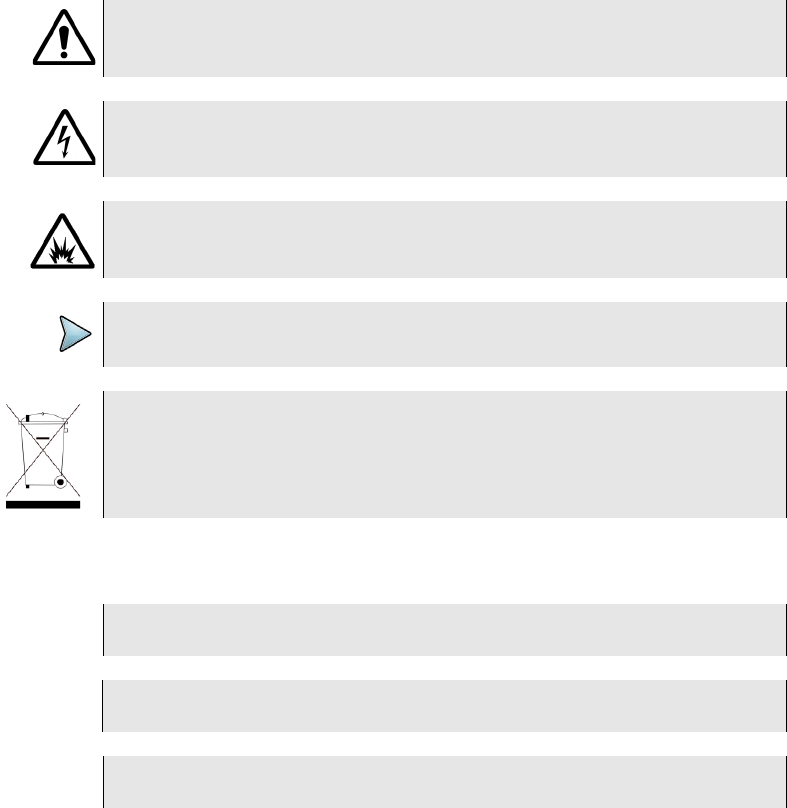
About this Guide
Conventions
SmartClass TPS User’s Guide
May 2014 22035456, Rev 001 xv
Table 1 Symbol conventions
Table 2 Safety definitions
This symbol represents a general hazard.
This symbol represents a risk of electrical shock.
This symbol represents a risk of explosion
This symbol represents a Note indicating related information or tip.
This symbol, located on the equipment, its battery, or its packaging indi-
cates that the equipment must not be disposed of in a land-fill site or as
municipal waste, and should be disposed of according to your national reg-
ulations.
DANGER Indicates an imminently hazardous situation which, if not avoided, will result
in death or serious injury.
WARNING Indicates a potentially hazardous situation which, if not avoided, could result
in death or serious injury.
CAUTION Indicates a potentially hazardous situation which, if not avoided, may result
in minor or moderate injury.
About this Guide
Conventions
SmartClass TPS User’s Guide
xvi 22035456, Rev 001 May 2014

1
SmartClass TPS User’s Guide 1
May 2014 22035456, Rev 001
Chapter 1
Getting Started
This chapter provides a general description of the SmartClass Triple Play Services. Topics
discussed in this chapter include the following:
–“Ship list” on page 2
–“Configurations and options” on page 2
–“Features and capabilities” on page 4
–“Preparation for use” on page 6
–“Exploring the front panel” on page 8
–“Exploring the connector panel” on page 11
–“Exploring the bottom panel” on page 12
–“Exploring the top panel” on page 13
–“Navigating the user interface” on page 13
–“Using the keypad” on page 16
–“Customizing the user interface” on page 17

Chapter 1 Getting Started
About the SmartClass TPS
SmartClass TPS User’s Guide
222035456, Rev 001 May 2014
About the SmartClass TPS
The SmartClass TPS is an all-in-one tool that fully test the access network (copper, fiber, POTS,
and ADSL2+/VDSL2 including bonded pairs) as well as broadband services (data, VoIP, and IP
video) so technicians can rapidly correlate and resolve triple-play service problems to potential
physical-layer causes.
The JDSU SmartClassTPS (<product name>) tester helps field technicians who roll out broadband
access networks and services deliver a pristine copper access infrastructure that can support triple-
play services and meet critical quality of service (QoS) and quality of experience (QoE) require-
ments.
This all-in-one DSL tester tool can test copper, fiber, asymmetrical and very high speed digital
subscriber lines including bonded VDSL2 pairs Internet Protocol (IP) data, voice over IP (VoIP), and
IP video with straightforward pass/fail results and detailed analysis of physical-and application-
layer-related problems.
The OneCheck and VideoCheck one button automated testing applications help technicians signif-
icantly reduce testing times and improves overall quality. The SmartClass TPS verifies the physical
health of the access copper loop, digital subscriber line (DSL) performance, and QoS/QoE of triple-
play services to ensure that field technicians have successfully completed the installation and repair
job. Operators and service providers can more quickly locate and repair faults and, thus, guarantee
their service quality.
Ship list
The SmartClass Triple Play Services typically ships in anti-static packing material to stabilize the
unit inside the box. The following are typical items that ship with the SmartClass Triple Play
Services:
– SmartClass Triple Play Services
– Universal Power Adapter — A power adapter designed specifically for the SmartClass Tester is
included. When supplying power to theSmartClass Tester using an adapter, you must use this
adapter. Additional AC line plug adapters are also included.
–Carrying Bag
– Rechargeable LiIon Battery Pack (installed)
– Ethernet Cable (CAT5 shielded RJ-45)
– RJ-45 DSL to 2-Telco Clips Cable
– Banana to 3-Clips Cable (only included if the unit includes the Copper option)
– Documentation USB. The User’s Guide is included as a PDF on the USB. Safety and compli-
ance information are provided separately, in printed format.
When unpacking the unit, verify that each of the standard items, and any optional items you
ordered, are included in the package.
Configurations and options
The SmartClass Triple Play Services is available in several configurations and software options are
available to enhance your instrument’s test capabilities.

Chapter 1 Getting Started
Configurations and options
SmartClass TPS User’s Guide
May 2014 22035456, Rev 001 3
Configurations
The SmartClass Triple Play Services is factory-configured to meet your testing requirements. When
you place an order for a SmartClass Triple Play Services, a customer service or sales representa-
tive will help you determine the right configuration for your needs.
Table 3 describes the available configurations for the BCM96368 modem.
Table 4 describes the available configurations for the BCM963168 modem.
Software options
You can order software options to add functionality to the SmartClass Triple Play Services. Table 5
lists the software options offered for the Triple Play Services.
To discuss a specific configuration or to order options and accessories for your SmartClass Triple
Play Services, contact JDSU Customer Care or your regional sales office. Contact information for
regional sales headquarters is provided on the back cover of this manual. You can also contact
JDSU through the company web site, www.jdsu.com.
Table 3 SmartClass Triple Play Services configurations for BCM96368
Catalog Number Configuration
CSC-TPSVW SmartClass TPS VDSL (Broadcom) with Wi-Fi
CSC-TPSVW-CU SmartClass TPS VDSL (Broadcom) with Wi-Fi and Copper
Table 4 SmartClass Triple Play Services configurations for BCM963168
Catalog Number Configuration
SCTPS-AB SmartClass TPS VDSL Mainframe (ANX A/B – VDSL 30a)
SCTPS-AB-CU SmartClass TPS VDSL/Copper Mainframe (ANX A/B –
VDSL 30a)
Table 5 SmartClass Triple Play Services software options
Catalog Number Option
SCTP-APP-REV01 Mobile App Connectivity (Revision 1) option
SCTP-HPNA HPNA Test option
SCTP-IPVIDEO Allows you to test IP Video services.
SCTP-MOS Mean Opinion Score (MOS) analysis option for VoIP
SCTP-SCCP VoIP Signalling option for Cisco SCCP
SCTP-VMOS Mean Opinion Score (MOS) analysis option for IP Video
SCTP-VOIP Allows you to place and receive calls using internet protocol
(IP), and analyze the call quality.
SCTP-WEB Allows you to view and navigate web sites using a DSL or
Ethernet interface.
SCTP-WIFI Wi-Fi Test option
SCTP-ANXB ADSL1/2/2+ Annex B Software Option

Chapter 1 Getting Started
Features and capabilities
SmartClass TPS User’s Guide
422035456, Rev 001 May 2014
Features and capabilities
Features and capabilities of the SmartClass Triple Play Services include the following:
xDSL
– Turn up and troubleshoot DSL services
– Provide packet statistics and analysis.
– Supports G.992.5
– Supports INP >2 (Impulse Noise Protection settings greater than 2)
– Compatibility with VDSL, ADSL2+, and ADSL1 service
– VDSL2 PTM Bonding
– VDSL2 ATM Bonding
– Supports Vectoring
– Supports SOS
– ADSL2+ ATM Bonding
– ADSL2+ PTM Bonding
– RE-ADSL support (Reach Extended ADSL2 - “Annex L”)
– Supports G.INP
– BPT, SNR, Hlog per tone, and QLN per tone graphs
IP Data
– IP layer testing over PPPoE, PPPoA, IPoA, and IPoE including:
– IP ping (IPoE and IPv6oE)
– FTP/HTTP throughput
– Trace route
– Terminate/Through Mode testing
– Web Browser
WiFi
Coax
– Testing with SmartID accessories
HPNA
VoIP
– Phone Emulation
– Voice conversation/generate tone/IP voice announce
NOTE:
The features available on your unit depend on which unit configuration was ordered and which
options are installed.
Chapter 1 Getting Started
Features and capabilities
SmartClass TPS User’s Guide
May 2014 22035456, Rev 001 5
– Auto answer mode
– Real-time packet metrics (delay, jitter, packet loss)
– E-model QoS and RTCP statistics
– User selectable CODEC
IP Video
–STB Emulation
– Monitor/Through mode
– IP Video QoX (QoS, QoE)
–VMOS
– RTP Loss Distance/Period
STB Boot Test
– Refer to the SmartClass Triple Play Services Tester Addendum to User Guide for STB Boot
Test (document number).
Optical Power
– Testing with the MP60 and MP-80 optical power accessories
Copper
– AC volts
– DC volts
– Resistance
– Leakage
– Distance to short
– Opens (distance) and capacitance
– DC current
–Balance
– Load coil detect
– Good ground test
– POTS calls
Ease of use
– Configurable User Interface
– Save test report to USB stick
– Sent test reports to a FTP server
– Job Manager
StrataSync
– Upload and share test results

Chapter 1 Getting Started
Preparation for use
SmartClass TPS User’s Guide
622035456, Rev 001 May 2014
– Upload and download configuration files
– Download and enable options
– Check and upgrade software updates
Mobile Device Application
– Support for iOS, and support for Android
– Remote control the SmartClass TPS
– Video Continuity Check from STB
– Technician support content (user manual, quick start guide, training videos, accessory guide)
Preparation for use
This section explains how to start using your SmartClass Triple Play Services.
General preparation
When you unpack the SmartClass Triple Play Services, do the following:
– Inspect the tester for damage.
– If undamaged, save the box and packing materials in case you need to ship the tester in the
future.
Before using the SmartClass Triple Play Services for the first time, do the following:
– Charge the battery.
– Turn the unit ON, and then verify that it is operating properly by navigating through a few
menus.
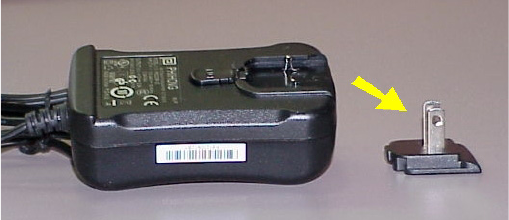
Chapter 1 Getting Started
Preparation for use
SmartClass TPS User’s Guide
May 2014 22035456, Rev 001 7
Changing the AC line plug fitting
The SmartClass Triple Play Services’s AC Adapter/Charger allows different AC line plug fittings.
To change the AC line plug fitting
1If an AC line plug fitting is already installed, do the following:
2Press and hold the button just below the fitting.
3Slide the fitting out of the slot.
4Select the appropriate AC line plug adapter.
5Slide the AC line plug adapter into the slot.
You will hear a click when the fitting is fully inserted.
The AC Adapter/Charger is ready for use.
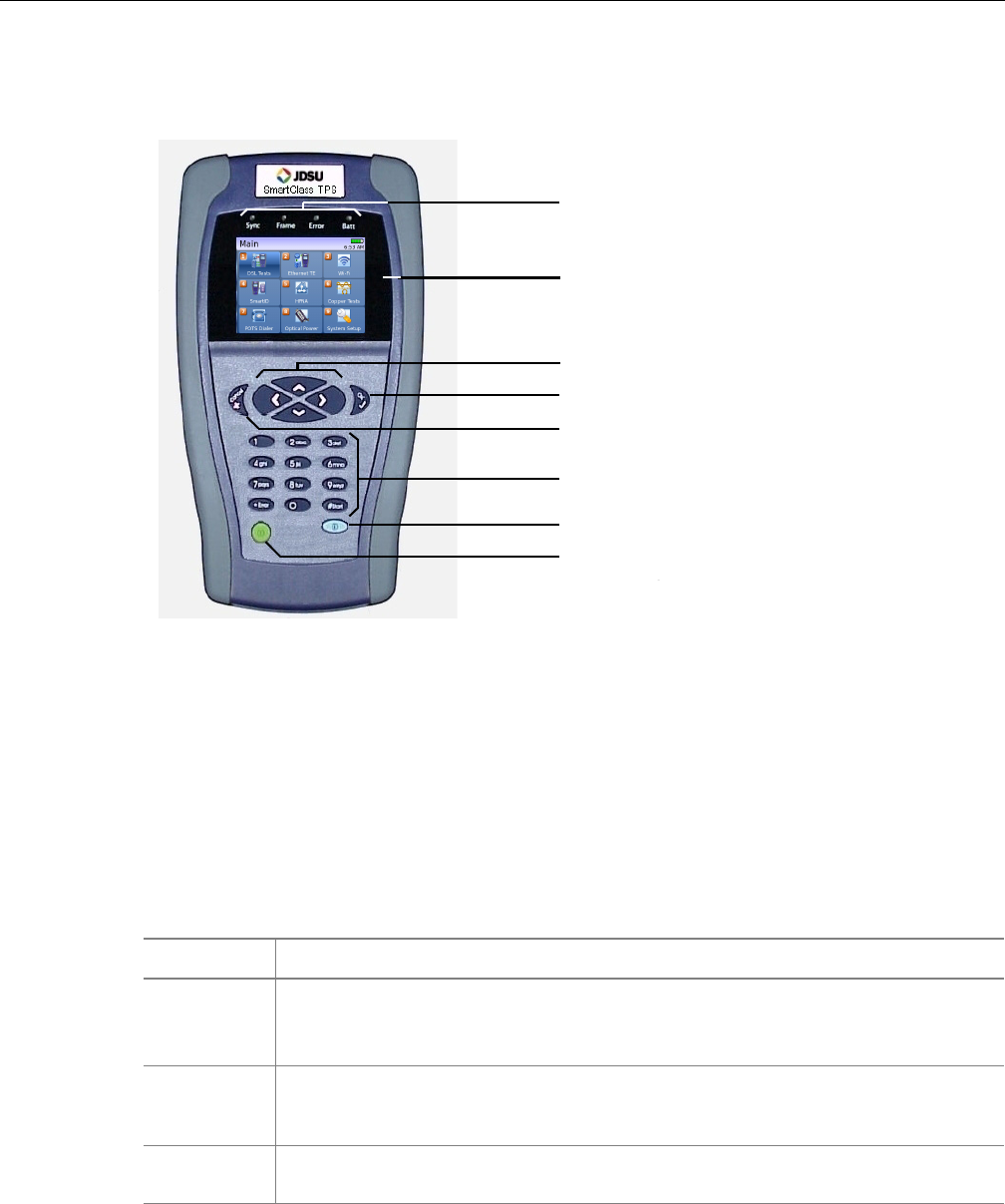
Chapter 1 Getting Started
Exploring the front panel
SmartClass TPS User’s Guide
822035456, Rev 001 May 2014
Exploring the front panel
The controls and LEDs on the SmartClass Triple Play Services front panel, shown in Figure 1, are
used to operate the unit, set up tests, and view data.
The following paragraphs describe each of the controls and LEDs on the front panel.
Status LEDs
The LEDs on the front panel report the status of the unit. The function of each LED is described in
Table 6.
Figure 1 SmartClass Triple Play Services front panel
Table 6 Status LEDs
LED Function
Sync Reports the status of modem synchronization.
– Flashing green indicates that the modem is training.
– Solid green indicates that the modem is synchronized.
Frame Reports the status of the data connection. Solid green indicates that a data connection
has been established with the network (so that the Triple Play Services may send and
receive data on the network).
Error Reports error and alarm conditions. Solid red indicates one of the following: CRC, LOF,
LOS, LOM, or LOF.
LCD
Status LEDs
Arrow keys
Power key
Keypad
OK key
Cancel key
Utility key

Chapter 1 Getting Started
Exploring the front panel
SmartClass TPS User’s Guide
May 2014 22035456, Rev 001 9
LCD
The LCD is a 320 x 240 pixel color display with contrast, brightness, and backlight controls.
Cancel key
Use the Cancel key to exit a menu and to return to the previous menu.
OK key
Use OK to accept a changed setting or to proceed to the next menu.
Arrow keys
Use the arrow keys to navigate through menu selections.
Keypad
Use the keypad to enter numbers, make menu selections, enter alphabetic characters, and so on.
Throughout the menus, the numbers associated with each function provide a quick way to perform
tests with simple number sequences.
Utility key
Use the Utility keyto view the Information menu, which gives access to additional menus.
The menus that display will vary depending on where within the menu structure you pressed the
Utility key. For example, when using the Web Browser, there are items specific to the browser, such
as previous page and refresh; or when testing DSL, and you press it when viewing the Hlog graph,
there is a selection to Calculate the Bridge Tap Length.
Batt A multi-color LED that indicates the battery status.
– Solid green indicates that an external source is powering the unit.
– Solid red indicates a low battery - 10% of battery life
(at 5%, the LED blinks to indicate that the unit will shut down soon if the adapter is
not plugged in).
– Solid amber indicates the battery is charging.
– The LED is off when the unit is running on battery power and the battery has suffi-
cient charge.
Information – displays the technical assistance phone number.
The phone number that appears depends on the Country setting you specified on the
International Settings menu. For example, if you set the country to Belgium, the JDSU
Germany phone number appears.
Home – returns to the main menu. NOTE: If you press this during a test, the test will
be stopped.
Table 6 Status LEDs (Continued)
LED Function

Chapter 1 Getting Started
Exploring the front panel
SmartClass TPS User’s Guide
10 22035456, Rev 001 May 2014
The available menus vary depending on the layout of the active menu when you press the Utility
key. Items 1 through 6 are always available. Items 7 and 8 are only available on list menus (tile
menus cannot be customized). For more detail on menus and layouts, see “Navigating the user
interface” on page 13.
Power key
Use the power key to turn the unit power on or off. Press and hold for 2 seconds to turn on.
Press to turn off, and then OK to confirm.
System Setup – a shortcut to the main System Setup menu. For more information on
this menu, see “Instrument Settings” on page 19).
Capture screen shot – saves the screen as a .png file.
(NOTE: The Utility menu itself cannot be captured this way. To capture the Utility
menu, remotely access the unit and capture it using the PrintScreen (PrtScn) key on
the PC.)
Report Settings – specify the filename, file format, report header information, and
other details related to the report.
Packet Capture – Shortcut to the Packet Capture menu, used to capture network
packets to a file on the SmartClass or to a file on a USB drive.
Outdoor Mode – changes the screen’s settings for better viewing outdoors.
Save To Job – launches the Save Test Result menu, allowing the results to be saved
to a specific job or saved to a file.
See “Saving results” on page 120.)
Menu Settings – customize the user interface. (For example, increase font size, move
menu item up or down in the list, and so on. See “Customizing the user interface” on
page 17.)
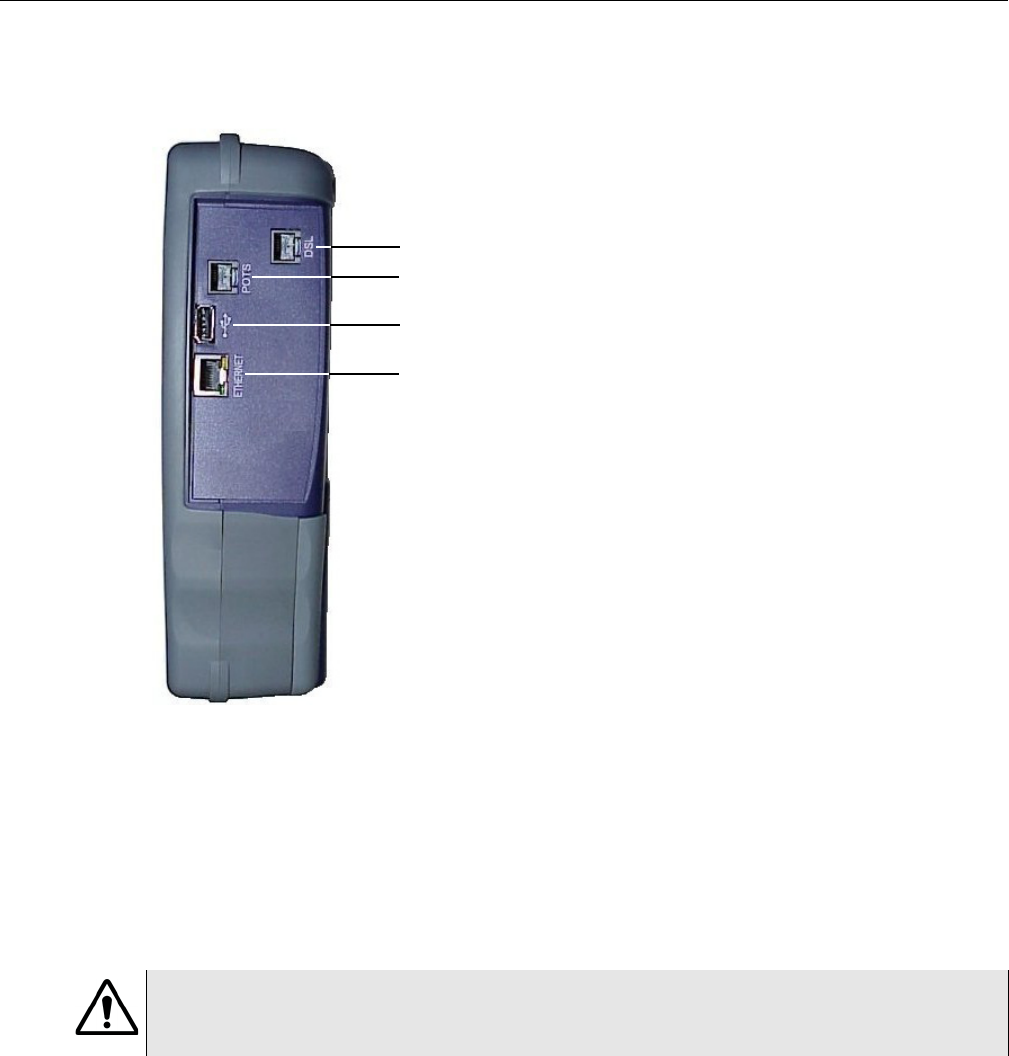
Chapter 1 Getting Started
Exploring the connector panel
SmartClass TPS User’s Guide
May 2014 22035456, Rev 001 11
Exploring the connector panel
The SmartClass Triple Play Services connector panel is used to connect to the line under test.
Figure 2 shows the connector panel.
The connector panel varies slightly depending on the configuration. The following paragraphs
describe each of the connectors on the right-side connector panel.
DSL connector
Use the 8-pin modular DSL jack when connecting to DSL circuits.
POTS connector
Use the POTS connector when placing or receiving POTS calls.
USB host connector
Use the USB host connector (USB 2.0) for saving results and configurations, or for firmware
updates.
Figure 2 SmartClass Triple Play Services connector panel
Ethernet connector
USB 2.0 connector
DSL line connector
POTS connector
CAUTION: FIRE HAZARD
To reduce the risk of fire, use only 26 AWG / 0.6mm or larger telecommunications line cord
between the DSL jack and the wall.
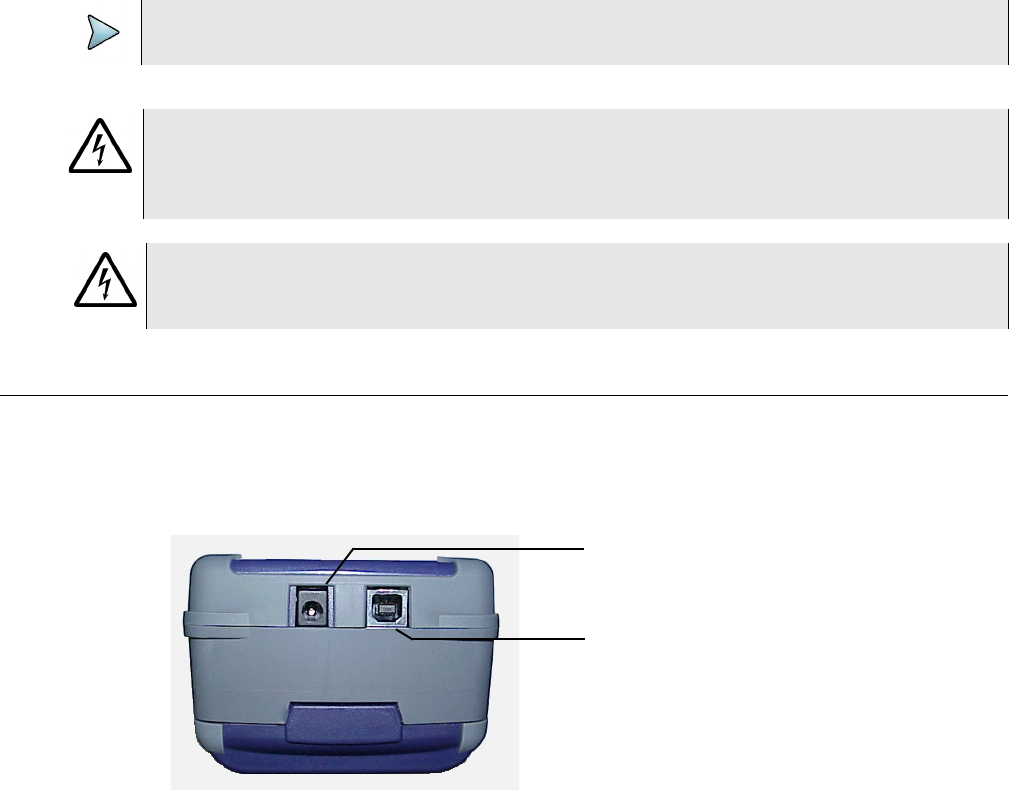
Chapter 1 Getting Started
Exploring the bottom panel
SmartClass TPS User’s Guide
12 22035456, Rev 001 May 2014
Ethernet connector
Use the Ethernet connector with an Ethernet cable when in either DSL through mode or Ethernet
TE mode.
Exploring the bottom panel
The SmartClass Triple Play Services’s AC Adapter/charger and USB device port are located on the
bottom panel.
NOTE:
The Ethernet port is auto configured to accept either a patch or cross-over cable.
WARNING: ELECTRICAL SHOCK
Electrical shock may result in serious injury or death. Use care when connecting to telecommuni-
cations circuits, to be sure that you do not come in contact with exposed conductors or power
mains. Connect TNV signals to TNV ports only.
NOTE: ELECTROSTATIC DISCHARGE IMMUNITY
When using an Ethernet crossover cable, JDSU recommends using a shielded crossover cable
for the best immunity to electrostatic discharge (ESD).
Figure 3 SmartClass Triple Play Services bottom panel
AC Adapter
USB device port
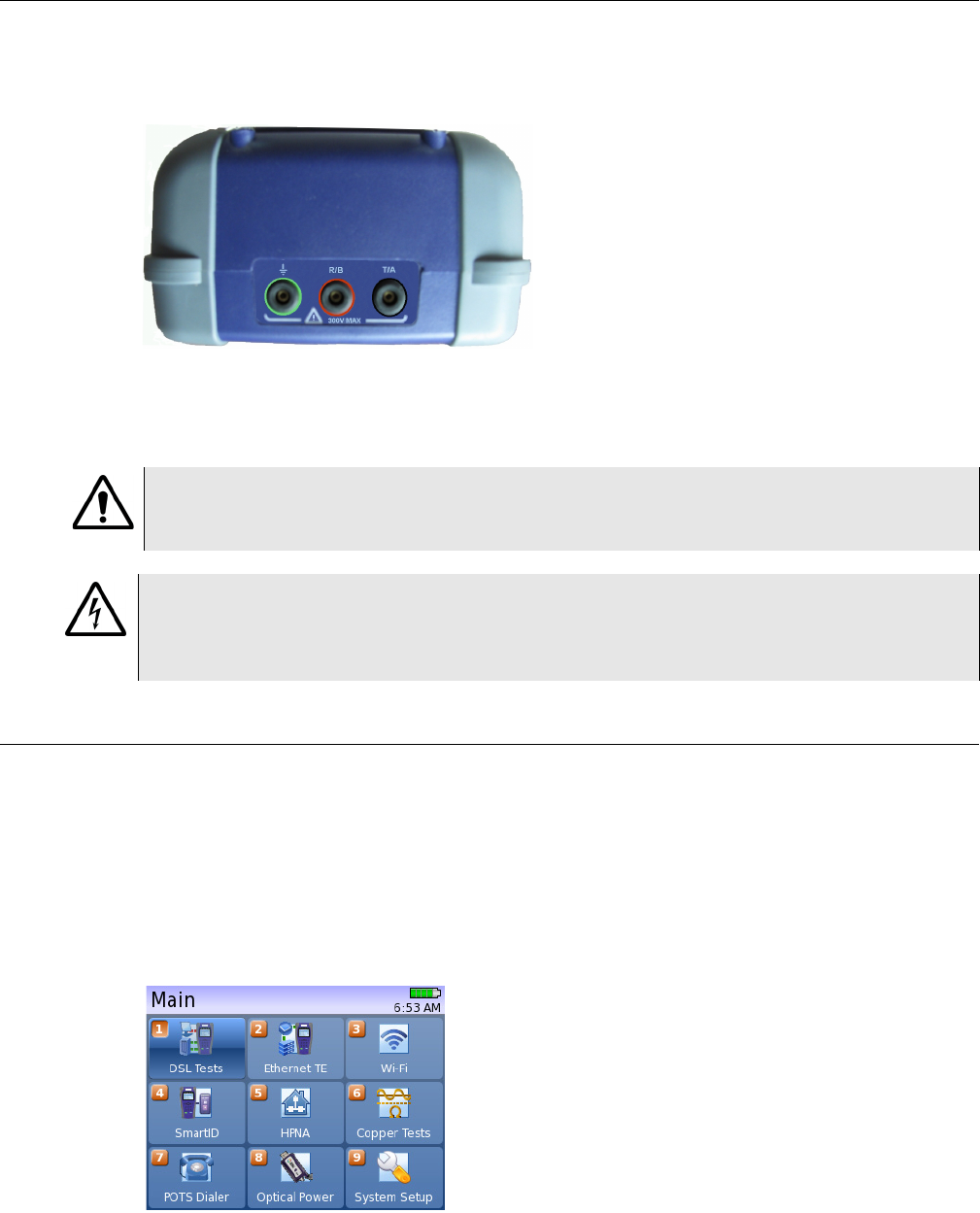
Chapter 1 Getting Started
Exploring the top panel
SmartClass TPS User’s Guide
May 2014 22035456, Rev 001 13
Exploring the top panel
If equipped with the Copper option, the top panel of the SmartClass Triple Play Services includes
three mini-banana jacks, as shown in Figure 4.
These are used to connect to Tip (A), Ring (B), and ground (sleeve or Earth).
Navigating the user interface
The user interface of the SmartClass Triple Play Services is designed to be intuitive and easy to
use. Using the LCD and keypad, you can view test results, set up the unit, and configure test param-
eters. This section describes the user interface, and explains how to navigate through the menus
and screens.
When you power up the SmartClass Triple Play Services, the user interface appears. Figure 5
shows the main menu.
The items on this menu vary, depending on the configuration and options.
Figure 4 SmartClass Triple Play Services top panel
CAUTION: INSTRUMENT DAMAGE
Connecting to circuits with voltage higher than 300V peak-peak, compared to ground, may dam-
age the internal components. Connect only to circuits with less than 300V.
WARNING: ELECTRICAL SHOCK
Electrical shock may result in serious injury or death. Use care when connecting to telecommuni-
cations circuits, to be sure that you do not come in contact with exposed conductors or power
mains. Connect TNV signals to TNV ports only.
Figure 5 SmartClass TPS Main Menu
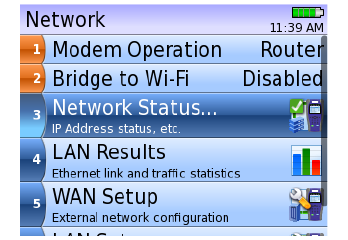
Chapter 1 Getting Started
Navigating the user interface
SmartClass TPS User’s Guide
14 22035456, Rev 001 May 2014
The upper right area of the main screen provides a quick status of the following:
– battery strength
– whether the adapter is being used (the lightning bolt)
–the time
There are two layouts of menus:
– Tile - the selections are on square tiles, as seen on the Main Menu (Figure 5)
– List - the selections appear in a list, as seen on the Network menu (Figure 6) or DSL Results
(Figure 7).
There are three types of screens on the user interface:
– Menu screens
– Data entry screens
– Results screens
Menu screens
Figure 6 illustrates a typical Menu screen.
Menus screens provide a series of selections that take you to another menu screen, a data entry
screen, or a results screen.
Figure 6 SmartClass Triple Play Services Menu screen (example)
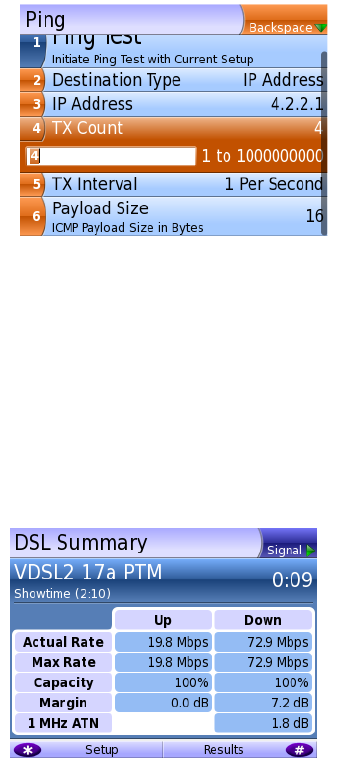
Chapter 1 Getting Started
Navigating the user interface
SmartClass TPS User’s Guide
May 2014 22035456, Rev 001 15
Data entry screens
Figure 7 illustrates a typical Data entry screen.
Data entry screens provide you selections to either choose from a list of options, or enter data using
the keypad. Use the up arrow to change the entry type (ABC is upper case, abc is lower case, 123
is numeric), or the down arrow to delete one character to the left.
Result screens
Figure 8 illustrates a typical Result screen.
These screens display test results or error logs. The results are split into categories. Press the arrow
keys to navigate among the results categories (screens).
Scroll bar
If a screen has more items than can be displayed, a scroll bar appears momentarily when you scroll
up or down among the items. While at the top or bottom of a menu, you can press and hold the up
or down arrow for one second to wrap back around (for example, at the bottom, hold the down arrow
to wrap up to the top).
Colors
The color of the menu item changes, depending on the type of menu: for data entry screens, the
item number is white in an orange background; for menu screens, the item number is white in a dark
blue background.
Figure 7 SmartClass Triple Play Services Data entry screen (example)
Figure 8 SmartClass TPS Result screen (example)

Chapter 1 Getting Started
Using the keypad
SmartClass TPS User’s Guide
16 22035456, Rev 001 May 2014
Ellipses
The ellipses ( ... ) character appears at the end of a highlighted menu item to indicate that this item
will take you to another screen (such as “Network Status...” in Figure 6 on page 14).
Using the keypad
Use the instrument’s keypad to enter alpha-numeric values, or to navigate to different screens by
specifying the menu number corresponding to the screen.
Selecting a menu option
There are two ways to select a menu option.
– Use the arrow keys to scroll to the desired option then press the OK key.
– Press the number associated with the menu option.
Specifying On/Off or Yes/No values
On a data entry screen you enter data or specify values. There are two ways to specify on/off or
yes/no values.
– Use the arrow keys to scroll to the desired option then press the OK key to toggle the value on
or off.
– Press the number associated with the menu option to toggle the value on or off.
Entering numeric values
To enter numeric values
1Use the arrow keys to scroll to and highlight the setting you want to specify.
2Press OK.
3Use the up arrow to change the entry type to numeric (123 in upper right area of screen).
4Use the keypad to type the numeric value.
Typing text
To type text
1Use the arrow keys to scroll to and highlight the setting you want to specify, and then press
OK.

Chapter 1 Getting Started
Customizing the user interface
SmartClass TPS User’s Guide
May 2014 22035456, Rev 001 17
2Use the keypad to type the text.
– Repeated presses scroll through the selections for that key. For example, repeatedly
pressing the 2 key will scroll through A, B, C
and 2.
– To enter special characters, use either the asterisk/star or pound/hash key until the desired
character appears.
The same characters are available with both keys, but they scroll in opposite directions. This
is helpful if you scroll past the desired character because you can go back using the other
key rather than scrolling all the way back around.
– To cycle through upper/lower case and numeric entry, press the up arrow. This is indicated
in the upper right area of the screen with “abc, ABC, or 123”.
– Use the down arrow to backspace (delete one character to the left).
– To move to the next field, either wait one second for the cursor to jump, or use the right
arrow key.
– If you move the cursor between characters, typing characters will insert new characters at
that location. To append characters, position the cursor at the end of your text, after the last
character.
Using a USB keyboard
If you connect a USB keyboard to the instrument, you can use it to navigate the menus and control
the instrument.
– Use the arrow keys to navigate.
– Use the numbered keys to select a menu item or for entering numbers.
– Use Enter as the OK key.
– Use Esc as the Cancel key.
– Use F5 key as the Utility key.
Customizing the user interface
The Utility key allows you to customize the user interface. For example, you can move more impor-
tant menu items up to the top of the screen, increase the font size, hide less important items, and
so on. Note: this feature is only available on list menus (tile menus cannot be customized).
To customize the interface
1Navigate to the menu you wish to customize.
2Press the Utility key, and then select Edit Menu.
Chapter 1 Getting Started
Customizing the user interface
SmartClass TPS User’s Guide
18 22035456, Rev 001 May 2014
3Choose one of the following:
– Increase Font Size
– Decrease Font Size
– Move Item Up
– Move Item Down
– Make Hidable (This will hide the menu item and a “Show More” line will appear at the
bottom of the screen to show the hidden items.)
To unhide the item, return to the hidden menu item, press the Utility key, press 8, and then
select “Show Always”.
If a selection is greyed out, it is not available. For example, if Decrease Font Size is greyed out,
the font is at the smallest size allowed.
4Continue with steps 1 through 3 until the interface is customized as desired.
5Optional. To return the user interface to factory defaults, press the Utility key, and then select
Restore Menu.

2
SmartClass TPS User’s Guide
May 2014 22035456, Rev 001 19
Chapter 2
Instrument Settings
This chapter describes how to configure the basic system settings of the instrument. Topics
discussed in this chapter include the following:
–“Managing files” on page 20
–“Managing jobs” on page 21
–“Communicating with a mobile device” on page 23
–“Accessing the SmartClass Triple Play Services remotely using VNC” on page 24
–“Setting the date and time” on page 25
–“Specifying auto power down settings” on page 26
–“Adjusting the screen settings” on page 27
–“Changing keypad setup” on page 27
–“Specifying the volume level” on page 28
–“Specifying international settings” on page 28
–“Managing test configurations” on page 29
–“Viewing unit revisions, options, and IDs” on page 30
–“Restoring factory defaults” on page 30
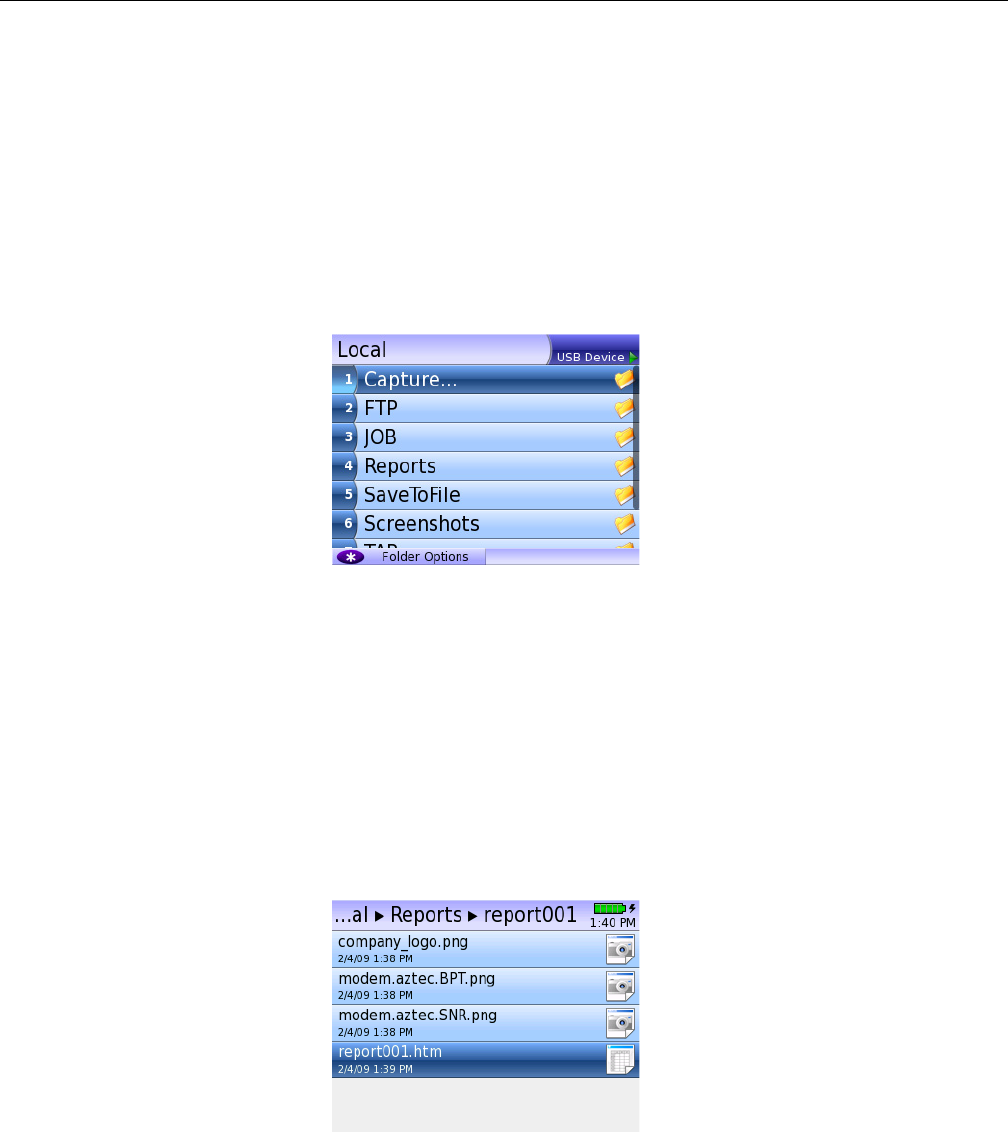
Chapter 2 Instrument Settings
Managing files
SmartClass TPS User’s Guide
20 22035456, Rev 001 May 2014
Managing files
The File Manager enables you to open, copy to unit, or delete files or folders either on the internal
filing system or a USB flash drive.
To manage files
1From the Main menu, select System Settings, and then select File Management.
2Select File Browser.
If you have a USB memory stick inserted, an additional menu appears to browse Local files or
the USB device.
A list of folders appears.
3Use the asterisk (*) key to view the file or folder options.
–To copy file or folder/directory, do the following:
aPress the * key to view the options.
bPress the 1 key to copy.
cNavigate to the desired location (where you want to paste the file/folder).
dPress the # key to paste the directory.
This is only available if you have copied a file or folder.
–To view files inside a folder, highlight a folder and then press OK. A list of files appears.
A screen shot or logo will have a camera icon, report files will have an icon that looks like a
spreadsheet.
–To open a file, navigate to the desired file, press the OK key.
The contents of the file appear.

Chapter 2 Instrument Settings
Managing jobs
SmartClass TPS User’s Guide
May 2014 22035456, Rev 001 21
–To copy a file or entire folder to a USB stick, navigate to the desired file or folder, press the *
key, and then select Copy to USB. The file or folder is copied. If no USB stick is inserted, the
selection will not be selectable; the number will not have a box around it and the text will be
grey.
–To rename a file or folder, navigate to the desired file or folder, press the * key, and then select
Rename. A box appears to enter the new name. Enter the name, and then press OK.
The new file or folder name appears in the list.
–To transfer your test reports to a server, navigate to the desired file or folder, press the * key,
and then select Send to Remote Server. A setup screen appears to specify the server address
and directory, as well as the login and password. Press # to send the file. Note: This will typi-
cally be a company-provided server that you are given access to.
–To delete a file or entire folder, navigate to the desired file or folder, press the * key, and then
select Delete. An acknowledgement screen appears. Press OK to delete.
Managing jobs
The Job Manager is used to associate test results from different applications to a single job.
Tests supported:
– DSL test (sync)
– OneCheck (DSL, Ethernet TE, and Wi-Fi Network)
–Wi-Fi Scan test
– SmartID test
– HPNA Network test
– CableCheck for Copper Pair Test
– Optical Power Meter test
If any jobs have been saved, they appear in the list. The Job Manager allows you to setup a new
job, edit an existing job, activate a job, or delete a job.
Creating and editing jobs
To create a new job or edit an existing job
1From the System Settings menu, select Job Manager.
2Select Job Management.
The Job Manager screen appears. If any jobs have been created, they will be listed on the
screen.
3Do one of the following:
– To create a new job, press the * key.
– To edit an existing job, highlight the job, and then press OK.
The Job Edit screen appears.

Chapter 2 Instrument Settings
Managing jobs
SmartClass TPS User’s Guide
22 22035456, Rev 001 May 2014
4Navigate to the field to edit, and then enter the information.
The new or updated job appears on the list.
Activating a job
To activate a job
1On the Job Manager screen, highlight the job to activate, and then press the OK key.
The Job Edit menu appears.
2Verify the job details and modify the details if needed.
3Press the * key to activate.
The Job Management Menu appears.
Exporting a job
To export a job
1From the Job Manager menu, select Job Export.
The Job List appears.
2Press the * key to verify the Job Export Server settings, and update if necessary.
3On the Job List menu, highlight the job you wish to export, and then press the * key. Repeat
this step for any additional jobs you wish to export.
The job will be exported as a XML file.
The job is exported, and then the Utilities Menu is displayed.
Deleting a job
To delete a job
1On the Job Management screen, highlight the job to delete, and then press the # key.
2A confirmation box appears. Press the OK key.
Repeat for each desired job.
The job is deleted.
NOTE:
Newly created jobs are automatically activated.
NOTE:
Once a job has been successfully uploaded to the job server, the job is deactivated and locked
(i.e., cannot edit the ticket number or other fields). The next job must be a new ticket. This
ensures that the correct test data is being saved and exported with the correct job. The check
box next to the job will be greyed out.
If additional test results must be saved to an exported job, that job can be reactivated. Then,
when the job is exported, the job file will include the new saved test results appended to the end
of the previously saved file.

Chapter 2 Instrument Settings
Communicating with a mobile device
SmartClass TPS User’s Guide
May 2014 22035456, Rev 001 23
Associating test results to a job
After running your test, you can associate the results to the job using the “Save to job” feature.
See“Saving results to a job” on page 120.
Communicating with a mobile device
Using an app on the mobile device (such as an iPad), you can connect to a SmartClass and control
the user interface.SmartClass TPS supports mobile device applications on both iOS and Android.
Before connecting to the mobile device, configure the SCTriple Play Services to communicate with
the mobile device.
To setup the SmartClass to communicate with the mobile device
1From the System Settings menu, select Remote Access.
2Select Wi-Fi Interface.
3Press OK to toggle Disabled to Enabled.
4Press the * key to configure the Wi-Fi setup.
To change a setting, use the arrow keys to highlight the item, and then press the OK key to
edit.
aSpecify the Wi-Fi Access Point settings.
bIf needed, specify the WAN Network Setup (see “Specifying WAN settings” on page 54).
After specifying the SmartClass TPS setup, you can control it with the mobile device.
See “Using the SmartClass TPS with a mobile device” on page 35.
NOTE:
In order to use this feature, the Mobile App Connectivity software option is required.
Setting Description
Wi-Fi Mode Specify Access Point (AP).
SSID The Service Set Identifier is the public name of a wireless
network.
HW Mode Specify whether the wireless network is using 802.11b,
802.11g, or 802.11n
Channel Specify which channel to connect to.
Security Specify the type of security used on the network.

Chapter 2 Instrument Settings
Accessing the SmartClass Triple Play Services remotely using VNC
SmartClass TPS User’s Guide
24 22035456, Rev 001 May 2014
Accessing the SmartClass Triple Play Services remotely using VNC
The Remote Access features allows you to access the SmartClass Triple Play Services user inter-
face from a PC or laptop computer through a virtual network connection (VNC), connecting over an
Ethernet interface, Wi-Fi interface, or DSL interface.
To use this feature, you must have a VNC viewer installed on the PC or laptop, the SmartClass
Triple Play Services must be connected to the same network and subnet as the PC or laptop, and
you must know the IP address of the SmartClass Triple Play Services.
The VNC program can control the following functions:
– You can do a ping, trace route and FTP tests, but be careful that changes do not affect your
VNC connection.
– For VoIP and Video, VNC is not recommended.
– Results may not match the expected results.
To access the SmartClass Triple Play Services remotely
1Using an Ethernet cable, connect the SmartClass Triple Play Services to same Ethernet LAN
as the PC or laptop you will use for the VNC.
2Turn the Remote Operation feature On by doing the following:
aFrom the System Settings menu, select Remote Access.
bSelect the desired interface.
cPress OK to toggle Disabled to Enabled.
3Configure the network setup to match your Ethernet, Wi-Fi, or DSL network.
4Establish the VNC connection.
aLaunch VNC viewer.
bIn the viewer’s server address field, type the SmartClass Triple Play Services's IP
address, and then select OK.
The SmartClass Triple Play Services user interface appears in the VNC viewer.
NOTE:
VNC over Ethernet and DSL are always available (standard); VNC over Wi-Fi is only supported
if the Mobile App Connectivity SW option is enabled.
TIP:
If the message, “Failed to connect to server” appears, the VNC viewer was not able to communicate with
the SmartClass Triple Play Services. If this happens, try the following solutions:
– Make sure you are using the correct IP address for the SmartClass Triple Play Services.
– From the PC or laptop, ping the SmartClass Triple Play Services IP address to verify the network link
is working. If the link is not working, restart the SmartClass Triple Play Services and repeat step 2
through step 4.

Chapter 2 Instrument Settings
Setting the date and time
SmartClass TPS User’s Guide
May 2014 22035456, Rev 001 25
5Use the computer’s mouse or keyboard to control the SmartClass Triple Play Services.
Table 7 shows how the PC/laptop keys map to the SmartClass Triple Play Services keypad.
– To enter data (for example, entering a DNS name for a traceroute), use the arrow keys or
mouse to scroll to and highlight the setting to specify, and then press Enter. Use the keyboard
to type the text.
6To end a remote operation session, on the PC or laptop running the VNC viewer, end the VNC
session.
Table 8 shows the constraints for using the remote access feature.
Setting the date and time
The SmartClass Triple Play Services has an internal clock that you can set to provide accurate time
stamps for test results.
Setting the date
The following procedure describes how to set the date.
To set the date
1Select System Settings from the Main Menu.
2Select Hardware Settings, and then Date and Time.
Table 7 PC/laptop to SmartClass Triple Play Services key map
PC/Laptop key SmartClass Triple Play Services Keys
Arrow keys Arrows
Escape Cancel
Enter OK
F5 Utility
Table 8 Remote access support
Test
Remote Access
Wi-Fi Ethernet DSL
DSL with data Supported Not Available Not Available
Ethernet Test with data Supported Supported Not Available
Wi-Fi Scan Not Available Supported Supported
Wi-Fi EP with data Not Available Not Available Not Available
Wi-Fi AP Not Available Supported Not Available
HPNA Supported Not Available Not Available
Copper Supported Supported Not Available
SmartID Supported Supported Supported
Optical Power Meter Supported Supported Supported

Chapter 2 Instrument Settings
Specifying auto power down settings
SmartClass TPS User’s Guide
26 22035456, Rev 001 May 2014
3Select Date.
4Enter the current month, day, and year (or day, month, and year) in numerical form.
5Press the OK key.
The date is set.
Setting the time
The Date and Time menu allows you to set the time of day, as well as the time format (12 hour or
24 hour).
The following procedure describes how to set the time.
To set the time
1Select System Settings from the Main Menu.
2Select Hardware Settings, and then Date and Time.
3Select Time.
4Enter the current hour, minutes, and seconds.
Use the arrow keys to move among each field.
5Press the OK key.
The time is set.
The following procedure describes how to specify the time format.
To specify the time format
1Select System Settings from the Main Menu.
2Select Hardware Settings, and then Date and Time.
3Select Time Format.
4Choose 12 Hour or 24 Hour display.
5Press the OK key.
The time format is specified.
Specifying auto power down settings
The Power Management menu allows you to view the battery level, as well as set the time to wait
before the unit turns off to conserve battery.
To specify auto power down settings
1Select System Settings from the Main Menu.
NOTE:
The date format changes automatically when you change the Country setting on the International
Settings menu. For example, the date April 2, 2004 would appear as 4/2/2004 when the country
is set to United States but would appear as 2/4/2004 when the country is set to Germany.

Chapter 2 Instrument Settings
Adjusting the screen settings
SmartClass TPS User’s Guide
May 2014 22035456, Rev 001 27
2Select Hardware Settings, and then Power Management.
The Power Setup menu appears, showing the battery level and the current power off delay.
3Select Power Off Delay to set the power off delay.
This is the amount of time to wait (in minutes) after a keypress or no line activity before power
down.
The auto power down settings are specified.
Adjusting the screen settings
The Screen Settings menu allows you to adjust contrast and brightness.
To adjust the screen settings
1Select System Settings from the Main Menu.
2Select Hardware Settings, and then Screen Setup.
3To change the screen for better viewing outdoors, select Outdoor Screen Mode.
4Select the setting you wish to adjust: Contrast, Brightness, or Backlight.
5Change the level using the up or down arrow key, followed by the OK key.
6Optional. To make more precise adjustments, select Show More, and then select Red
Contrast, Blue Contrast, Red Brightness, or Blue Brightness.
The screen settings are adjusted.
Changing keypad setup
Using the Keypad menu, you can set the repeat delay and repeat rate.
Setting the repeat delay
The following procedure describes how to set the repeat delay. This setting defines the time to wait
after a key is held down until it begins to repeat. You can set the delay from 0.5 up to 10 seconds,
in 0.1 second increments.
To change the repeat delay
1Select System Settings from the Main Menu.
2Select Hardware Settings, and then Keypad Setup.
3Select Auto Repeat Delay.
4Change the level using the arrow keys, followed by the OK key.
The repeat delay is set.
Setting the repeat rate
The following procedure describes how to set the repeat rate. This setting defines how many times
the character will be repeated per second.

Chapter 2 Instrument Settings
Specifying the volume level
SmartClass TPS User’s Guide
28 22035456, Rev 001 May 2014
To change the repeat rate
1Select System Settings from the Main Menu.
2Select Hardware Settings, and then Keypad Setup.
3Select Auto Repeat Rate.
4Change the level using the arrow keys, followed by the OK key.
The repeat rate is set.
Specifying the volume level
The Volume Setup menu allows you to adjust the handset volume.
To specify the volume level
1Select System Settings from the Main Menu.
2Select Hardware Settings, and then Volume Setup.
3Select Handset Volume to specify the volume played through the built-in speaker.
The volume level is set.
Specifying international settings
The International Settings menu allows you to change the language of the user interface and
specify the measurement units.
To specify international settings
1Select System Settings from the Main Menu.
2Select Administration, and then International Settings.
3Select the setting you wish to change:
– Language–changes the language of the user interface.
– Country–automatically sets the units based on the country.
The countries available will change depending on the language. For example, if you change
the language to Français, countries such as France and Canada are listed and there will be
no English speaking countries listed (for example, United Kingdom and Australia). The only
exception is English; all countries are listed when English is selected.
Other changes that happen automatically based on country include:
the cable pair names (from Tip, Ring, Ground to A, B, and E) and the technical assistance
phone number.
– Units–changes the measurement units (metric or imperial).
The international settings are specified.

Chapter 2 Instrument Settings
Managing test configurations
SmartClass TPS User’s Guide
May 2014 22035456, Rev 001 29
Managing test configurations
After you specify settings for a configuration, you can store the configuration for future use, or load
a saved configuration.
Saving test configurations
You can define and store configurations using your most common settings, and then load an
existing configuration and edit the settings as needed for your current test.
To save test configurations
1Specify the settings for the configuration.
2Select System Settings from the Main Menu, and then File Management.
3Select Save Setup, and then do one of the following:
– To save as a new configuration, select New.
– To overwrite a previously saved configuration, navigate to the desired configuration file, and
then press OK.
The test configuration is stored.
Loading a configuration
After you save a configuration, you can load it at any time to run a test using the configuration
settings.
To load a test configuration
1Select System Settings from the Main Menu, and then File Management.
2Select Load Setup.
3Scroll to the desired file name to load, and then press OK.
The test configuration is loaded.
NOTE:
If you change a setting, it is not automatically saved. You must either save the configuration
again and overwrite the previous settings, or create a new configuration.
NOTE:
Configurations cannot be loaded while a test is running. Load the configuration before testing.
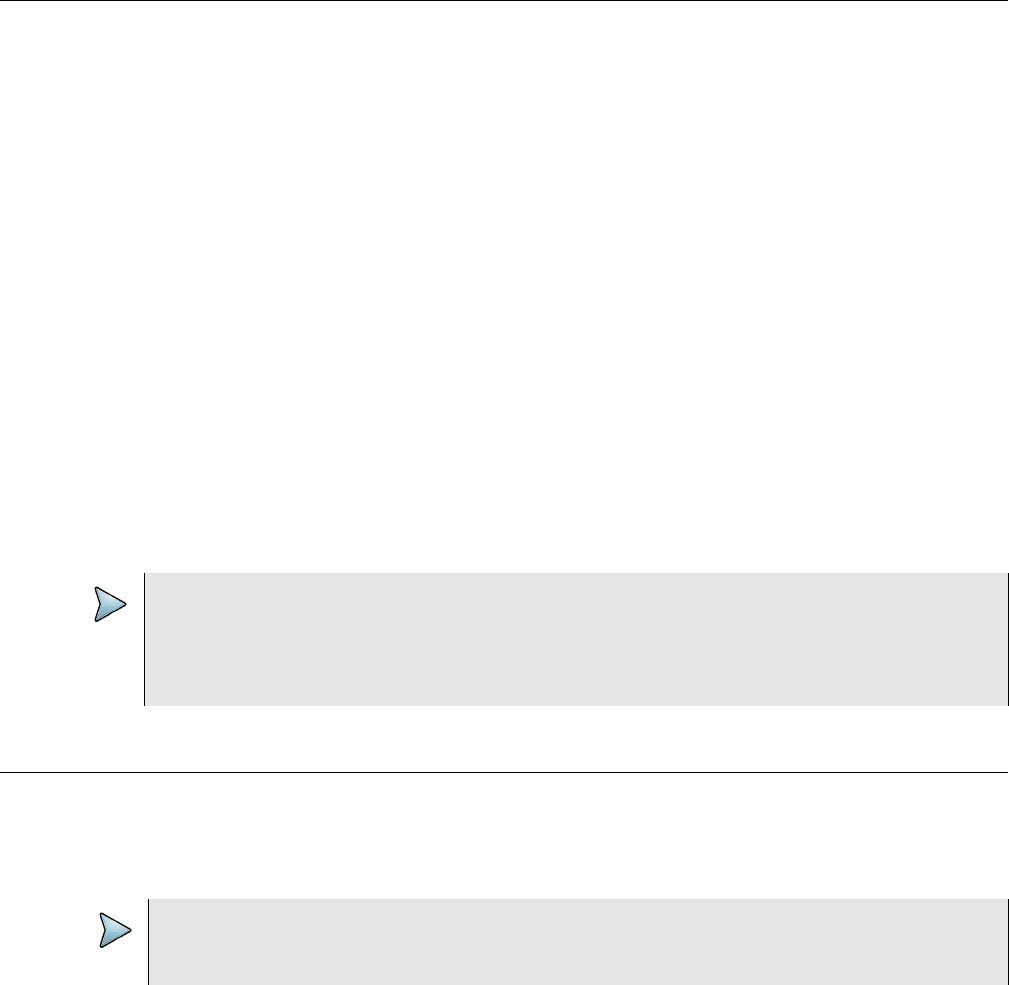
Chapter 2 Instrument Settings
Viewing unit revisions, options, and IDs
SmartClass TPS User’s Guide
30 22035456, Rev 001 May 2014
Viewing unit revisions, options, and IDs
The Options and Revisions screens provide the software and hardware versions and list the
installed options.
To view the installed options
1Select System Settings from the Main Menu, and then Administration.
2Select Options.
A list of current options appears and indicates whether the option is installed on your unit.
The unit’s unique Hardware ID number also appears on this screen. You will need this ID if you
are adding options to the unit. For more information, see “Adding options” on page 149.
To view the unit revisions
1Select System Settings from the Main Menu, and then Administration.
2Select Revisions.
The system software version appears.
3To view more detailed information for a specific component, select System Information,
Modem Information, or Copper Board Information (if the copper board is installed).
This will report the hardware type and rev and the software rev of each component.
Restoring factory defaults
The following procedure describes how to reset the SmartClass Triple Play Services to factory
default settings.
To reset to factory defaults
1Select System Settings from the Main Menu.
2Select Restore Settings.
A confirmation menu appears.
3Press the OK key to reset the defaults or Cancel to keep the current settings.
After resetting, the unit reboots.
NOTE:
The PHY Rev that is displayed on the Modem Information screen varies depending on which
application you are running when you entered the menu. For DSL applications, the rev is dis-
played but is different based on single line versus bonded and ADSL versus VDSL. The PHY rev
is not displayed when you are in the Copper or Ethernet TE application.
NOTE:
Restoring factory defaults will reset test application settings and system settings (such as con-
trast and language). It does NOT change or delete stored configurations or saved results.

3
SmartClass TPS User’s Guide
May 2014 22035456, Rev 001 31
Chapter 3
Automated Testing
This chapter provides information on using the automated tests (automated sequence of tests, also
called “scripts”) to verify connectivity, upload and download rates, or to verify the video channels.
The following topics are discussed in this chapter:
–“About the automated tests” on page 32
–“Running the OneCheck test” on page 32
–“Running the VideoCheck test” on page 34

Chapter 3 Automated Testing
About the automated tests
SmartClass TPS User’s Guide
32 22035456, Rev 001 May 2014
About the automated tests
The SmartClass Triple Play Services includes two automated tests:
OneCheck — Allows triple play testing by running a DSL, Ethernet, or Wi-Fi test to verify network
connectivity and upstream/downstream thresholds, a ping test to verify data layer connectivity, a
FTP or HTTP test to verify data upload and download rates, a video test (as described in the video
check below), and a VoIP test. Then the test reports pass/fail results.
VideoCheck — Verifies whether all channels are available as ordered by the subscriber. The test is
included as a part of the OneCheck test, but can be run as a separate test when only the Video layer
needs to be verified.
Running the OneCheck test
The OneCheck test is an automated sequence of tests. The test runs a DSL, Ethernet, or Wi-Fi test
to test connectivity and upstream/downstream thresholds, a ping test to verify connectivity, a FTP
test to verify upload and download rates, a video test to verify the channels are provisioned as the
subscriber requested, and a VoIP test to verify call placement and QoS thresholds.
To run the OneCheck test
1Launch the desired application: DSL, Ethernet, or Wi-Fi.
2Select OneCheck.
The OneCheck menu appears. From this menu, you can start the test sequence or go to the
setup menus for each test.
3To select which tests to run, either highlight the test and then press OK, or press the number
for that test to toggle enabled or disabled.
The only exception is VoIP. Select VoIP and then specify how the OneCheck script will place
the VoIP call:
– Automatic – automatically place a call
– Manual – display the VoIP call screen and wait for you to initiate the call manually
– Disable – don’t run the VoIP test
4To specify the test settings, press the key, and then select which test to setup.
aSelect DSL Setup, and then specify the following:
–Group Thresholds - pass/fail thresholds for upstream connection rate, max up rate, down-
stream connection rate, and max down rate. The Group Thresholds only appear when
testing in Bonded modes.
–Upstream Thresholds - pass/fail thresholds for upstream connection rate, max rate,
margin, and LATN (for ADSL) or 1MHz attenuation (xDSL).
–Downstream Thresholds - pass/fail thresholds for downstream connection rate, max rate,
margin, and LATN (for ADSL) or 1MHz attenuation (xDSL or VDSL).
NOTE:
DSL Setup is only available if testing over DSL. If testing over Ethernet or Wi-Fi, this selection
will not appear.
Chapter 3 Automated Testing
Running the OneCheck test
SmartClass TPS User’s Guide
May 2014 22035456, Rev 001 33
–DSL Setup - specify the Sync Timeout (the time to wait for synchronization to occur before
timing out), and then if needed, specify the other DSL settings as described in “Specifying
test settings” on page 49.
bSelect Network Setup, and then specify the settings as described in “Specifying the
network setup” on page 42.
cSelect Ping Setup, and then specify the pass/fail settings for replies lost, average ping
time, and max ping time. If needed, also specify the settings as described in “IP Ping
testing” on page 62.
dSelect File Transfer Setup, and then specify the following:
– Pass/Fail thresholds for upload rate and download rate.
– FTP/HTTP Test Setup as described in step 1 of “Throughput testing” on page 64
eSelect Video Setup, and then specify the following:
– Channel List - import the video channel list.
Use this menu to import the .txt file (tab delimited) that contains the channel list. It can be in
one of the following places:
the TestSetup\VideoCheck directory on the unit or on a USB stick,
the TestSetup directory on a USB stick,
or the root directory of a USB stick.
By default, the channellist.xls template is located in the root directory on the unit (/cust/
public). Copy that file, update it, save as a .txt file (tab delimited), and then import it as
mentioned above.
– IGMP Version - specify the version of IGMP signaling being used on the circuit: version 2 or
version 3.
– Concurrent video streams - specify the number of streams to test simultaneously, up to
three.
– Test duration - specify the amount of time to test each video stream. Selecting 0 seconds
will only verify that we can connect to the video stream. QoS values will not be gathered.
– QoS Thresholds - specify the thresholds as described in step 3 of “Specifying test settings”
on page 97. The pass/fail result based on these thresholds will be included in the test,
unless the test duration is zero seconds.
fSelect VoIP Setup, and then specify the following:
– Number to call - On the General Setup menu, enter a phone number to dial.
– Call duration - On the General Setup menu, specify the length of time to leave the call up.
– All other settings as described in “Specifying test settings” on page 86
gPress Cancel to return to the OneCheck menu.
5Press the # key to Start the test.
The test begins. The test may take several minutes.
As the test runs, the status and results of the test are displayed.
A check mark indicates pass; an “X” indicates fail, an exclamation point indicates a marginal
result.
The test stops automatically when complete.
For more information on the other results, see Chapter 16 “Test Results”.
6To save a test report, press the utility (i) key and then select Save Report or Save To Job, and
then specify the report settings such as report name, report format, technician ID, location,
and other settings as needed.

Chapter 3 Automated Testing
Running the VideoCheck test
SmartClass TPS User’s Guide
34 22035456, Rev 001 May 2014
Running the VideoCheck test
The VideoCheck test is used to verify the channels are provisioned as the subscriber requested.
To run the VideoCheck test
1Launch the desired application: DSL, Ethernet, or Wi-Fi.
2Select VideoCheck.
The VideoCheck menu appears. From this menu, you can start the test sequence or go to the
setup menu.
3If you haven’t already specified the settings, press the key to do so. See step e above.
4Press the # key to Start the test.
The test begins.
As the test runs, the status and results of the test are displayed. A check mark indicates pass;
an “X” indicates fail, an exclamation point indicates a marginal result.
The test stops automatically when complete.
5View the results.
The following table describes the VideoCheck results.
To view details for a specific stream, highlight the stream/channel, and then press OK.
Details are available for loss, jitter, error ind, join latency, leave latency, and channel settings
such as IP address and stream type.
For more information on the other results, see Chapter 16 “Test Results”.
6To save a test report, press the utility (i) key and then select Save Report or Save To Job, and
then specify the report settings such as report name, report format, technician ID, location,
and other settings as needed.
Result Description
Ch The channel index number. It should match the channel ID configured in the channel
list.
Name The channel name. It should match the channel name configured in the channel list.
Status The status of the stream.
Media wait - evaluating the status
Stream up - stream is under test
Available or Unavailable - status after test is done.
QoS A pass/fail indication of the quality of the stream. It only appears if the stream is avail-
able and the test duration is more than zero seconds.

4
SmartClass TPS User’s Guide
May 2014 22035456, Rev 001 35
Chapter 4
Using the SmartClass TPS
with a mobile device
This chapter provides task-based instructions for using the optional app that is available for mobile
devices. Topics discussed in this chapter include the following:
–“Controlling the SmartClass with a mobile device” on page 36
–“Controlling the device interface” on page 37
–“Testing with SmartIDs” on page 37
–“Viewing video on a mobile device” on page 39
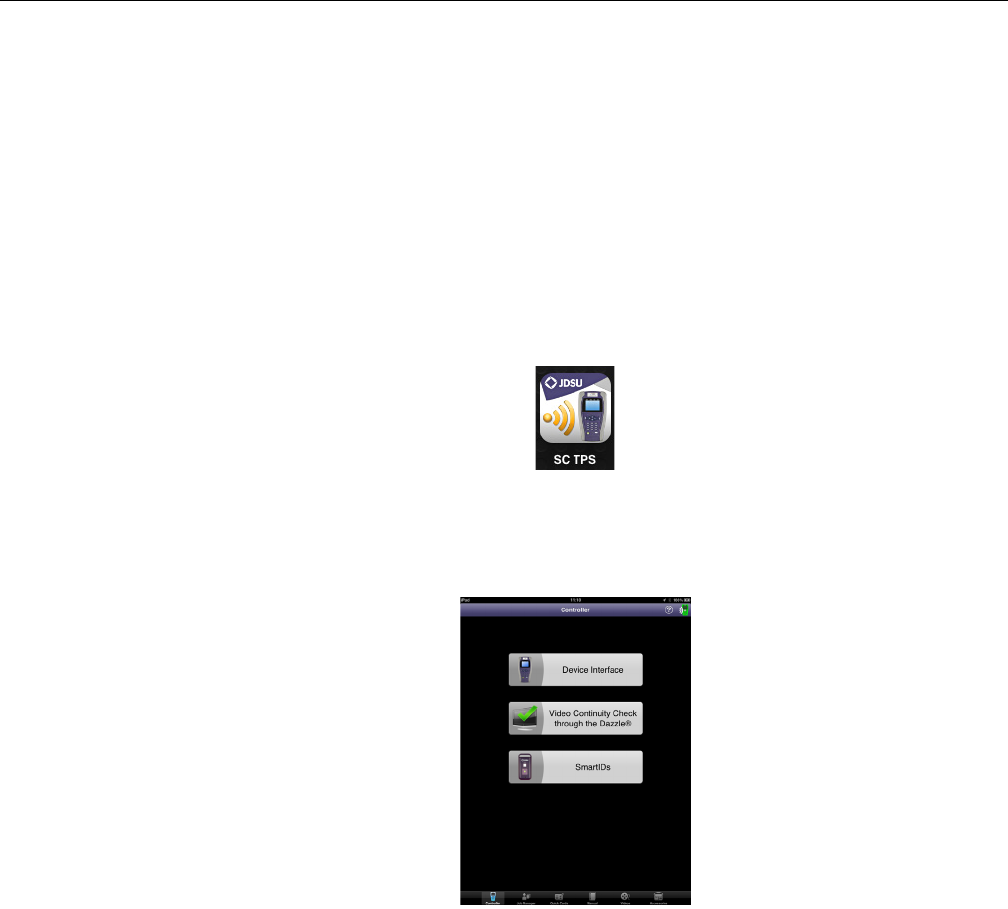
Chapter 4 Using the SmartClass TPS with a mobile device
Controlling the SmartClass with a mobile device
SmartClass TPS User’s Guide
36 22035456, Rev 001 May 2014
Controlling the SmartClass with a mobile device
Using an app on the mobile device, you can connect to a SmartClass and control the user interface.
SmartClass TPS supports mobile device applications on both iOS and Android.
To control the SmartClass with a mobile device
1To configure the SmartClass TPS as a Wi-Fi access point for the mobile device, see “Commu-
nicating with a mobile device” on page 23.
2Setup the mobile device to connect to the <product name>’s Wi-Fi network.
aGo to the Settings menu.
bSelect Wi-Fi and find the SSID for the SmartClass that you wish to connect to.
3On the mobile device, launch the SCTPS app.
The Controller page appears.
From this page, you can select whether to control the <product name> user interface, check video
with Dazzle, or test with SmartIDs.
Across the bottom, icons are available for:
– Controller page–the screen above, allows control of the user interface, launching a video
check, and testing with SmartIDs (see “Controlling the device interface”, “Viewing video on a
mobile device”, and “Testing with SmartIDs”)
– Job Manager–used to manage test results
– Quick Cards–view quick cards (short documents of instructions)
– Manual–read the manual
– Videos–view instructional videos
– Accessories–view the guide for the accessories
For iOS mobile device, if you are controlling the <product name> using an iPhone instead of an
iPad, the screen will appear slightly different: the SmartID app is replaced with the Job Manager
(SmartID tests are only available on the iPad and Job Manager is not an icon at the bottom).
For Android device, the SmartClass TPS GUI is very similar to that of the iOS mobile device.
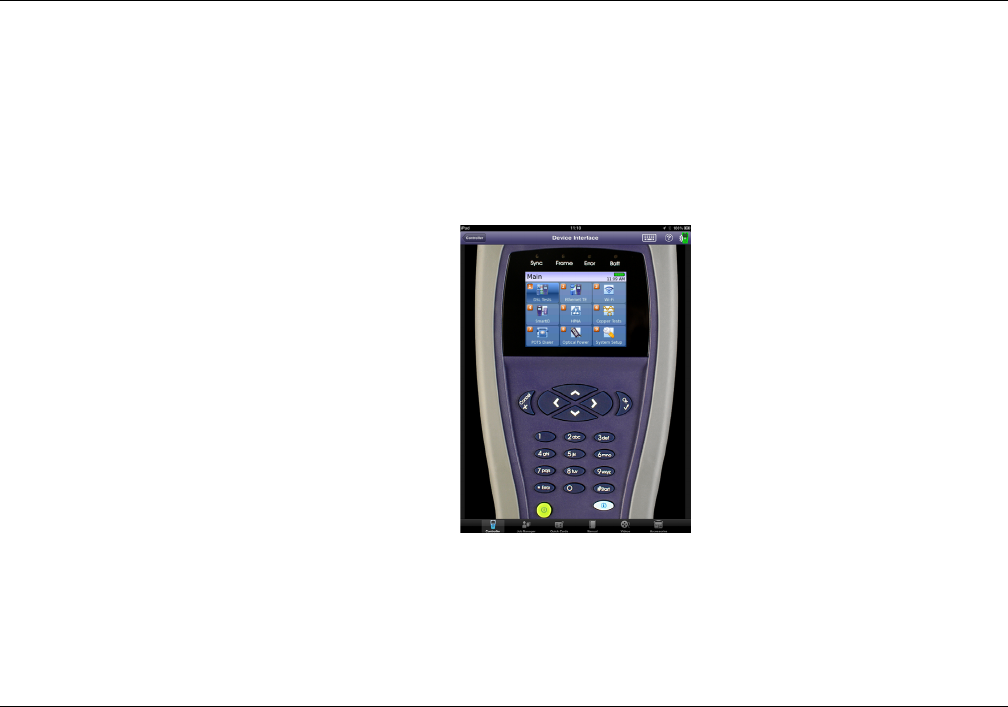
Chapter 4 Using the SmartClass TPS with a mobile device
Controlling the device interface
SmartClass TPS User’s Guide
May 2014 22035456, Rev 001 37
Controlling the device interface
From the mobile device (such as an iPad), you can run tests on the <product name>.
To control the device interface
– On the Controller page select Device Interface.
The SmartClass TPS interface appears on the mobile device. You can now control the device
as if you were pressing the actual buttons on the device.
You can run most of the tests that are available on the SmartClass TPS. See Ta bl e 8 “Remote
access support” on page 25.
To return to the main Controller page, select the Controller button in the upper left.
Testing with SmartIDs
The mobile device app allows you to test with SmartIDs.
To test with SmartIDs
1On the main Controller page select SmartIDs.
The <product name> goes into remote control mode and the mobile device screen displays
the Locate SmartID page.
You can now use either the instrument’s user interface or the SmartID App in the main
Controller page to run the Good Home Check.
To return to the main Controller page, select the Controller button in the upper left.
2To locate SmartIDs, tap Start Scan
The progress bar at the top will indicate Scanning...

Chapter 4 Using the SmartClass TPS with a mobile device
Testing with SmartIDs
SmartClass TPS User’s Guide
38 22035456, Rev 001 May 2014
The located SmartIDs appear in the left pane. If a SmartID is registered with the <product
name> but not located, it will be in the left page as Registered but will be greyed out.
3Optional. Specify the location and equipment type for each SmartID.
aSelect the letter of the SmartID in the left pane.
bTap Location in the right pane, and then select a location (Living Room, Kitchen, etc.).
cTap Equipment Type in the right pane, and then specify the type of equipment (RG, STB,
computer, phone, etc.).
The picture of the equipment updates to show the equipment selected.
4To run other tests, in the top center area of the screen, tap Test.and then select the type of
test.
As the test progresses, the screen updates indicating the status of each part of the test.

Chapter 4 Using the SmartClass TPS with a mobile device
Viewing video on a mobile device
SmartClass TPS User’s Guide
May 2014 22035456, Rev 001 39
After the test finishes, the results are displayed.
For more information on testing with SmartIDs, see Chapter 10 “SmartID Testing”.
Viewing video on a mobile device
SmartClass TPS provides a means to display video ouput from a set-top box. This is useful for
installations where the customer’s television is not yet accessible but the video service must be veri-
fied.This test uses a device such as the Dazzle® to view the video.
To view video on the mobile device
1If you haven’t already done so, launch the SCTPS app.
2Connect the Dazzle device to the RGB video outputs on the STB.
3Connect the output side (USB) of the Dazzle device to the USB port of the SmartClass TPS.
4Configure the SmartClass TPS as a Wi-Fi access point and connect the mobile device to the
SmartClass TPS. See “Communicating with a mobile device” on page 23.
5From the mobile device’s Controller screen, select Video Continuity Check through the
Dazzle.
The MPEG stream from the Dazzle USB output is streamed through the SmartClass TPS to
the iPad.
6View the video in the mobile device application.

Chapter 4 Using the SmartClass TPS with a mobile device
Viewing video on a mobile device
SmartClass TPS User’s Guide
40 22035456, Rev 001 May 2014
NOTE:
This is not a video analysis. It is only passing the raw uncompressed video from the RGB output
from the STB. The image may not be of high quality due to the uncompressed nature from which
the video is being retrieved from the STB output and being sent thru the SmartClass TPS over
the Wi-Fi link to the mobile device. This is useful for verifying the presence (or lack) of video
when there is no television present. If service issues are suspected on the STB receiver, be sure
to use other testing and troubleshooting methods on the physical layer that is supplying the STB.

5
SmartClass TPS User’s Guide
May 2014 22035456, Rev 001 41
Chapter 5
Ethernet TE Testing
This chapter provides task-based instructions for using the Ethernet TE testing features of the
SmartClass Triple Play Services. Topics discussed in this chapter include the following:
–“About Ethernet TE testing” on page 42
–“Specifying the network setup” on page 42
–“Connecting to the line” on page 44
–“Viewing results” on page 45

Chapter 5 Ethernet TE Testing
About Ethernet TE testing
SmartClass TPS User’s Guide
42 22035456, Rev 001 May 2014
About Ethernet TE testing
In Ethernet TE mode, you can use the Triple Play Services to emulate Ethernet terminal equipment
by connecting to an Ethernet LAN or to the Ethernet port on the customer's modem. After
connecting to the circuit, you can then test for connectivity and throughput.
You can also ping through the modem to a network switch or web address to test for connectivity.
To select Ethernet TE mode
– From the Main Menu, select Ethernet TE.
The Ethernet TE menu appears.
The Ethernet TE test involves the following steps:
– Specifying test settings
– Connecting to the line
– Performing tests
– Viewing results
Specifying the network setup
Before you begin testing, make sure the test settings on the Triple Play Services match the settings
of the line that you are testing.
To specify test settings
1From the main application menu, select Network.
2Select Network Setup, and then specify the settings.
Configuring the settings can be done one of two ways:
– Press a number on the key pad that corresponds to the setting you want to configure.
– Use the arrow keys to highlight the setting you want to change, and then press the OK key.
Press the Cancel key to exit a menu.
CAUTION: FAULTY RESULTS
Any time the Network settings are changed, the network layer resets. If you change these set-
tings during a test, you may cause errors in the test. Only change them before you begin a test.

Chapter 5 Ethernet TE Testing
Specifying the network setup
SmartClass TPS User’s Guide
May 2014 22035456, Rev 001 43
The following table describes the settings.
Setting Description
Data Mode Select the data mode.
IPoE is IP over Ethernet
PPPoE is PPP over Ethernet
Multi-VLAN is multiple VLAN; multiple Virtual LANs are used on this net-
work. In this mode, the SmartClass Triple Play Services assumes that the
networks that are accessed via each VLAN are unique, and thus provides
access to a different range of IP addresses. A typical scenario would be
one VLAN for Internet data, another VLAN for Voice, and another VLAN for
Video.
IPv6oE is IPv6 over Ethernet.
To review the basic differences in IPv4 vs. IPv6, see “About data testing” on
page 62
IPv6 Multi-VLAN is multiple VLAN over IPv6 (up to 3 VLANs).
Interface Count If Multi-VLAN Data Mode is used, specify the number of VLAN interfaces,
up to three.
VLAN x Setup (or
IPv6 VLANx Setup)
If Multi-VLAN Data Mode is used, specify the settings for each LAN. On this
menu, the Client Mode specifies the data mode for the VLAN. Other setup
items appear depending on the Client (Data) Mode (such as Use DHCP
Vendor ID, or Username and Password). You must also define a purpose
for IPv4 VLANs 2 and 3 (Internet, Video, or Voice).
MAC Addr. Mode If IPoE or PPPoE Data Mode is used, specify whether the MAC is the fac-
tory default or user defined.
VLAN If IPoE or PPPoE Data Mode is used, specify whether VLANs are used.
VLAN ID If VLAN is On, specify the VLAN ID.
VLAN Priority If VLAN is On, specify the VLAN Priority.
IP Mode (IPv4) If IPoE Data Mode is used, select either Static or DHCP (dynamic host
configuration protocol) mode.
IP Addr. (IPv4) If the IP Mode is Static, enter the IP address that the tester will use.
IP Netmask (IPv4) If the IP Mode is Static, enter the net mask address.
Gateway (IPv4) If the IP Mode is Static, enter the gateway address.
DNS Server If the IP Mode is Static enter the address of the DNS server.
Use DHCP Vendor ID Select Yes or No to whether to use the vendor ID.
This is only available if you selected DHCP as the “IP Mode”.
DHCP Vendor ID Enter the Vendor ID.
This is required if you selected Yes for “Use DHCP Vendor ID.”
Use User Class Select Yes or No to whether to use the User Class.
This is only available if you selected DHCP as the “IP Mode”.
DHCP User Class Enter the User Class.
This is required if you selected Yes for “Use User Class.”
IPv6 Mode If IPv6oE Data Mode is used, select DHCPv6 (stateful configuration per
RFC 3315) Stateless (auto-configuration per RFC 2462), or Manual mode.
DHCPv6 Option If using IPv6oE and the mode is DHCP, specify whether IA PD (prefix dele-
gation) is used.

Chapter 5 Ethernet TE Testing
Connecting to the line
SmartClass TPS User’s Guide
44 22035456, Rev 001 May 2014
If you are connecting over WiFi
You are finished specifying the network setup.
Connecting to the line
After specifying the test settings, you can connect to the line.
To connect to the line
1Connect one end of an Ethernet cable to the Ethernet jack on the right side of the unit.
2Connect the other end of the cable to an Ethernet jack.
Global Addr. If using IPv6oE and the IPv6 Mode is Manual, specify the global IPv6
address.
Local Address Mode If the IPv6 Mode is Manual, specify whether the local address mode is
automatic or manual.
IPv6 Local Address If the IPv6 Mode is Manual, and the Local Address Mode is Manual, specify
the local address.
Subnet Prefix Length If you selected Manual IPv6 mode, specify the length of the subnet prefix,
from 0 to 128.
IPv6 Gateway If using IPv6oE and the IPv6 Mode is Manual, enter the gateway address.
DNS Mode If you selected Stateless IPv6 Mode, specify the DNS Mode: Manual or
DHCPv6. This determines whether DHCP will be used to get the DNS
server address.
PPP Username Enter a valid user name.
This must be a valid user account with an ISP.
PPP Password Enter the user password.
This must be a valid password that matches the user name above. Pass-
words are often case-sensitive.
PPP Use Provider Select Yes or No.
This option indicates whether to append the user name with the service
provider domain name (for example, earthlink.net). Select Yes only if user
names for the ISP must include the domain name as part of the user name.
This setting automatically appends the @ sign for you.
PPP Provider Enter the provider name.
This is required if you selected Yes for “Use Provider.”
PPP Use Service
Name
Select Yes or No to whether to use the Service Name.
PPP Service Name Enter the Service Name.
This is required if you selected Yes for “Use Service.”
Login Mode Specify whether to automatically or manually login. If set to manual, the
data synchronization will not occur until you login.
Setting Description

Chapter 5 Ethernet TE Testing
Viewing results
SmartClass TPS User’s Guide
May 2014 22035456, Rev 001 45
Viewing results
After specifying test settings and connecting to the line, you can view results.
To view results
1Do one of the following:
– Press the Cancel key to return to the Network menu, and then select Network Status or
LAN Stats.
– From the Network Setup menu, press the left arrow to move to the LAN Results menu, and
then the left arrow again to move to the Network Status menu.
2To save a test report, press the utility (i) key and then select Save Report, and then specify
the report settings such as report name, report format, technician ID, location, and other
settings as needed.
3To clear the results, use the asterisk (*) key.
See Chapter 16 “Test Results” to learn what your results mean.
Chapter 5 Ethernet TE Testing
Viewing results
SmartClass TPS User’s Guide
46 22035456, Rev 001 May 2014

6
SmartClass TPS User’s Guide
May 2014 22035456, Rev 001 47
Chapter 6
DSL Testing
This chapter provides task-based instructions for using the SmartClass Triple Play Services to
gather DSL (VDSL, ADSL2+/2/1) statistics and verify connectivity. Topics discussed in this chapter
include the following:
–“About xDSL testing” on page 48
–“Selecting the test mode” on page 49
–“Specifying test settings” on page 49
–“Testing the physical layer” on page 58
–“Testing line quality” on page 58
–“Terminating the loop (SELT)” on page 60

Chapter 6 DSL Testing
About xDSL testing
SmartClass TPS User’s Guide
48 22035456, Rev 001 May 2014
About xDSL testing
The purpose of the DSL tests are to assess the quality of the xDSL signal and to verify the xDSL
rates achieved at various points in the network.
The tests involve three main steps:
– selecting the test mode and specifying test settings
– connecting to the line
– running the tests
The SmartClass Triple Play Services supports two types of modems - the classical BCM96368
modem and the new BCM963168 modem.
BCM96368 test options
The classical BCM96368 modem supports an optional bonded modem emulate mode, where the
SmartClass replaces a bonded modem (terminates the line instead of the CPE). The options avail-
able for purchase are as follows:
Refer to Table 3 on page 3 for the corresponding catalog numbers.
BCM963168 test options
The new BCM963168 modem features in supporting Single channel ADSL Annex A and Annex B,
as well as Single channel VDSL up to 30a. It does not support the bonded modem emulate mode.
The option available for purchase is as follow:
Refer to Table 4 on page 3 for the corresponding catalog numbers.
For additional information about SmartClass Triple Play Services options and services, contact
your local JDSU representative or contact JDSU through the company web site, www.jdsu.com.
Table 9 DSL testing options for BCM96368
Option Description Order Number
ADSL Bonded Bonded mode for ADSL SCTP-ADSL-BONDED
VDSL Bonded Bonded mode for VDSL SCTP-VDSL-BONDED
Table 10 DSL testing options for BCM963168
Option Description Order Number
ADSL1/2/2+ Annex B ADSL1/2/2+ Annex B Software Option SCTP-ANXB

Chapter 6 DSL Testing
Selecting the test mode
SmartClass TPS User’s Guide
May 2014 22035456, Rev 001 49
Selecting the test mode
Before running any DSL tests, you must specify the test mode and specify test settings.
To select the test mode
1From the main menu, select DSL Test.
2Select the test mode.
For the BCM96368 modem, you can select from:
– ADSL/VDSL (Single Pair)
– VDSL Bonded (Two-Pair)
– ADSL Bonded (Two-Pair)
–xDSL SELT
For the BCM963168 modem, you can select from:
– xDSL (ANX A)
– xDSL (ANX B)
–xDSL SELT
3Specify test settings. See “Specifying test settings” on page 49.
Specifying test settings
Before you begin testing, make sure the test settings on the SmartClass Triple Play Services match
the settings of the line that you are testing. The following settings typically must be set:
– Modem operation
– DSL settings
– WAN Network settings
– LAN Network settings
Configuring the settings can be done one of two ways:
– Press a number on the key pad that corresponds to the setting you want to configure.
– Use the arrow keys to highlight the setting you want to change, and then press the OK key.
Press the Cancel key to exit a menu.
TIP:
Test configurations can be stored for easy recall and use (see “Managing test configurations” on
page 29).
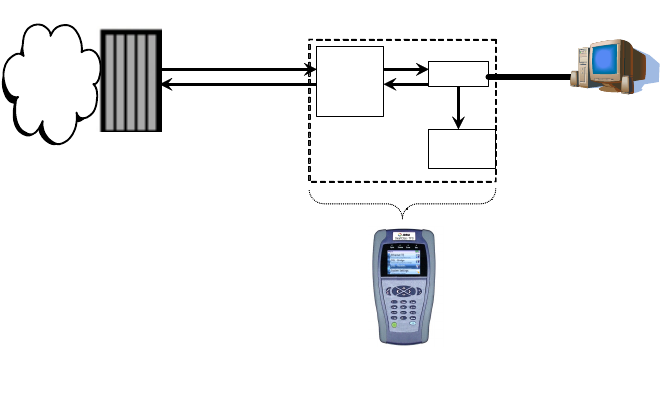
Chapter 6 DSL Testing
Specifying test settings
SmartClass TPS User’s Guide
50 22035456, Rev 001 May 2014
Specifying the modem operation
The test settings that you must specify will vary depending on the modem operation mode. You
should specify the modem operation mode first.
To specify the modem operation mode
1For the BCM96368 modem: from the ADSL/VDSL menu, select Network.
For the BCM963168 modem: from the xDSLmenu, select Network.
2Specify the Modem Operation (Router or Bridge).
The SmartClass Triple Play Services can test DSL services in two modes: DSL-Bridge and
DSL-Modem/Router. They include the same testing capabilities, but the difference is in the IP
addressing.
In DSL-Modem/Router mode, the SmartClass Triple Play Services replaces the modem,
router, and test interface. As the router, it stops the service provider’s IP on the network side
and assigns private IPs to equipment on the customer side, as shown in Figure 9 on page 50.
Figure 9 DSL-Modem/Router circuit
Customer Premise
SmartClassTPS
in DSL -
Modem/Router mode
Modem
DSLAM
NETWORK
Test
interface
Router
Ethernet
Service Provider IP ,
for example 10.1.1.x
Private IP, for
example 192.168 .x.x
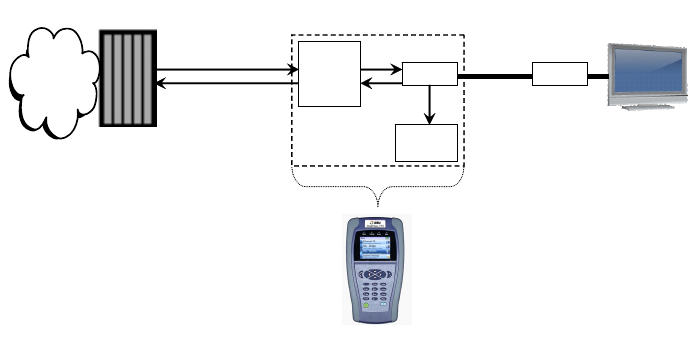
Chapter 6 DSL Testing
Specifying test settings
SmartClass TPS User’s Guide
May 2014 22035456, Rev 001 51
In DSL-Bridge mode, the SmartClass Triple Play Services replaces the modem, hub, and test
interface. It does not use a DHCP server so it does not assign IP addresses to other equip-
ment. The end equipment uses either the service provider-supplied IP address or one that is
on the same network (same netmask). See Figure 10 on page 51.
To test in DSL Terminate Mode, use Bridge Mode as it allows VLAN tags to be assigned. To
use IPv6 (IPv6oE or IPv6 Multi VLAN), Bridge mode should be used.
3Optional -Specify Ethernet Router. You do not need to perform this step if not to replace the
bridge running on Ethernet interface with a router.
You can select Ethernet Router and enable the router between the DSL interface and the
Ethernet interface. Note this is another router in addition to that in Figure 9 on page 50. Using
the Router Mode the SmartClass TPS will work as the router for the devices connected
through the Ethernet port. Not using the Router Mode it will work as a bridge.
4Press Cancel to return to the previous menu.
The modem operation mode is specified.
Figure 10 DSL-Bridge circuit
Customer Premise
SmartClass TPS
in DSL-Bridge mode
Modem
DSLAM
NETWORK
Test
interface
Hub
Ethernet
Service Provider IP,
for example 10.1.1.x
10.1.1.x
STB

Chapter 6 DSL Testing
Specifying test settings
SmartClass TPS User’s Guide
52 22035456, Rev 001 May 2014
Specifying DSL settings
The settings vary depending on whether testing on a single line or bonded.
Specifying DSL (single line) settings
To specify DSL test settings
1From the ADSL/VDSL menu, select DSL.
The DSL Summary results menu appears.
Press the asterisk (*) to view the Setup menu.
2Select xDSL Standard and then choose ADSL, VDSL, Auto, or Incremental. Auto will query
the DSLAM for the standard. Incremental will cycle through a period of broadcast sequences
to the DSLAM, going from VDSL to ADSL and then repeating.
3If you specified ADSL as the DSL standard, do the following:
aSelect Operation and then select Over POTS or Over ISDN.
bSpecify the ADSL Modulation standard in use.
–Auto will revert to ADSL2 if the line doesn’t support ADSL2+ or revert to G.DMT if line
doesn’t support ADSL2. Select Auto if using Annex M.
– Annex M
–G.DMT
– G.Lite (only available if Operation is Over POTS)
–ADSL2
– ADSL2+
– T1.413 (only available if Operation is Over POTS)
cSelect Transport Mode and then choose the transport.
ATM specifies Asynchronous Transfer Mode. PTM specifies Packet Transfer Mode. Auto will
query the DSLAM for the transport mode.
4If you specified VDSL as the DSL standard, do the following:
aSelect Operation and then select Over POTS or Over ISDN.
bSpecify the VDSL Profile profile (for example, 8a, 12b, and so on).
–Auto will query the DSLAM for the profile.
–8a
–8b
–8c
–8d
–12a
–12b
–17a
–30a
NOTE:
You may not see all of the settings above. The available selections vary,
depending on the configuration and installed options.

Chapter 6 DSL Testing
Specifying test settings
SmartClass TPS User’s Guide
May 2014 22035456, Rev 001 53
cSelect Transport Mode and then choose the transport.
ATM specifies Asynchronous Transfer Mode. PTM specifies Packet Transfer Mode. Auto will
query the DSLAM for the transport mode.
5Select G.INP Setup and then specify whether the unit will advertise upstream or downstream
G.INP support to the DSLAM. If the selection is changed, the modem resyncs in order to apply
the new setting.
6Select Vector Mode and then select Full, Friendly, or Off.
Vectoring technology is used on VDSL2 connections to reduce cross-talk from other pairs in a
binder group resulting in higher downstream and upstream rates for all the pairs in the group.
Vector mode is available for single-line VDSL circuits only (not available for bonded, not avail-
able for ADSL2). Vector Friendly mode is suggested when there is a need to emulate CPE
incapable of full vectoring, but which have been designed to synchronize to a vectoring
DSLAM without losing sync. It is a special software that is downloaded to the VTU-R modem
enabling it to respond to a vectored request from a VTU-O to allocate net data rates across all
bearer channels and to minimize excess SNR per channel.
– If using vectoring, the Data network must be enabled and configured because the data layer
is used to communicate parameters between the DSLAM and modem during showtime.
7Select SOS Mode and then specify whether to use SOS mode.
This setting is only applicable to VDSL.
When enabled, SOS mode ensures that a connection is maintained on the DSL link regardless
of suddenly degraded conditions (such as large increases in noise or a large degradation in
SNR) and allows the application to maintain at least a minimal connection during a period of
degradation. SOS mode can prevent retraining, allowing a more graceful return to normal
operation when the period of degradation has ended.
8Press Cancel to return to the DSL Summary results menu.
Specifying DSL settings for Bonded mode (For BCM96368 modem only)
To specify Bonded DSL test settings
1From the ADSL Bonded or VDSL Bonded menu, select ADSL or VDSL.
The Group Summary results menu appears.
Press the asterisk (*) to view the Setup menu.
2Do one of the following:
– If you are testing ADSL Bonded, select ADSL Modulation and then choose ADSL2,
ADSL2+, Annex M, or Auto. Auto will query the DSLAM for the modulation.
– If you are testing VDSL Bonded, select VDSL Profile and then choose a profile. Auto will
query the DSLAM for the modulation.
NOTE:
Enabling G.INP only advertises support to the DSLAM. It does not guaran-
tee the connection will use G.INP because G.INP is specified in the CO con-
figuration.
NOTE:
When testing on a line that is configured for vectoring, the time to achieve
showtime may be longer than a VDSL2 line without vectoring because it
takes additional time to negotiate with the DSLAM while assessing all of the
pairs for cross-talk.

Chapter 6 DSL Testing
Specifying test settings
SmartClass TPS User’s Guide
54 22035456, Rev 001 May 2014
3Select Transport Mode and then choose ATM, PTM, or Auto. Auto will query the DSLAM for
the transport mode.
4Select SOS Mode and then specify whether to use SOS mode.
This setting is only applicable to VDSL.
When enabled, SOS mode ensures that a connection is maintained on the DSL link regardless
of suddenly degraded conditions (such as large increases in noise or a large degradation in
SNR) and allows the application to maintain at least a minimal connection during a period of
degradation. SOS mode can prevent retraining, allowing a more graceful return to normal
operation when the period of degradation has ended.
5Press Cancel to return to the Group Summary results menu.
Specifying network settings
If the modem operation mode is Bridge (which is the default mode), the Network Setup is available.
If using Router mode, specify the WAN Setup.
To specify Network settings
1From the ADSL or ADSL/VDSL menu, select Network.
2Select Network Setup and then specify the ATM Layer Setup. This selection is greyed out if
you specified PTM transport mode on the DSL setup. The following table describes the
settings.
3 Specify other network settings as described in “Specifying the network setup” on page 42.
The network settings are specified.
Specifying WAN settings
If the modem operation mode is Router, the WAN Setup is available. If using Bridge mode, specify
the Network Setup.
To specify WAN settings
1From the ADSL/VDSL or Bonded menu, select Network, and then select WAN Setup.
CAUTION: FAULTY RESULTS
Any time the Network settings are changed, the network layer resets. If you
change these settings during a test, you may cause errors in the test. Only
change them before you begin a test.
Setting Description
WAN VPI / VCI Specifies the VPI and VCI for the customer-facing port
on the DSLAM.
Encapsulation Select LCC-SNAP or VC-MUX.
CAUTION: FAULTY RESULTS
Any time the Network settings are changed, the network layer resets. If you
change these settings during a test, you may cause errors in the test. Only
change them before you begin a test.

Chapter 6 DSL Testing
Specifying test settings
SmartClass TPS User’s Guide
May 2014 22035456, Rev 001 55
2Select ATM Operation and then specify the settings. This selection is greyed out if you speci-
fied PTM transport mode on the DSL settings menu (Broadcom only).
The following table describes the settings.
Setting Description
Data Mode Select the network type. (only in Router mode)
None turns the data layer off
–IPoE is IP over Ethernet
–PPPoE is PPP over Ethernet
–IPoA is IP over ATM
–PPPoA is PPP over ATM
IP Mode Select either Static or Dynamic (DHCP).
IP Addr. If the IP Mode is Static, enter the IP address that the
tester will use.
Netmask If the IP Mode is Static, enter the net mask address.
Gateway If the IP Mode is Static, enter the gateway address.
DNS Server If the IP Mode is Static enter the address of the DNS
server.
Login Mode Only appears if IP mode is Dynamic, specify whether
to automatically or manually login. If set to manual, the
data synchronization will not occur until you login.
WAN VPI / VCI Specifies the VPI and VCI for the customer-facing port
on the DSLAM.
Encapsulation Select LCC-SNAP or VC-MUX.
PPP Authentication
(TI modem only)
If the Data Mode is PPPoE or PPPoA, select the
authentication mode
–Auto means that the SmartClass Triple Play Ser-
vices picks the mode that matches the far end
mode
–CHAP is Challenge Handshake Authentication
Protocol
–PAP is Password Authentication Protocol
PPP Username Enter a valid user name.
This must be a valid user account with an ISP.
PPP Password Enter the user password.
This must be a valid password that matches the user
name above. Passwords are often case-sensitive.
PPP Use Provider
(TI modem only)
Select Yes or No.
This option indicates whether to append the user name
with the service provider domain name (for example,
earthlink.net). Select Yes only if user names for the
ISP must include the domain name as part of the user
name. This setting automatically appends the @ sign
for you.
PPP Provider Enter the provider name.
This is required if you selected Yes for “Use Provider.”

Chapter 6 DSL Testing
Specifying test settings
SmartClass TPS User’s Guide
56 22035456, Rev 001 May 2014
3Select PTM Operation and then specify the settings. The PTM settings are available if your
unit has a Broadcom modem. It is greyed out if you specified ATM transport mode. The
following table describes the settings.
4Specify the Mac Addr. Mode — factory default or user defined.
The WAN settings are specified.
Specifying LAN settings
If the modem operation mode is Router, the LAN Setup is available
To specify LAN settings
1From the Network menu, select LAN Setup, and then specify the settings. The following table
describes the settings.
Setting Description
Data Mode Select the network type.
–None turns the data layer off
–IPoE is IP over Ethernet
–PPPoE is PPP over Ethernet
IP Mode Select either Static or Dynamic (DHCP) if using IPoE.
IP Addr. If the IP Mode is Static, enter the IP address that the
tester will use.
IP Netmask If the IP Mode is Static, enter the net mask address.
Gateway If the IP Mode is Static, enter the gateway address.
DNS Server If the IP Mode is Static enter the address of the DNS
server.
Login Mode Only appears if IP mode is Dynamic, specify whether
to automatically or manually login. If set to manual, the
data synchronization will not occur until you login.
PPP Username Enter a valid user name.
This must be a valid user account with an ISP.
PPP Password Enter the user password.
This must be a valid password that matches the user
name above. Passwords are often case-sensitive.
Setting Description
Server IP Enter the tester’s LAN server IP address.
Netmask Enter the LAN net mask address.
LAN DHCP Server Enable or disable the tester’s DHCP server.
You should enable the DHCP server when the cus-
tomer’s CPE is configured to receive an IP address
automatically.
DHCP Start If DHCP Server is enabled, enter the starting IP
address for the tester’s DHCP server.
DHCP End If DHCP Server is enabled, enter the ending IP
address for the tester’s DHCP server.

Chapter 6 DSL Testing
Connecting to the line
SmartClass TPS User’s Guide
May 2014 22035456, Rev 001 57
The LAN settings are specified.
Connecting to the line
The method used to connect to the line varies depending on the test mode and line configuration.
Connecting to a single twisted pair
To connect to a single twisted pair
1Using the RJ-45 to telco clips cable, connect the RJ-45 to bed of nails test lead to the DSL
connector on the right panel of the SmartClass.
2Connect the RJ-45 to bed of nails test leads to the desired pair, black to tip(A) and red to
ring(B).
The line is connected.
Connecting to bonded twisted pairs
To connect to bonded twisted pairs
1Using the RJ-45 to telco clips cable, connect the RJ-45 to telco clips test lead to the DSL
connector on the right panel of the SmartClass.
2Connect the RJ-45 to telco clips test leads to the pairs: black to tip(A) and red lead to ring(B)
for pair one; blue to T1 and yellow to R1.
The line is connected. The modems begin to train on the lines automatically.
If one of the pairs is not capable of bonding, or the pairs do not bond, a red error message box
appears.
Test IP Mode Select the Test IP Mode.
Disabled means the SmartClass Triple Play Ser-
vices will act only as a basic router and not do any
data tests. (See Figure 9 on page 50.)
Automatic means that the test set will automatically
determine an IP address on the same netmask.
Manual means a specific IP has been assigned for
testing.
Test IP Mode If Test IP Mode is set to manual, enter the Test IP.
Setting Description
NOTE:
You may see both lines sync, drop, and then re-sync again. This is typical
for bonded lines. The modems include a test probe that syncs both pairs,
drops, and then re-syncs in bonded mode.

Chapter 6 DSL Testing
Testing the physical layer
SmartClass TPS User’s Guide
58 22035456, Rev 001 May 2014
Connecting to a single pair at the NID/demarc
To connect to a single twisted pair using the “Y” cable
1Connect the single end of the test cable to the jack on the side of the SmartClass.
2Connect the blue end of the cable to Modem on the NID/demarc.
The line is connected.
Connecting to bonded pairs at the NID/demarc
To connect to bonded twisted pairs
1Using the RJ-45 “Y” cable, connect the single end of the “Y” test cable to the jack on the side
of the <product name>.
2Connect the blue end of the cable to Modem 1 and the orange end of the cable to Modem 2 on
the NID/demarc.
The line is connected. The modems begin to train on the lines automatically.
If one of the pairs is not capable of bonding, or the pairs do not bond, a red error message box
appears.
Testing the physical layer
You can use the SmartClass Triple Play Services to test the physical layer of the ADSL link. The
following procedure describes the basic test for the DSL link.
To perform a basic DSL link test
– Connect to the line and allow the unit to train on the line.
If the unit achieves sync, you have verified the physical layer.
Testing line quality
Once connected to the line, the SmartClass Triple Play Services gathers statistics for the line.
These statistics are used to determine the line quality.
To test line quality
1Connect to the line. See “Connecting to the line” on page 57.
The modem begins the training process automatically. When it reaches show time, the Smart-
Class Triple Play Services begins gathering statistics.
2Use the DSL Summary results menu to view different types of statistics.
If the unit achieves sync at the desired data rates, noise margins, and attenuation, the ADSL
link is good.
NOTE:
You may see both lines sync, drop, and then re-sync again. This is typical
for bonded lines. The modems include a test probe that syncs both pairs,
drops, and then re-syncs in bonded mode.
Chapter 6 DSL Testing
Testing line quality
SmartClass TPS User’s Guide
May 2014 22035456, Rev 001 59
Use the # key to view more statistics.
3To save a test report, press the utility (i) key and then select Save Report or Save To Job, and
then specify the report settings such as report name, report format, technician ID, location,
and other settings as needed.
For more information on the results, see “DSL Results” on page 122.

Chapter 6 DSL Testing
Terminating the loop (SELT)
SmartClass TPS User’s Guide
60 22035456, Rev 001 May 2014
Terminating the loop (SELT)
Single End Loop Test (SELT) is used to test a copper loop when there is no equipment installed at
the far end. It is typically used for pre-qualification, that is, testing whether a loop is capable of
supporting DSL service. In some cases, SELT testing is aided by placing a termination at the far
end of the line. This test sets the DSL modem to provide a line termination where the modem is idle
and not transmitting.
To run a SELT termination
1On the right panel of the SmartClass, connect one end of the test cable to the DSL connector,
and the other end to the line under test.
2Select DSL Test, and then select xDSL SELT.
After initializing the modem, the SELT verification screen is displayed.
3The far end technician can continue testing.

7
SmartClass TPS User’s Guide
May 2014 22035456, Rev 001 61
Chapter 7
Data testing
This chapter provides task-based instructions for using the SmartClass Triple Play Services data
testing features. Topics discussed in this chapter include the following:
–“About data testing” on page 62
–“Connecting to the line” on page 62
–“IP Ping testing” on page 62
–“Monitoring pings” on page 63
–“Throughput testing” on page 64
–“Tracing the packet route” on page 65
–“Capturing network traffic” on page 65

Chapter 7 Data testing
About data testing
SmartClass TPS User’s Guide
62 22035456, Rev 001 May 2014
About data testing
With the SmartClass Triple Play Services you can test data services such as IP ping, FTP/HTTP,
and traceroute.
To access the Data application
– Select an interface (Ethernet TE, Wi-Fi, DSL-Bridge, or DSL-Modem/Router), and then select
IP Data.
This test involves the following steps:
– Connecting to the line
– Specifying test settings
– Performing tests
Connecting to the line
Before running the test, connect to the line. The procedure varies depending on the interface.
To connect to the line
1If you are on an Ethernet circuit, connect to the line by doing the following:
aConnect one end of an Ethernet cable to the Ethernet jack on the right side of the unit.
bConnect the other end of the cable to an Ethernet jack.
2If you are on a xDSL circuit, connect to the line as described in “Connecting to the line” on
page 57. If you wish to allow CPE connectivity, use the Ethernet cable to connect to the CPE
by connecting one end of the Ethernet cable to the Ethernet jack on the right side of the
SmartClass TPS, and then connecting the other end of the cable to the PC, hub, or router.
3If you are on a Wi-Fi circuit, configure the Wi-Fi as described in “Emulating a Wi-Fi end point”
on page 70.
The test leads are connected.
IP Ping testing
Run an IP ping test when you want to send and receive ping packets to test connectivity.
When running an IP ping test, the SmartClass Triple Play Services sends out a ping request packet
to which the destination (target) responds by sending a response packet. IP ping tests tell you if the
destination is alive and awake, how fast the ping went to the destination and back to the SmartClass
Triple Play Services, and if ping packets were dropped and lost along the way.
To run an IP ping test
1If you haven’t already done so, specify the Network settings. (See “Specifying the network
setup” on page 42.)
2Do one of the following:
– If testing using IPv4oE, from the IP Data menu, select Ping Test.
– If testing using IPv6oE, select the IPv6 Ping menu.
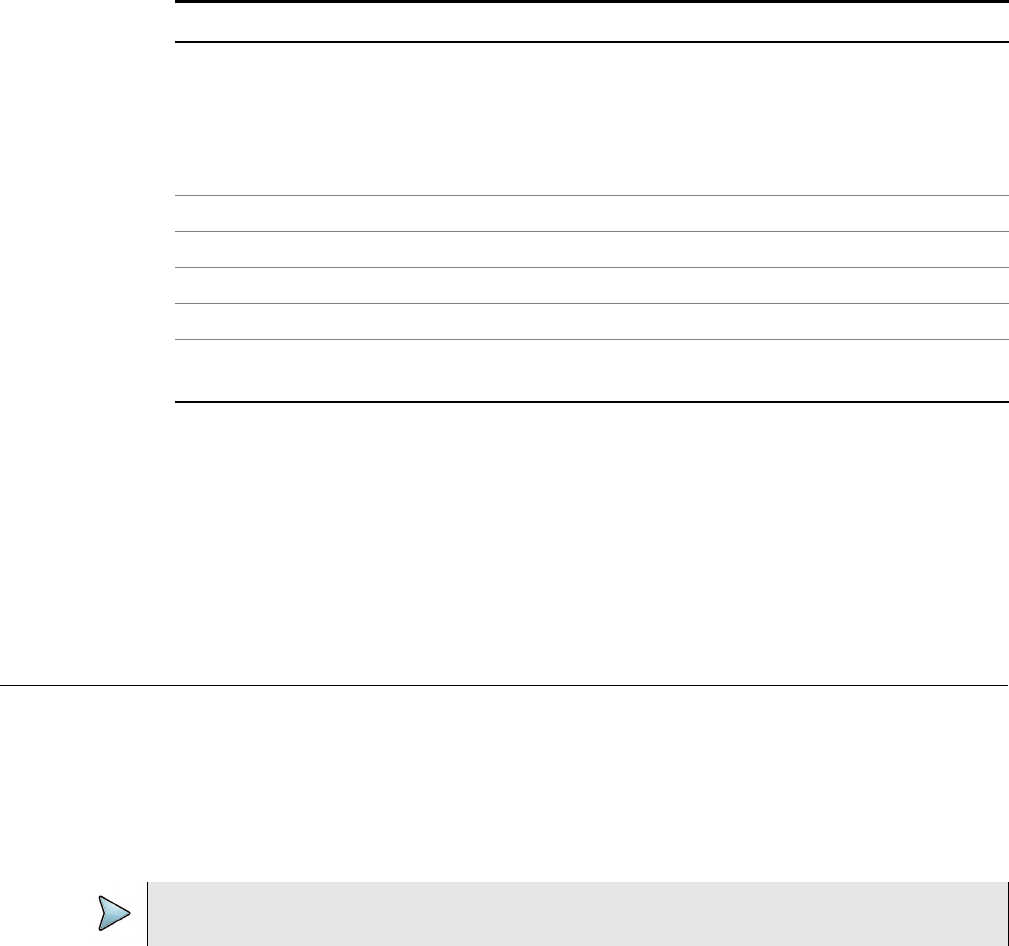
Chapter 7 Data testing
Monitoring pings
SmartClass TPS User’s Guide
May 2014 22035456, Rev 001 63
Specify the settings. The following table describes the settings.
3Select Ping Test Menu to start the ping and display the test results menu.
Use the # key to stop the test, if desired.
4To save a test report, press the utility (i) key and then select Save Report or Save To Job, and
then specify the report settings such as report name, report format, technician ID, location,
and other settings as needed.
For more information on the results, see “IP Data results” on page 128.
Monitoring pings
The Ping Monitor allows you to monitor incoming pings on an active line. This is useful for network
administrators to watch the network states and identify trouble.
To monitor pings
1From the IP Data menu, select Ping Monitor.
2View the results.
The results include the IP address and number of pings received. The IP address is for the
most recent device detected.
3To save a test report, press the utility (i) key and then select Save Report or Save To Job, and
then specify the report settings such as report name, report format, technician ID, location,
and other settings as needed.
Setting Description
Destination Type Specify whether the destination is an IP Address, DNS Name (domain name
server), or IPv6 Address.
IP address uses the numeric address. DNS name uses the domain name,
such as www.jdsu.com.
JDSU recommends using the IP address or DNS name of the ISP gateway of
the customer's service provider.
IP Address If the destination is IP Address, enter the IP address.
DNS Name If the destination is DNS Name, enter the DNS name.
TX Count Enter the number of pings to send before stopping.
TX Interval Specify the number of pings per second.
Payload Size Enter the ICMP Payload Size in Bytes.
The default is 16. Change this only if needed.
NOTE:
The Ping Monitor is only available when the modem is synchronized and the data layer is active.

Chapter 7 Data testing
Throughput testing
SmartClass TPS User’s Guide
64 22035456, Rev 001 May 2014
Throughput testing
This test uses FTP or HTTP to transfer files and measure the resulting throughput which yields a
throughput that the end user would experience.
To test throughput
1From the IP Data menu, select File Transfer Test, and then specify the settings. The following
table describes the settings.
2Select File Transfer Menu to start the transfer and display the test results menu.
Use the * key to clear the results or the # key to restart the test.
3To save a test report, press the utility (i) key and then select Save Report or Save To Job, and
then specify the report settings such as report name, report format, technician ID, location,
and other settings as needed.
For more information on the results, see “IP Data results” on page 128.
Setting Description
Transfer Direction Specify whether the transfer will be in the upload or download direction.
Transfer Protocol Specify whether to use FTP or HTTP protocol for the transfer
HTTP Auth. Type If you selected HTTP as the transfer protocol, select an HTTP Authentication type
–None – no user name/password authentication needed
–Basic – the client sends the user name and password entered, with no security
–Digest – the client sends the user name and password in a series of hashes for added secu-
rity.
Username Enter a valid user name. (appears if Basic or Digest is the Authentication Type)
Password Enter the user password.
This must be a valid password that matches the user name above. Passwords are often case-
sensitive. (appears if Basic or Digest is the Authentication Type)
Download URL or
Upload URL
Enter the URL address to upload to or to download from.
Upload real file Select whether to send a block of random data or to upload a real file.
Upload file Specify the file to be uploaded (appears if Upload real file is Yes). The file must be in the root
directory or in the FTP directory of the unit or a connected USB stick.
Upload pattern Specify the type of pattern to include when uploading random data. (appears if Upload real file is
No)
File size Specify the file size to upload, in number of bytes. (appears if Upload real file is No)
Save Downloaded File Select whether to save the downloaded file.
NOTE: Selecting YES can impact the performance of the unit.
Download filename If you selected YES to “Save the Downloaded File”, enter a name for the file.
Concurrent Downloads Specify whether you wish to do multiple downloads at the same time. Concurrent downloads can
utilize the bandwidth pipe better than a single download and is a better estimate of actual band-
width.
Auto Repeat Specify whether you want to automatically repeat the transfer as it runs in the background. This is
useful to verify whether it causes problems with other services.

Chapter 7 Data testing
Tracing the packet route
SmartClass TPS User’s Guide
May 2014 22035456, Rev 001 65
Tracing the packet route
Using the trace route feature, you can trace the IP packet path through the network. The following
procedure describes how to trace the packet route.
To trace the packet route
1From the IP Data menu, select Traceroute Test, and then specify the settings. The following
table describes the settings.
2Select Start Traceroute Test to start the test and display the test results menu.
Use the * key to clear the results or the # key to restart the test.
3To save the results, press the Utility key and then the 5 key.For more information on the
results, see Chapter “IP Data results”.
The packet route is traced.
Capturing network traffic
The SmartClass Triple Play Services allows you to capture network packets to a file on the Smart-
Class or to a file on a USB drive.
The capture feature allows you to filter captured information by IP address, port number, or by a
user-defined filter string. The information can be saved to a file, using PCAP format, which can be
sent to a network technician for analysis on a protocol analyzer.
If you insert a USB drive into the SmartClass Triple Play Services, it will recognize the drive and it
will become the default location where the packets will be saved. Otherwise, the packets will be
saved to a file in the internal File Manager. The maximum file size for packets stored in the internal
File Manager is 1 Mbytes; for USB capture, file size depends on the space available on the USB
drive.
To capture network traffic
1Select an interface (Ethernet TE, Wi-Fi, DSL-Bridge, or DSL-Modem/Router), and then select
Network.
2From the Interfaces menu, select Packet Capture.
Setting Description
Destination
Type
Select either IP address or DNS Name (domain name server name) as the desti-
nation type.
IP Address If the Destination Type is IP Address, enter the destination IP Address.
DNS Name If the Destination Type is DNS Name, enter the destination DNS Name.
Packet Type Select either ICMP (Internet Control Message Protocol) or UDP (User Datagram
Packet) as the packet type.
DNS Lookup
Hops
Specify whether you want to lookup names for hops.
NOTE:
Packet Capture is only available in IPv4 modes (not available in IPv6).
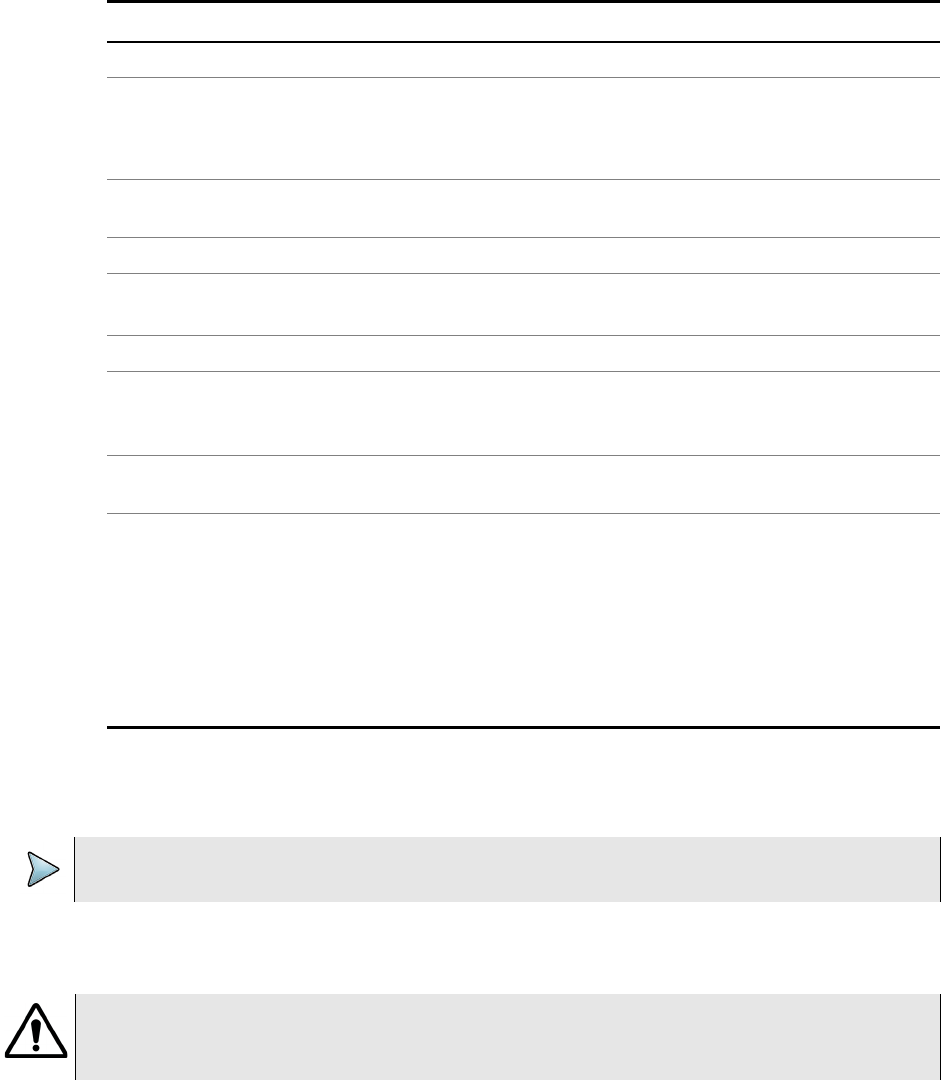
Chapter 7 Data testing
Capturing network traffic
SmartClass TPS User’s Guide
66 22035456, Rev 001 May 2014
3Specify the Packet Capture settings. The following table describes the settings.
4Select Packet Capture Menu
5Press the # key to start the capture.
Captured information is saved to the file. If you have a USB storage device connected, it will
be saved there. If not, the file will be saved to the SmartClass Triple Play Services file system.
You have captured network traffic.
Setting Description
Filename Name of the file where the captured packets are saved.
Packet limit The packet limit indicates how much information can be stored in the capture
file (in other words, the size of the capture file). You can specify from 1 to
10000000 packets. When the maximum file size has been reached, the
SmartClass Triple Play Services automatically stops capturing packets.
Promiscuous mode Enabling Promiscuous mode causes the SmartClass Triple Play Services to
capture all IP traffic regardless of source or destination addresses.
Use IP filter Specify whether to filter messages by IP address (No will disable the filter).
IP Filter If you selected “Yes” to Use IP filter, enter an IP address to filter on.
Only information from the IP address you entered will be captured.
Use Port Filter Specify whether to filter messages by port (No will disable the filter).
Port Filter If you selected “Yes” to Use Port Filter, enter the port number to filter on.
You can enter a number from 2 to 65534. Only messages from the port you
entered will be captured.
Use Custom Filter Specify whether to filter messages using a custom filter (No will disable the fil-
ter)
Custom Filter If you selected “Yes” to Use Custom Filter, enter a text string using the key-
pad. Some commonly used strings are as follows:
– tcp - captures only TCP packets
– udp - captures only UDP packets
– igmp - captures only IGMP packets
– not tcp - captures all packets except TCP
– less 1000 - captures all packets less than 1000 bytes in length
– greater 1000 - captures all packets greater than 1000 bytes in length.
NOTE:
The Start key is only available if a valid network connection is present.
CAUTION: CORRUPTED DATA
Removing the USB drive during a file capture or file save may corrupt the data. Do not remove
the drive until all files have been saved or the packet capture is complete.

8
SmartClass TPS User’s Guide
May 2014 22035456, Rev 001 67
Chapter 8
Wi-Fi Testing
This chapter provides task-based instructions for using the optional Wi-Fi testing features. Topics
discussed in this chapter include the following:
–“About Wi-Fi Testing” on page 68
–“Scanning for Wi-Fi networks” on page 68
–“Emulating a Wi-Fi end point” on page 70
–“Providing Wi-Fi access” on page 71
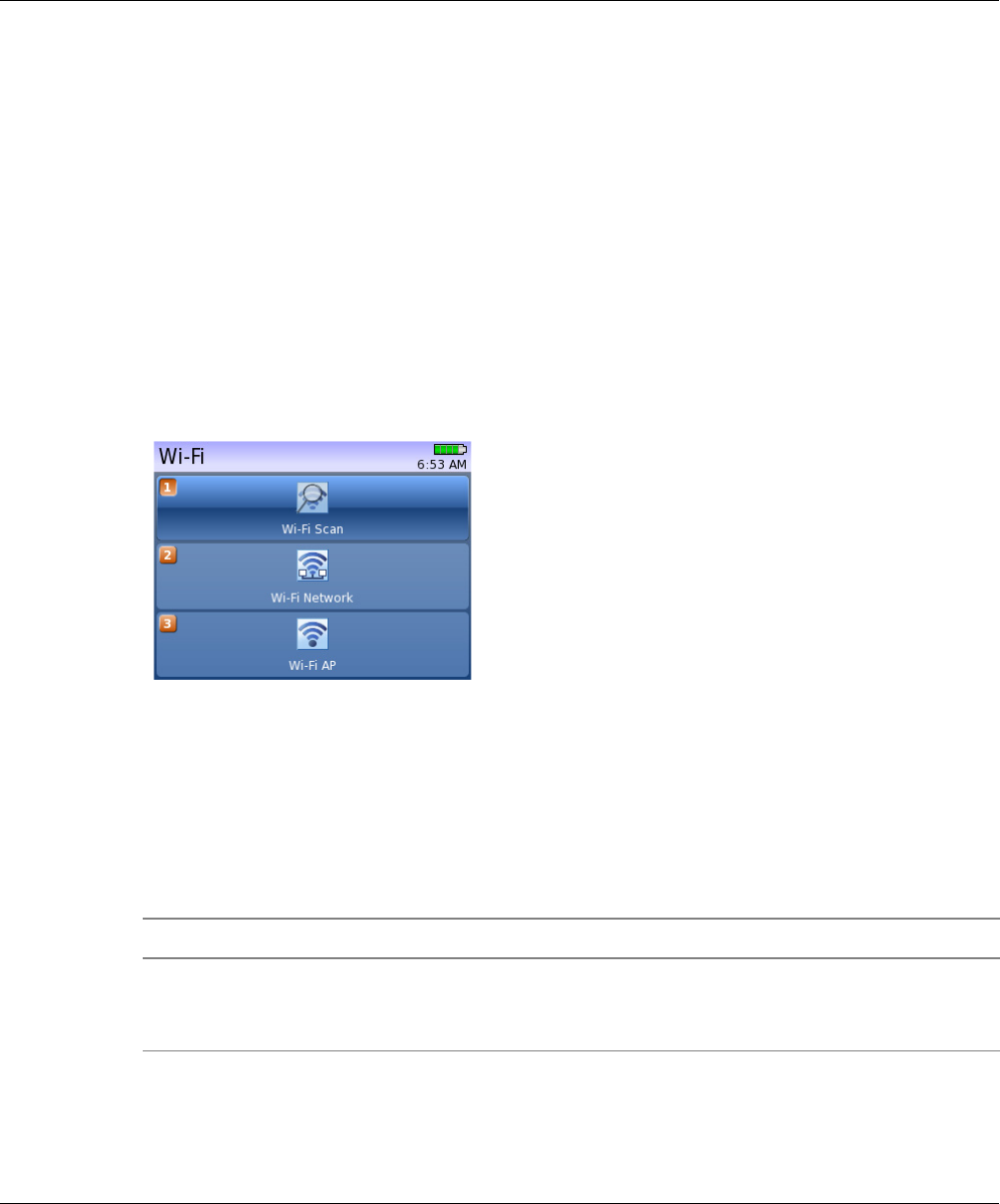
Chapter 8 Wi-Fi Testing
About Wi-Fi Testing
SmartClass TPS User’s Guide
68 22035456, Rev 001 May 2014
About Wi-Fi Testing
The SmartClass Triple Play Services’s optional Wi-Fi testing features allow performance assess-
ment and troubleshooting the customer premise Wi-Fi network.
The Wi-Fi testing features of the SmartClass include the following:
– Quickly determine the available SSIDs, level and channel of Wi-Fi networks visible from any
location. The test set can attach to a customer's network and provide assessment of the signal
strength throughout the premises.
– Provide a generic Wi-Fi access point (bridged Ethernet to WiFi) to verify IP connectivity, run
tests to back office, or configure CPE.
To access the Wi-Fi tools
– On the Main Menu screen, select Wi-Fi.
The Wi-Fi menu appears.
Depending on your unit configuration, your menu may vary.
Wi-Fi testing is only available on the two Wi-Fi enabled configurations:
CSC-TPSVW and CSC-TPSVW-CU.
Software options also enable certain features.
For additional information about SmartClass Triple Play Services options and services, contact
your local JDSU representative or contact JDSU through the company web site, www.jdsu.com.
Scanning for Wi-Fi networks
The Wi-Fi Network Scan is used to determine whether any Wi-Fi networks are available, and
provides the SSIDs, level and channel of any networks detected.
Figure 11 Wi-Fi menu
Table 11 Wi-Fi software options
Option Description
WiFiTest Allows all of the WiFi related capable test features (WiFi scan & Histo-
gram, connect to a WiFi Network for testing, and WiFi-to-Ethernet Bridge)
Mobile App Connectivity Provides connectivity to the iOs App.
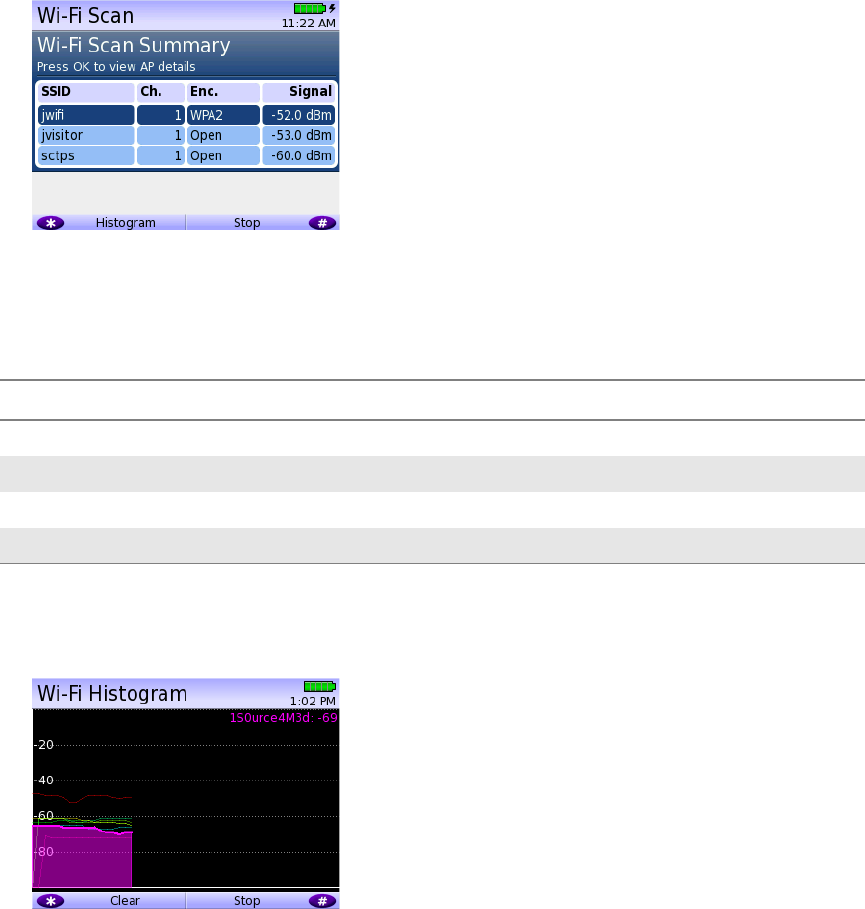
Chapter 8 Wi-Fi Testing
Scanning for Wi-Fi networks
SmartClass TPS User’s Guide
May 2014 22035456, Rev 001 69
To run a network scan
1From the Wi-Fi Tools menu, select Wi-Fi Scan.
The test will start searching for active Wi-Fi networks. The Wi-Fi search process may take a
few seconds.
After Wi-Fi search is finalized, results are gathered and displayed. A sample result screen is
shown in Figure 12.
Table 12 describes the Wi-Fi summary results.
To select a located network, use the up and down arrow keys to highlight the network.
2To view a histogram of the network, press the * key. A sample screen is shown in Figure 13.
The signal power over time is shown in graphical form.
3To view the details for a network, on the Scan Summary results, use the up and down arrows
to highlight the desired network, and then press the OK key.
Figure 12 Wi-Fi Scan Summary results
Table 12 Wi-Fi scan summary results
Results Description
SSID The Service Set Identifier of the specific wireless network
Ch Wi-Fi channel being used by the specific network
Enc. The security encryption being used on the Wi-Fi network
Signal The signal power level of the selected Wi-Fi Network
Figure 13 Wi-Fi Histograms
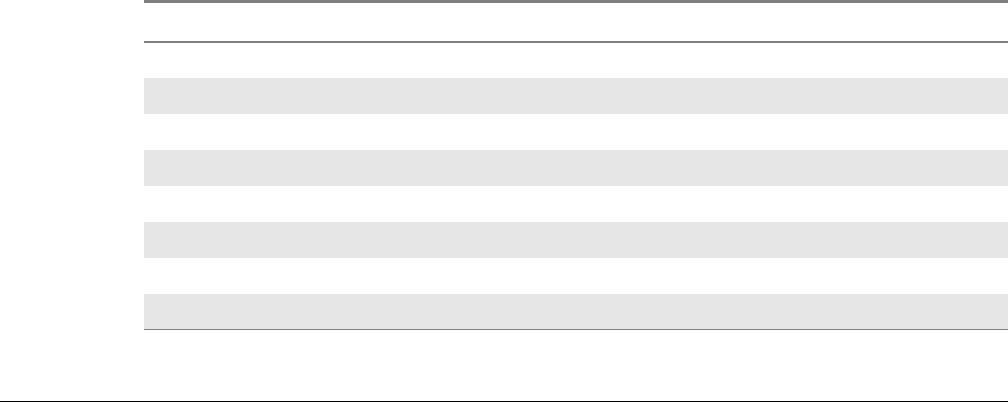
Chapter 8 Wi-Fi Testing
Emulating a Wi-Fi end point
SmartClass TPS User’s Guide
70 22035456, Rev 001 May 2014
Table 13 describes the Wi-Fi detailed results.
Emulating a Wi-Fi end point
The “Wi-Fi Network” feature is used to provide a connection to the Wi-Fi network as a managed end
point. This allows you to ping or surf the web to verify data connectivity, place VoIP calls, and
perform other tests.
To emulate a Wi-Fi end point
1From the Wi-Fi menu, select Wi-Fi Network.
2Select Network.
3Select End Point Setup, and then do the following:
aSelect SSID to verify the network ID that you are connect to.
bSpecify the Key, if necessary (the network has security enabled).
cIf needed, specify the Network Setup as described in “Specifying the network setup” on
page 42.
4Select End Point Status to view the network status.
5Select End Point Results to view statistics.
6If desired, browse the web, place a VoIP call, or run an automatic test.
IP connectivity is verified.
Table 13 Wi-Fi scan detailed results
Results Description
MAC Address The MAC address of the specific wireless network.
SSID The Service Set Identifier of the specific wireless network
Protocol The IEEE protocol used on the network.
Channel The Wi-Fi channel being used by the specific network
Frequency The signal frequency of the Wi-Fi network
Encryption The security encryption being used on the Wi-Fi network
Max Bit Rates The highest bit rates measured on the Wi-Fi network
Signal Level The power level of the selected Wi-Fi Network

Chapter 8 Wi-Fi Testing
Providing Wi-Fi access
SmartClass TPS User’s Guide
May 2014 22035456, Rev 001 71
Providing Wi-Fi access
The Wi-Fi AP selection is an Ethernet-to-Wi-Fi bridge mode to create an access point for mobile
devices such as Smart Phones, Tablets, Laptops, and so on. Connection to the internet comes from
the broadband service behind the RG or router. This mode allows the mobile devices to verify
internet connectivity without hunting for CPE passwords, running tests to the CO, or even config-
uring (or reconfiguring) the RG as required.
To provide Wi-Fi access
1From the Wi-Fi menu, select Wi-Fi AP.
2Select Network Setup to verify network settings.
aIf needed, specify the Wireless Setup as described in “Communicating with a mobile
device” on page 23.
bIf needed, specify the Network Setup as described in “Specifying the network setup” on
page 42.
3If needed, configure the Wi-Fi settings on the mobile device to connect to the SmartClass
Triple Play Services.
Chapter 8 Wi-Fi Testing
Providing Wi-Fi access
SmartClass TPS User’s Guide
72 22035456, Rev 001 May 2014

Chapter 9 HPNA Testing
About HPNA Testing
SmartClass TPS User’s Guide
74 22035456, Rev 001 May 2014
About HPNA Testing
The capabilities of the SmartClass Triple Play Services’s optional HPNA testing features include the
following:
Operational mode — This mode monitors the active network during its normal operation and periodically
updates statistics.
Network test mode — This transient mode performs a disruptive network test that transfers a configurable
number of packets across each unidirectional logical link in the network and gathers statistics.
These features are available if the HPNA software option is enabled.
Connecting to the line
After specifying the test settings, you can connect to the line.
To connect to the line
1Connect one end of an Ethernet cable to the Ethernet jack on the right side of the unit.
2Connect the other end of the cable to the Ethernet port of the CPE that is on the HPNA
network (such as a set-top-box or residential gateway).
Monitoring the HPNA network
The following procedure describes how to monitor the HPNA network.
To monitor the HPNA network
1On the Main Menu, select HPNA.
The Station List screen appears.
2If desired, use the arrow keys to highlight a specific node and then press the OK key to view
more detailed statistics for that node.
Table 14 Station List results
Results Description Units Range/Values
H This column indicates the host/client of every HPNA
device in the network
H: Host device
Id The station identifier for the HPNA device. numeric digit 0-9
Hpna MAC The MAC address of the HPNA device in the network aa:bb:cc:dd:ee:ff Each field is 00-FF hex
Ver – Chip The device’s firmware version and CopperGate™ chip ID. revision-chip id Chip ID = Chipset
0 3010
1 3110
2 3210
3 3310
4 3320

Chapter 9 HPNA Testing
Testing the HPNA network
SmartClass TPS User’s Guide
May 2014 22035456, Rev 001 75
Testing the HPNA network
This test verifies that all installed devices are operating correctly.
To test the HPNA network
1On the Main Menu, select HPNA.
A list of HPNA nodes appears.
Verify that all HPNA devices are present on the network before proceeding.
2Press the * key to specify the HPNA settings.
– Specify the HPNA Minimum Rate (the minimum rate, in Mbps, that will pass)
– Specify the HPNA Minimum SNR (the minimum SNR, in dB, that will pass)
– Specify the Quick Max Packet Lost (the maximum packet loss, in number of packets,
allowed for the Quick Test)
– Specify the Chronic Max Packet Lost (the maximum packet loss, in number of packets,
allowed for the Chronic Test)
3Select the # key to select the type of test to run:
Quick – 5,000 packets. Used to quickly test the HPNA network for common issues.
Chronic – 100,000 or more packets. Used to exhaustively test the HPNA network for chronic
trouble.
4Select the # key to begin the test.
After the network test finishes, the screen updates to report the data rate, modulation, packet
error rate, and signal to noise ratio on the current link.
If the packet error rate is zero and the data rate is over 112Mb, the screen will indicate a pass.
If the packet error rate is non-zero, SNR is less than -34 dB, or the data rate is less than
112Mb, the screen will indicate a failure in red.
5Use the up and down arrow keys to view the results.
6Highlight a specific node and then press the OK key to view node-to-node link information,
such as the MAC addresses and the received power.
7Press the # key to view live statistics between the selected HPNA nodes.
8To save a test report, press the utility (i) key and then select Save Report or Save To Job, and
then specify the report settings such as report name, report format, technician ID, location,
and other settings as needed.
For more information on the results, see “HPNA results” on page 130.
NOTE:
The size and number of packets may be adjusted from the default settings for each Quick or
Chronic test prior to proceeding.
Chapter 9 HPNA Testing
Testing the HPNA network
SmartClass TPS User’s Guide
76 22035456, Rev 001 May 2014

10
SmartClass TPS User’s Guide
May 2014 22035456, Rev 001 77
Chapter 10
SmartID Testing
This chapter provides task-based instructions for testing with SmartIDs. Topics discussed in this
chapter include the following:
–“About the SmartIDs” on page 78
–“Registering SmartIDs” on page 79
–“Configuring SmartID settings” on page 79
–“Locating SmartIDs” on page 80
–“Testing the home run for VDSL service” on page 81
–“Testing the home network” on page 82
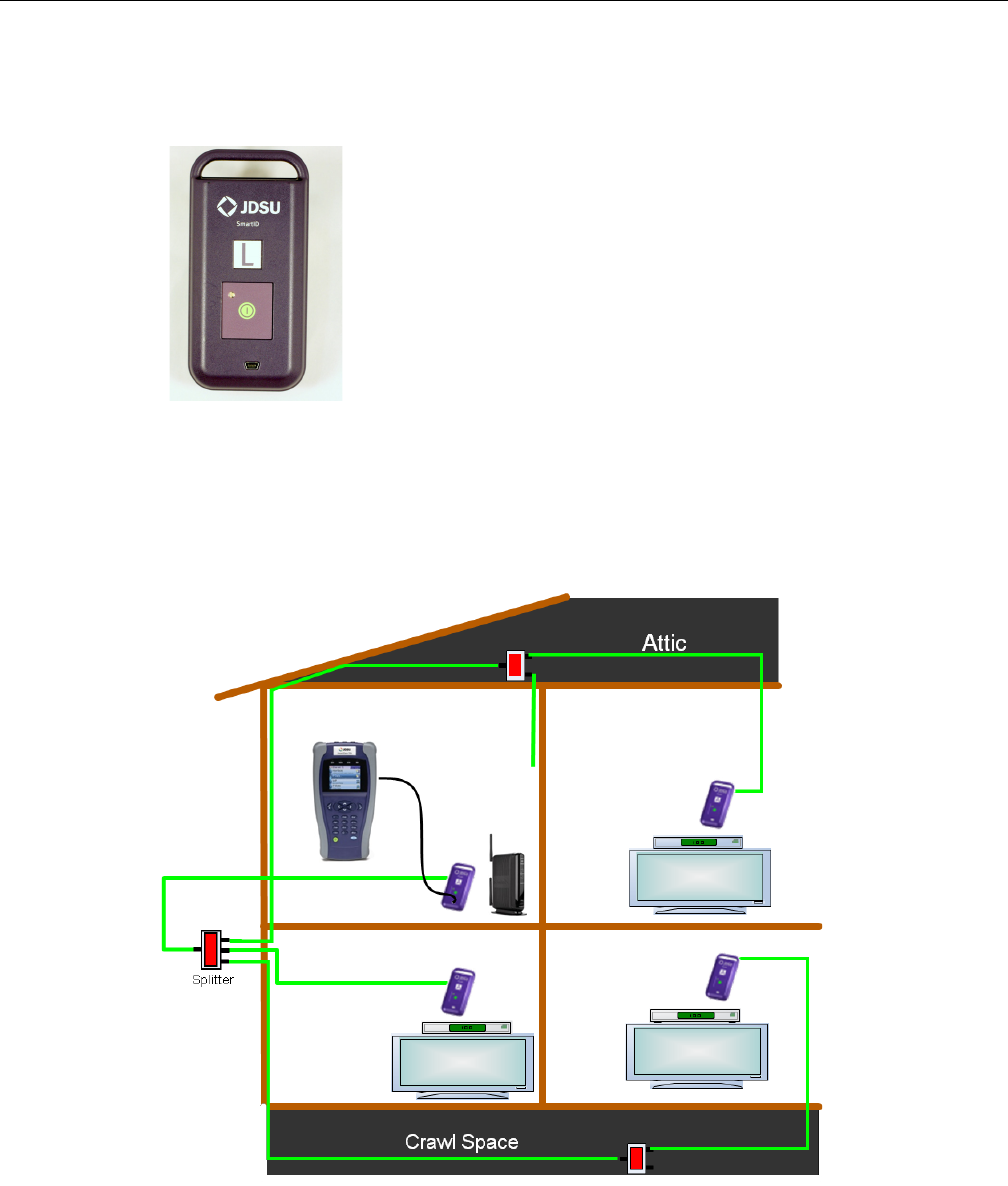
Chapter 10 SmartID Testing
About the SmartIDs
SmartClass TPS User’s Guide
78 22035456, Rev 001 May 2014
About the SmartIDs
The SmartIDs (Figure 14) allow a technician to connect the <product name> directly to any single
SmartID device which then communicates with any other connected SmartID devices in order to
certify an in-home network and provide distances to found impairments. See Figure 15.
The difference in the SmartIDs versus the other terminators is that the terminators only indicate their
location, whereas the SmartIDs each also are used to identify their location, but also each SmartID
does a broadband noise ingress measurement, dual-ended FDR for coax mapping and frequency
sweeping to locate impairments.
If a Diplexer is on the network, disconnect the VDSL connection.
Figure 14 SmartID
Figure 15 SmartID connection

Chapter 10 SmartID Testing
Registering SmartIDs
SmartClass TPS User’s Guide
May 2014 22035456, Rev 001 79
There are three test modes
– Locate SmartIDs – finds and identifies all SmartIDs currently connected to the network.
– VDSL Home Run Check – a two-point (two SmartIDs) test across the cable connecting at the
residential gateway and the diplexer locations. This test is to qualify a coaxial cable home run
intended to be used for VDSL service from the NID to a RG (i.e. instead of supplying VDSL
signal to the RG over twisted pair).
– Whole Home Check – tests a complex cable network that may or may not include a Diplexer. It
is intended to qualify the network for HPNA.
Registering SmartIDs
Before the first test with the SmartIDs, you must register all of the SmartIDs with the instrument.
This registration applies to the SmartID that the <product name> is physically connected to. You will
need to repeat the procedure for each SmartID, connecting it directly to the <product name>.
To register SmartIDs
1From the Main Menu, select SmartID.
2On the SmartID screen, select Settings.
3On the SmartID Settings screen, select SmartID Registration.
4Press the * key to add a new SmartID.
5Enter the label (A-Z) for the SmartID. This is the letter that is on the SmartID. You may need to
apply the label if one is not present, and the label can be changed, if desired.
6Enter the serial number (found under the battery cover or on the side of the SmartID) or plug in
the SmartID. If the SmartID is plugged in, it will advertise its serial number to the <product
name>.
7Repeat step 4 through step 6 for each SmartID.
The SmartIDs are registered.
Configuring SmartID settings
This menu specifies settings used for locating SmartIDs.
To configure SmartID settings
1From the Main Menu, select SmartID.
2On the SmartID screen, select Settings.
3Select Cable Types to add, edit, or remove cable types.
4Select Configuration, and then specify the following:
– patch cable length
– noise threshold (values at or above this limit are failing)
– fast scan limit (amount of time the Continuous Fast-Scan Locate SmartID mode runs before
requiring a restart)
– power off limit (this is the time at which the SmartIDs will auto power-off after a test)

Chapter 10 SmartID Testing
Locating SmartIDs
SmartClass TPS User’s Guide
80 22035456, Rev 001 May 2014
The settings are specified.
Locating SmartIDs
The purpose of this test is to identify up to 16 SmartIDs on the network. The SmartIDs will work
through splitters, and multiple SmartIDs can be detected simultaneously.
To locate SmartIDs
1Connect SmartIDs to the network at any location in the home where network qualification or
troubleshooting is desired, such as set top boxes or residential gateways (see Figure 15 for
examples).
2Connect the USB cable from <product name> to one of the SmartIDs.
3On the SmartID screen, select Locate SmartIDs.
If a warning message appears saying that no SmartIDs are registered, register the SmartIDs
as described in “Registering SmartIDs” on page 79.
4If the test doesn’t automatically start, press the # key to restart.
The test runs and then displays the IDs found.
5To enter Fast-Scan mode, press the * key.
The Locate SmartIDs test performs a single locate function. Fast-Scan mode continuously
scans for connected SmartIDs to allow you to quickly identify multiple coax runs in succession.
Since continuously scanning for SmartIDs can drain battery life, the default timeout can be
adjusted in the “Configuring SmartID settings” on page 79.
6To save a test report, press the utility (i) key and then select Save Report or Save To Job, and
then specify the report settings such as report name, report format, technician ID, location,
and other settings as needed.
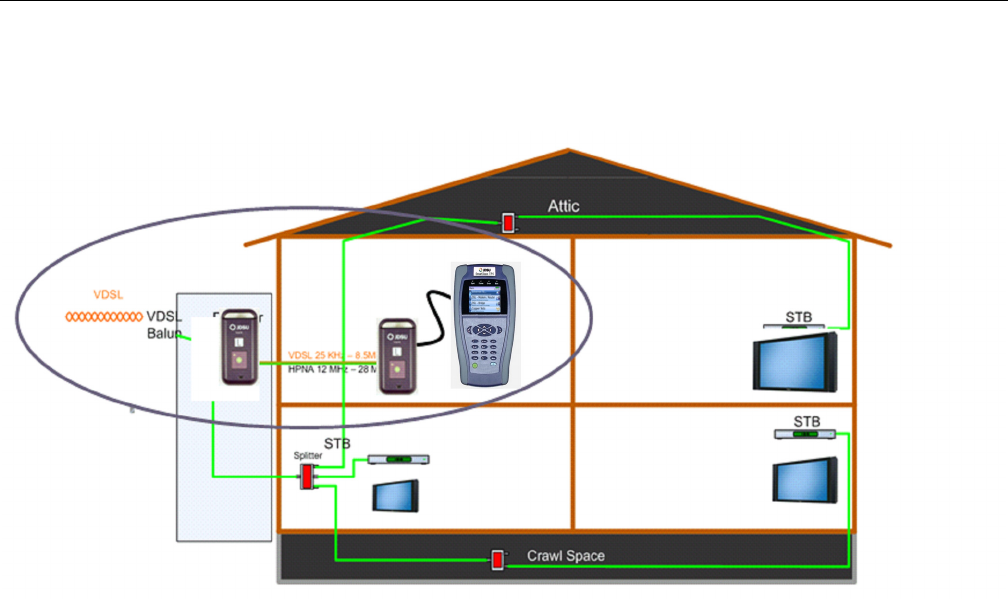
Chapter 10 SmartID Testing
Testing the home run for VDSL service
SmartClass TPS User’s Guide
May 2014 22035456, Rev 001 81
Testing the home run for VDSL service
The VDSL Home Run Check tests the cable connecting the residential gateway to the diplexer (see
Figure 16).
To run a VDSL Home Run Check
1Connect a SmartID to the coax cable at the residential gateway location.
2Connect the USB cable from <product name> to the SmartID at the RG.
3Disconnect the cable that runs between the diplexer and the residential gateway, and then
connect a SmartID to the cable (this takes the diplexer out of the test).
4On the SmartID menu, select VDSL Home Run Check.
The SmartID connected to the <product name> is highlighted. The test fails if any impairments
are found, and an exclamation point appears on the cable segment on the screen. To view
information for the cable segment or the other SmartID, press the left or right arrow keys. The
details appear in the box.
Use the # key to reverse the view.
5To save a test report, press the utility (i) key and then select Save Report or Save To Job, and
then specify the report settings such as report name, report format, technician ID, location,
and other settings as needed.
Figure 16VDSL Home Run Check

Chapter 10 SmartID Testing
Testing the home network
SmartClass TPS User’s Guide
82 22035456, Rev 001 May 2014
Testing the home network
The Whole Home Check maps a coax network and provide distances to found impairments.
To run a Whole Home Check
1Disconnect the cable or DSL feed. If using a diplexer, disconnect the feed to the diplexer (and
leave it open).
2Connect a SmartID at the point of entry and use the USB cable to connect the SmartClass
Triple Play Services to the SmartID.
In order to map the network accurately, make sure that you connect to the primary SmartID
(connected to the SmartClass Triple Play Services with a USB cable) on the main side of the
residential gateway or splitter and not on a branch leg.
3Place other SmartIDs at any location in the home wherever network qualification or trouble-
shooting is desired.
There are three possible test configurations:
aNID without diplexer: The primary SmartID (connected to the SCH with a USB cable)
should be connected at the RG (in place of the RG), and the remaining SmartID probes
should be connected at the STBs (in place of the STBs).
bNID with diplexer: The primary SmartID (connected to the SCH with a USB cable) should
be connected at the RG (in place of the RG), and the remaining SmartID probes should
be connected at the STBs.
When a Diplexer is on the network, the VDSL connection must be disconnected.
cINID: The primary SmartID (connected to the SCH with a USB cable) should be connected
at the INID coax connection feeding into the home (disconnected from the INID), and the
remaining SmartID probes should be connected at the STBs.
When connecting a SmartID to a wall plate, it is recommended to use a coax jumper cable of
at least 3 feet in length.
Ensure that all devices except SmartIDs are disconnected from the network.
4On the Main Menu, select SmartID.
5On the SmartID screen, select Whole Home Check.
6On the Select SmartID Test Plan screen, select whether to test through a diplexer (RG -
Through Diplexer) or not (RG - No Diplexer).
– For the NID without diplexer configuration (configuration a, above), select RG - No
Diplexer.
– For the NID with diplexer configuration (configuration b, above), select RG - Through
Diplexer.
– For the INID configuration (configuration c, above), select RG - No Diplexer.
7Begin the test.
NOTE:
All live network signals must be disconnect from the coax network under test.
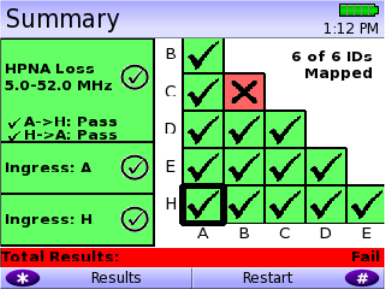
Chapter 10 SmartID Testing
Testing the home network
SmartClass TPS User’s Guide
May 2014 22035456, Rev 001 83
After the test completes, the result test summary appears.
The test summary displays the paths between SmartIDs and indicates whether the quality of
the path between the two points is passing or failing based on pre-set limits. The left side of
the screen will show the frequency sweep and noise ingress measurement results for each
highlighted box, which corresponds to the two points between SmartIDs in the coax network.
To view other test results, press the * key and then either use the arrow keys to navigate to
different SmartID results or directly select the desired result: Test Summary, Detailed View,
Network Map, or Sweep Data. For more detail on the results, see “SmartID results” on
page 131.
8To save a test report, press the utility (i) key and then select Save Report or Save To Job, and
then specify the report settings such as report name, report format, technician ID, location,
and other settings as needed.
Figure 17 Whole Home Test Summary (Example)
Chapter 10 SmartID Testing
Testing the home network
SmartClass TPS User’s Guide
84 22035456, Rev 001 May 2014

11
SmartClass TPS User’s Guide
May 2014 22035456, Rev 001 85
Chapter 11
VoIP Testing
This chapter provides task-based instructions for using the optional SmartClass Triple Play
Services voice over IP (VoIP) testing features. Topics discussed in this chapter include the
following:
–“About VoIP” on page 86
–“Specifying test settings” on page 86
–“Connecting to the line” on page 91
–“Placing and receiving calls” on page 91
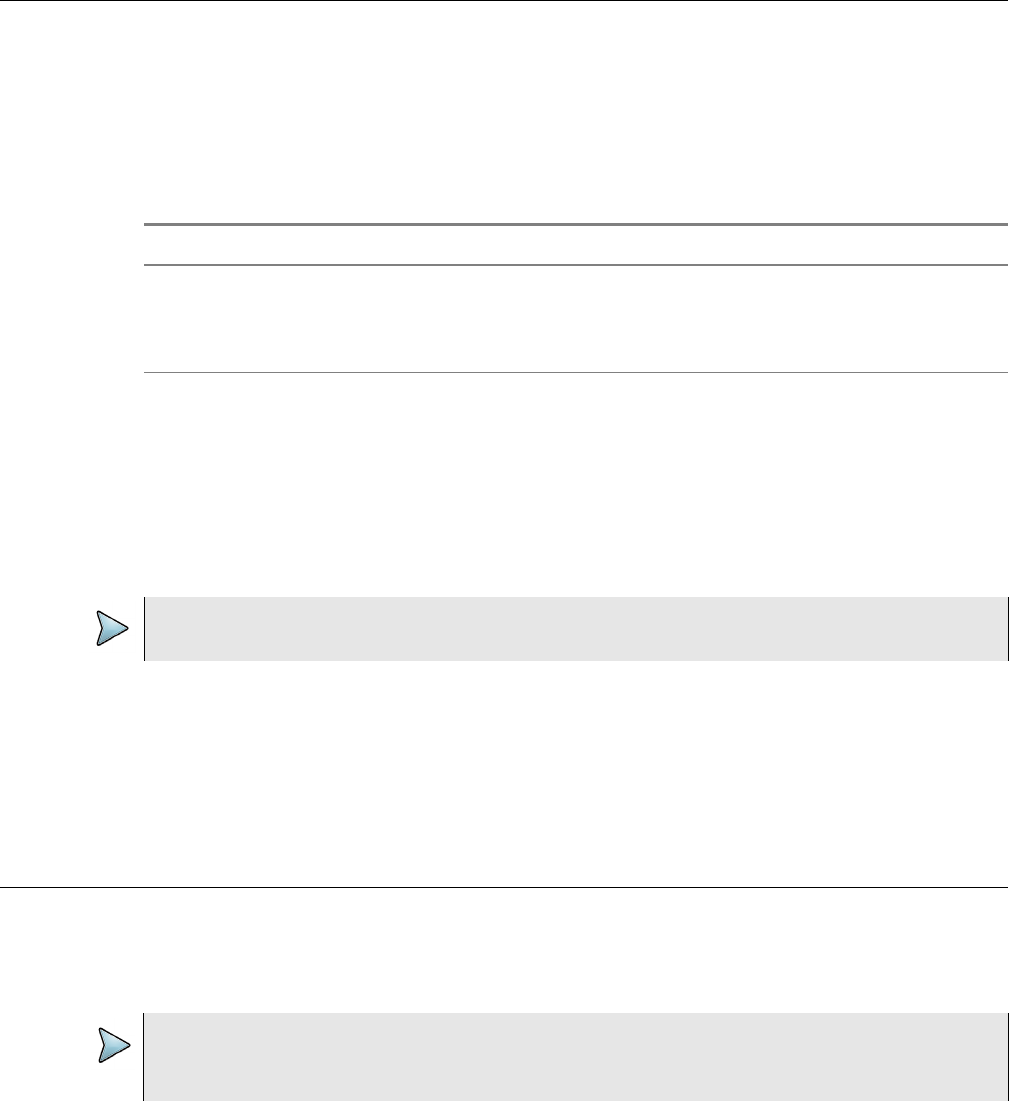
Chapter 11 VoIP Testing
About VoIP
SmartClass TPS User’s Guide
86 22035456, Rev 001 May 2014
About VoIP
Using the optional VoIP testing features, you can emulate a VoIP phone to place and receive VoIP
calls.
You can expand your testing capability by purchasing additional VoIP testing options. The options
available for purchase are as follows:
For additional information about SmartClass Triple Play Services options and services, contact
your local JDSU representative or contact JDSU through the company web site, www.jdsu.com.
To access the VoIP application
– Select an interface (Ethernet TE, Wi-Fi, DSL-Bridge, or DSL-Modem/Router), and then select
VoIP.
The VoIP phone test involves the following steps:
– Specifying test settings
– Connecting to the line
– Placing and receiving calls
Specifying test settings
Before you begin testing, make sure that the SmartClass Triple Play Services settings match the
settings of the phone you are emulating.
To specify test settings
1From the VoIP menu, select VoIP Setup.
Table 15 VoIP testing options
Option Description Order Number
VoIP VoIP application, including SIP, H.323, and MGCP signaling SCTP-VoIP
MOS Mean Opinion Score (MOS) option (requires VoIP option) SCTP-MOS
SCCP Cisco SCCP call control (requires VoIP option) SCTP-SCCP
NOTE:
VoIP is only available in IPv4 modes (not available in IPv6).
TIP:
Test configurations can be stored for easy recall and use (see “Managing test configurations” on
page 29).

Chapter 11 VoIP Testing
Specifying test settings
SmartClass TPS User’s Guide
May 2014 22035456, Rev 001 87
Configuring the settings can be done one of two ways:
– Press a number on the key pad that corresponds to the setting you want to configure.
– Use the arrow keys to highlight the setting you want to change, and then press the OK key.
Press the Cancel key to exit a menu.
2Select General Setup, and then specify the settings.
The available settings depend on the call control selected. The following table describes the
settings.
NOTE:
You must specify the interface settings before specifying VoIP settings. For example, you must
configure the Network, LAN, and other applicable settings for a xDSL line.
Setting Description
CC Standard Specify the call control standard: H.323 (Fast connect), H.323 (Full), SIP,
SCCP, or MGCP.
NOTE: Some call controls are options, so if your unit is not equipped with
the option, you will not see all of the selections.
Auto Answer Specify whether to automatically answer incoming calls. Yes means all
incoming calls are answered automatically. No is the typical setup and
means that calls will be answered manually.
Alias (H.323 or SIP) For H.323, this is the phone number alias that will be associated with the
phone that you are trying to emulate. This phone number will be included
in the connection request messages that are exchanged with the Gate-
keeper/Proxy or other endpoint devices.
For SIP, this specifies the registrar. If you have a network that uses one
server for registration (the registrar) and another for placing and receiving
calls “Alias” specifies the registrar. (“Proxy IP” on the Proxy Settings menu
specifies the server used for placing and receiving calls.) There are two
ways to get the Alias for SIP - you can specify the Alias by directly entering
a value by yourself; or alternatively, by querying a web server to get back
an Alias value. Using the latter way, you need to enter the URL of the web
server.
H.323 ID (H.323) Enter the ID, using up to 40 characters.
This is an ID element field in the ALIAS information that is sent to the
Gatekeeper during all registration and request messages.
The H.323 gateway registers with an H.323 ID. This is either an email ID
or an E.164 address. For example:
Email ID (H.323 ID): gwy-01@domain.com
E.164 Address: 5125551212
Bearer Capability
(H.323)
This sets the Bearer Cap information element in the H.323 setup message
for outgoing calls: Voice, 3.1K audio, Unrestricted digital
Calling Plan (H.323) If required, this sets the Calling Party Numbering Plan information element
in the H.323 setup message for outgoing calls: Unknown, ISDN/Tele-
phony, Data, Telex, National, Private.
Calling Type (H.323) If required, this sets the Calling Party Type information element in the
H.323 setup message for outgoing calls: Unknown, International, National,
Network Specific, Subscriber, Abbreviated.
Called Plan (H.323) If required, this sets the Called Party Numbering Plan information element
in the H.323 setup message for outgoing calls: Unknown, ISDN/Tele-
phony, Data, Telex, National, Private.

Chapter 11 VoIP Testing
Specifying test settings
SmartClass TPS User’s Guide
88 22035456, Rev 001 May 2014
3Press the right arrow to move to the Audio/Codec settings, and then specify the settings.
The following table describes the settings.
The next step depends on the CC Standard selected.
– For H.323, go to step 4.
– For SIP, go to step 5.
– For SCCP or MGCP, go to step 6.
Called Type (H.323) If required, this sets the Called Party Type information element in the
H.323 setup message for outgoing calls: Unknown, International, National,
Network Specific, Subscriber, Abbreviated.
Outbound Alias Type
(SIP)
Select the method for outbound dialing: Dial by Phone Number or Dial by
Name/URL/Email.
SIP Vendor (SIP) Specify the vendor: Standard SIP, Nortel SIP, Huawei SIP.
Device Type (SCCP) Select the device type.
Device Name Type
(SCCP)
Select one of the following: Automatic based on MAC address, or User
Defined
Device Name
(SCCP)
If Device Name Type is set to “User Defined”, enter a device name.
Endpoint ID Type
(MGCP)
Select one of the following: user defined or automatic based on the IP
address (for example,
aaln/01@[10.50.20.2]).
Endpoint ID (MGCP) If Endpoint ID Type is set to “User Defined”, enter the ID of the endpoint.
Setting Description
Audio codec This selects which codec will be used.
Frame Interval Set the speech per frame. This is the number of milliseconds of speech per
transmission frame when using a sample based codec (such as G.711).
Jitter buffer Set the jitter buffer size. This is the number of milliseconds of speech that
will be collected before an attempt will be made to play the speech back.
This allows lost, late, or out-of-sequence packets time to arrive and be reas-
sembled before playback.
Transmit Source Select the source of transmission: Voice conversation (transmits and
receives live voice), IP voice announce (the unit repeats a sequence of
words including the calling party’s IP address), Tone
Silence suppression Enable or disable.
RTP Diffserv Value Enter a value to indicate the Voice IP Quality of Service Differentiated Ser-
vices (DiffServ) code point.
The value will occupy a 6-bit field in the packet headers of RTP stream voice
packets and will indicate how packets are treated at each hop. You can
specify a number from 0 to 63 to indicate the per-hop behavior.
RTP Port Minimum Specify the RTP port minimum number.
The real-time transport protocol (RTP) port number allows you to identify
voice traffic versus other traffic. Some systems only accept RTP traffic on
certain port numbers. (It must be a factor of 2.)
RTP Port Maximum Specify the RTP port maximum number. (It must be a factor of 2.)
Setting Description

Chapter 11 VoIP Testing
Specifying test settings
SmartClass TPS User’s Guide
May 2014 22035456, Rev 001 89
4If you are using H.323 call control, press the right arrow to view the Gate Keeper Settings,
and then specify the settings.
The following table describes the settings.
5If you are using SIP call control, press the right arrow to view the Proxy Settings, and then
specify the settings.
The following table describes the settings.
6If you are using SCCP or MGCP, press the right arrow to view the Call Manager or Call Agent
settings, and then specify the settings.
The following table describes the settings.
Setting Description
Gatekeeper Mode Specify one of the following: No Gatekeeper means no RAS (registration,
admission, and status) messages will be used, Auto Discover uses a
well known IP address and port number, Static allows you to enter the
gatekeeper address
Gatekeeper IP If the Gatekeeper mode is Static or Auto Discover mode, enter the IP
address of the Gatekeeper.
Call Control Port Enter the Call Control Port number.
This is a UDP port that is used for call control messages (for placing and
receiving calls).
RAS Port Enter the port number of the Gatekeeper.
This is a UDP port that is used for registration (RAS messages).
Remote RAS Port Enter the Remote Call Control Port number.
Setting Description
Proxy Mode Specify whether the proxy uses a Static address or no proxy.
Address Type Select IP Address or DNS Name.
Proxy IP If Address Type is IP Address, enter the IP address of the proxy server.
This is the outbound proxy, or the device from which the SmartClass will
send and receive all SIP messages. If you have a network that uses one
server for registration and another for placing and receiving calls, the
Proxy IP specifies the address for placing and receiving calls (“Alias” on
the General Settings menu specifies the registrar address).
Proxy Name If Address Type is DNS Name, enter the DNS name of the proxy server.
Proxy Port Enter the port number of the proxy.
Call Control Port Enter the Call Control Port number.
Proxy User name Enter the Proxy User name
Proxy Password Enter the Proxy Password
Setting Description
Call Manager IP /
Call Agent IP
Enter the IP address of the Call Manager or Call
Agent.
Call Manager Port /
Call Agent Port
Enter the Call Manager Port or Call Agent Port. The
range is from 1 to 65535.

Chapter 11 VoIP Testing
Specifying test settings
SmartClass TPS User’s Guide
90 22035456, Rev 001 May 2014
7Press the right arrow to view the Stun Configs settings, and then specify the settings.
STUN (Simple Transversal of UDP [User Datagram Protocol] Through NATs [Network Address
Translators]) allows VoIP calls across a NAT router. These settings should only be changed if
necessary.
The following table describes the settings.
8Press the right arrow to view the QOS Thresholds, and then specify the settings.
The quality of service (QoS) measurement uses two thresholds – good and poor – to produce
three quality ratings: good, poor, and fair. If the value is less than the good threshold, it is
considered good and is indicated with a check mark. A value between good and poor is
considered fair and is indicated by an exclamation mark. If the value is greater than the poor
threshold, it is considered poor and is indicated by an X.
The following table describes the settings.
The test settings are specified.
Setting Description
Stun Enable or disable.
Server Address Type Select IP Address or DNS Name.
Server IP Address If the Server Address Type is IP Address, enter the IP address of the stun
server.
Server Address If the Server Address Type is DNS Name, enter the DNS name of the stun
server.
Server Port Enter the port number of the stun server.
Client Port Enter the client port number.
Refresh Period Specify the NAT refresh rate. This is the number of seconds between mes-
sages to the STUN server to keep the NAT mapping alive.
NOTE:
If STUN is enabled, the network layer will not come up until the STUN client on the SmartClass
Triple Play Services has determined the type of NAT used between the SmartClass Triple Play
Services and the STUN server.
Setting Description
Jitter Good Enter the Pass threshold, in milliseconds.
Jitter Poor Enter the Fail threshold, in milliseconds.
Delay Good Enter the Pass threshold, in milliseconds.
Delay Poor Enter the Fail threshold, in milliseconds.
Loss Good Enter the Pass threshold, in milliseconds.
Loss Poor Enter the Fail threshold, in milliseconds.
MOS Scaling Select the scaling method. This selection affects the scaling of the CQ-MOS and
LQ-MOS results (on the “Call Scores” result screen). This selection is only avail-
able if your unit is equipped with the MOS option.
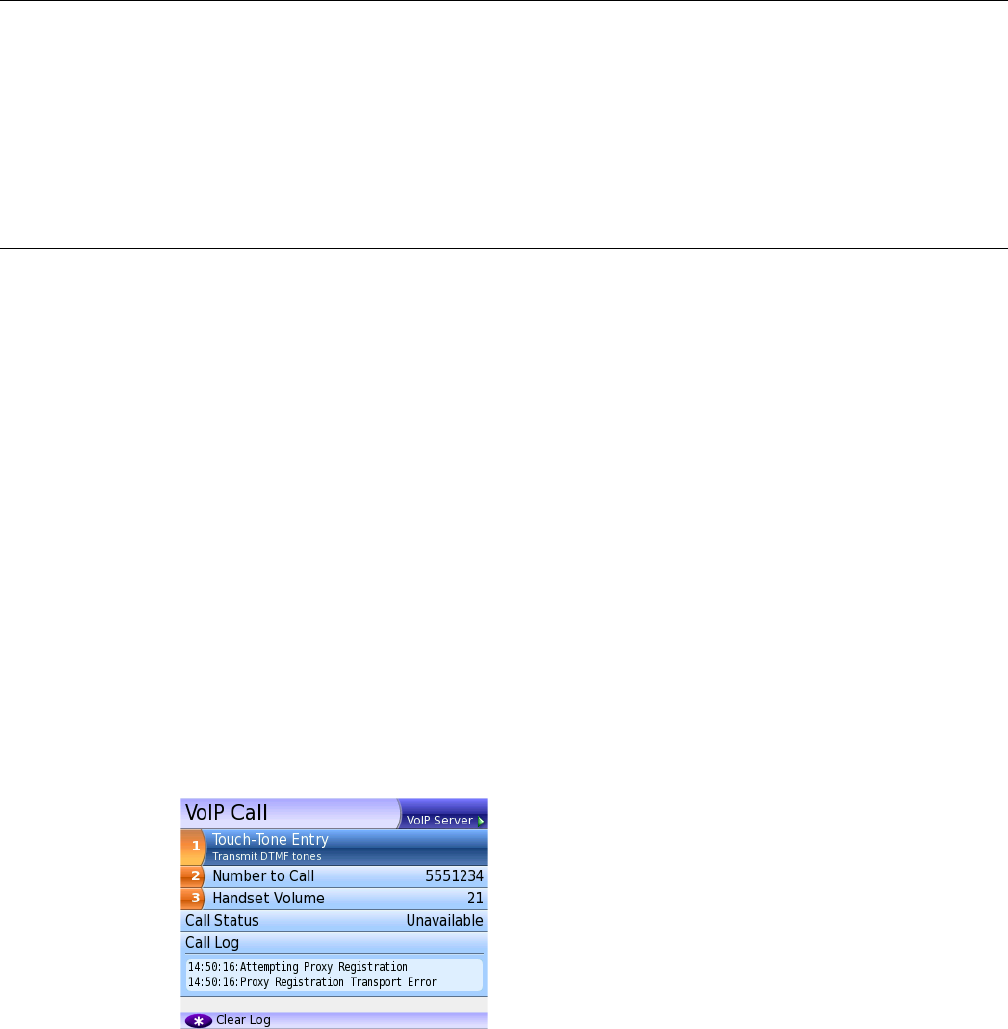
Chapter 11 VoIP Testing
Connecting to the line
SmartClass TPS User’s Guide
May 2014 22035456, Rev 001 91
Connecting to the line
After specifying the test settings, you can connect to the line. The procedure is different depending
on the access interface.
– For Ethernet connections, connect as described in “Connecting to the line” on page 44.
– For DSL connections, connect as described in “Connecting to the line” on page 57.
Placing and receiving calls
After specifying test settings and connecting to the line, you are ready to place and receive calls.
By placing and receiving calls you can do the following:
– If you can successfully register with the Gateway (or Call Agent/TPS/Proxy/etc.) you have veri-
fied the provisioning.
– If you can successfully place and receive calls from internal and external networks, you have
verified connectivity.
– During an active call, you can view statistics such as MOS, Loss, and Jitter, to measure the call
quality.
Placing a call
The following procedure describes how to place a VoIP call.
To place a VoIP call
1From the main VoIP menu, select VoIP Call.
The VoIP Call menu appears.
2Select Number to Call.
The last number dialed appears.
To enter a different number, use the keypad. To backspace, use the down arrow key.
If the gatekeeper mode is None, enter the IP to Call also.
3Select Handset Volume, and then use the arrow keys to adjust the volume.
4Use the # key to Dial.
The unit to goes off hook and places the call.
The call status will update at the bottom of the screen.
Chapter 11 VoIP Testing
Placing and receiving calls
SmartClass TPS User’s Guide
92 22035456, Rev 001 May 2014
5To transmit DTMF tones, select Touch-Tone Entry, and then use the keypad to specify the
tone to transmit. You should hear the tone.
6If you are using the handset (internal speaker), press the key to talk.
This feature is only available on the VoIP Call menu and only when a call is active. It is not
available if you are transmitting (using IP voice announce or Tones as the transmit source,
selected on the Audio/Codec setup menu).
7To view additional results, do one of the following:
– Press the right arrow three times.
– Press the Cancel key, and then select VoIP Results.
8Optional. Use the Utility key to save the results to a file.
9Use the # key to Hang Up.
The unit goes back on hook and ends the call.
10 Press the * key to clear the log.
See “VoIP results” on page 132 to learn what your results mean.
Receiving a call
The following procedure describes how to receive a VoIP call.
To receive a VoIP call
1When the SmartClass Triple Play Services signals an incoming call, use the # key to Answer.
The unit goes off hook and answers the call.
After the call is connected, the results will update in the bottom area of the screen.
2Optional. Press the * key to talk.
This feature is only available on the VoIP Call menu and only when a call is active.
3To view additional results, do one of the following:
– Press the right arrow twice.
– Press the Cancel key, and then select VoIP Results.
4To save a test report, press the utility (i) key and then select Save Report, and then specify
the report settings such as report name, report format, technician ID, location, and other
settings as needed.
5Use the # key to Hang Up.
The unit goes back on hook and ends the call.
See “VoIP results” on page 132 to learn what your results mean.
Answering calls automatically
The Auto Answer feature allows you to verify incoming service as well as caller ID service. When
the SmartClass Triple Play Services answers a call, it logs the following information: time the call
was answered, caller’s IP address, time the call ended.
The following procedure describes how to answer calls automatically.
Chapter 11 VoIP Testing
Placing and receiving calls
SmartClass TPS User’s Guide
May 2014 22035456, Rev 001 93
To answer calls automatically
1From the VoIP menu, select VoIP Settings key, and then GeneralSettings.
2Select Auto Answer and then specify Yes.
3Press the Cancel key twice to return to the VoIP screen, and then select VoIP call.
4Place a call to the SmartClass Triple Play Services from a VoIP phone (or a second Smart-
Class Triple Play Services).
The SmartClass answers the call with a voice announcement, and then basic call statistics are
provided.
5To disable Auto Answer, do the following.
aPress the Cancel key to return to the VoIP main screen.
bSelect VoIP Settings, and then General Configs.
cSelect Auto Answer, and then specify No.
Chapter 11 VoIP Testing
Placing and receiving calls
SmartClass TPS User’s Guide
94 22035456, Rev 001 May 2014

12
SmartClass TPS User’s Guide
May 2014 22035456, Rev 001 95
Chapter 12
IP Video Testing
This chapter provides task-based instructions for using the optional IP video testing features. Topics
discussed in this chapter include the following:
–“About IP Video Testing” on page 96
–“Specifying test settings” on page 97
–“Connecting to the line” on page 100
–“Analyzing video streams” on page 100

Chapter 12 IP Video Testing
About IP Video Testing
SmartClass TPS User’s Guide
96 22035456, Rev 001 May 2014
About IP Video Testing
The SmartClass Triple Play Services’s optional IP video testing features allow verification of video
service and testing of video quality.
The capabilities of the IP video feature include the following:
– Physical medium test
– IP connectivity test
– Video service verification
– IP multicast test - Broadcast video service
Generate IGMP “join” and “leave” requests, verifying stream flows, changing channels, and
multi-cast communications are working.
– IP unicast test - VOD video service
Generate RTSP client requests for access to VOD media server, verifying that program
stream flows and uni-cast communications are working.
– UT Starcom Rolling Stream service
– Video quality test
– Analyze video streams (ISO/IEC 13818 packet formats)
– Provide detailed analysis of up to three streams
You can expand your testing capability by purchasing additional IP Video testing options. The
options available for purchase are as follows:
For additional information about SmartClass Triple Play Services options and services, contact
your local JDSU representative or contact JDSU through the company web site, www.jdsu.com.
To access the IP video application
– Select an interface (Ethernet TE, Wi-Fi, DSL-Bridge, or DSL-Modem/Router), and then select
IP Video.
IP video testing involves the following steps:
– specifying test settings
– connecting to the line
– analyzing video streams
Table 16 IP Video testing options
Option Description Order Number
IP Video The IP Video application SCTP-IPVIDEO
Video MOS Provides mean opinion score (MOS) for IP video
applications (requires IPVideo option)
SCTP-VMOS
NOTE:
IP Video is only available in IPv4 modes (not available in IPv6).
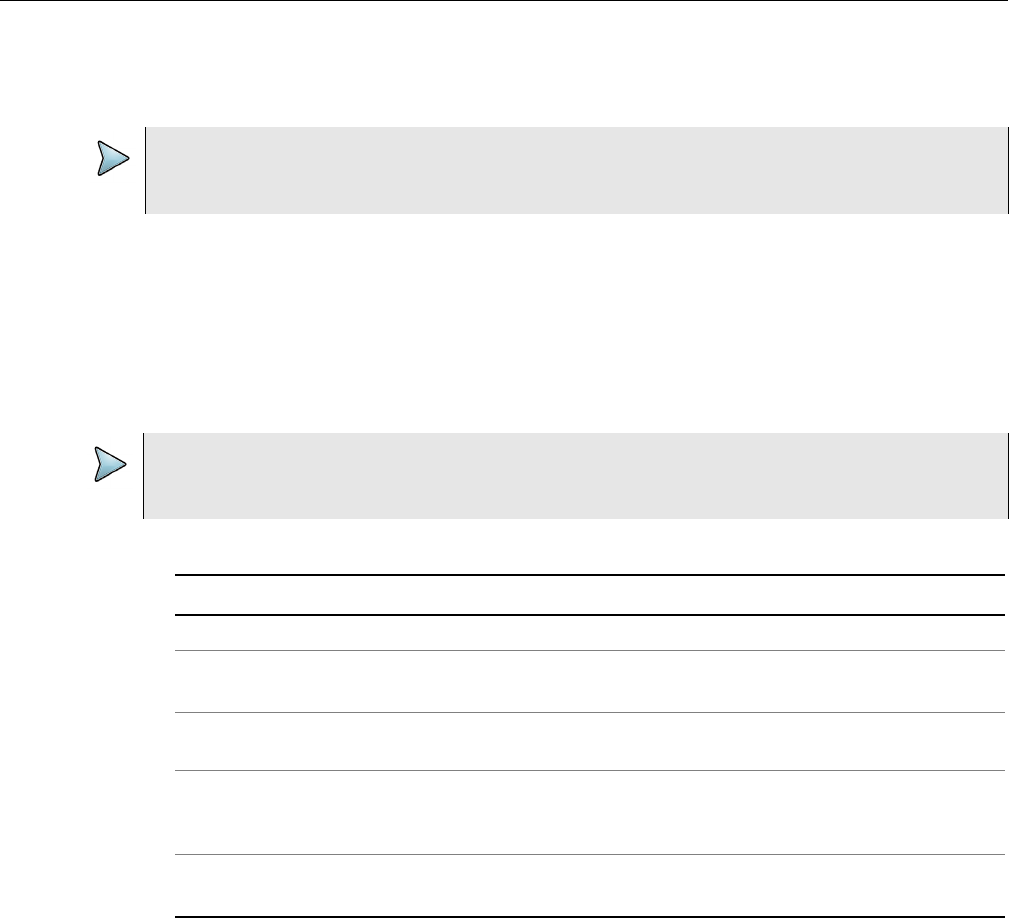
Chapter 12 IP Video Testing
Specifying test settings
SmartClass TPS User’s Guide
May 2014 22035456, Rev 001 97
Specifying test settings
Before you begin testing, make sure the test settings on the SmartClass Triple Play Services match
the settings of the line and network configuration you are testing.
To specify test settings
1From the IP Video menu, select Video Setup, and then specify the settings.
Configuring the settings can be done one of two ways:
– Press a number on the key pad that corresponds to the setting you want to configure.
– Use the arrow keys to highlight the setting you want to change, and then press the OK key.
Press the Cancel key to exit a menu.
The following table describes the settings.
2To specify settings for a particular stream, do the following:
aFrom the Video Setup menu, select the Stream Setup for the desired stream, for example
Stream 1 Setup.
These settings are only available in Terminate Mode.
TIP:
Test configurations can be stored for easy recall and use (see “Managing test configurations” on
page 29).
NOTE:
You must specify the interface settings before specifying Video settings. For example, you must
configure the Data, LAN, and other applicable settings for a xDSL line.
Setting Description
Mode Select Terminate or Monitor mode.
Analysis Type Select Normal or UT Starcom.
Use UT Starcom when analyzing Rolling Stream video streams.
IGMP Version If you are in Terminate mode, specify the version of IGMP signaling being
used on the circuit: version 2 or version 3.
RTSP Port Enter the RTSP port number.
This is the port where RTSP signaling communication takes place in a partic-
ular network.
RTSP Vendor Enter the RTSP vendor.
This setting is only relevant in Terminate mode.

Chapter 12 IP Video Testing
Specifying test settings
SmartClass TPS User’s Guide
98 22035456, Rev 001 May 2014
bSpecify the settings.
The following table describes the settings.
3On the Video Setup menu, select QoS Thresholds, and then specify the settings.
The quality of service (QoS) measurement uses two thresholds – good and poor – to produce
three quality ratings: good, poor, and fair. If the value is less than the good threshold, it is
considered good and is indicated with a check mark. A value between good and poor is
considered fair and is indicated by an exclamation mark. If the value is greater than the poor
threshold, it is considered poor and is indicated by an X.
Additionally, RFC 2680 and RFC 3357 define enhanced analysis methods that are used to
measure the quality of a media stream. There are two main statistics for this: Loss Period and
Loss Distance.
The following table describes the settings.
Setting Description
Stream Type Select the video stream type:
– Broadcast Auto
– Broadcast MPEG2-TS/UDP
– Broadcast MPEG2-TS/RTP/UDP
– Broadcast RTP/UDP
– Broadcast Rolling Stream
– RTSP MPEG2-TS/(RTP)/UDP
– RTSP RTP/UDP
– RTSP RTP/TCP
IP Enter the IP address of the stream. (Not available for RTSP screams.)
Port Number Enter the port number of the stream. (Not available for stream type “Broadcast
Auto” or RTSP streams)
URL Enter the URL for the stream. (Only available with RTSP streams)
Setting Description
Latency Good Enter the Pass threshold, in milliseconds.
Latency is the amount of time between sending the “join” message
and receiving the first video packet on the STB.
Latency Poor Enter the Fail threshold, in milliseconds.
Leave Latency Good Enter the Pass threshold, in milliseconds.
Leave Latency is the amount of time between sending the “leave”
message and receiving the last video packet on the STB.
Leave Latency Poor Enter the Fail threshold, in milliseconds.
Jitter Good Enter the Pass threshold, in milliseconds.
Jitter Poor Enter the Fail threshold, in milliseconds.
Loss Good Enter the Pass threshold, in milliseconds.
Loss Poor Enter the Fail threshold, in milliseconds.
MPEG2-TS Error Ind. Good Enter the Pass threshold.
MPEG2-TS Error Ind. Poor Enter the Fail threshold.
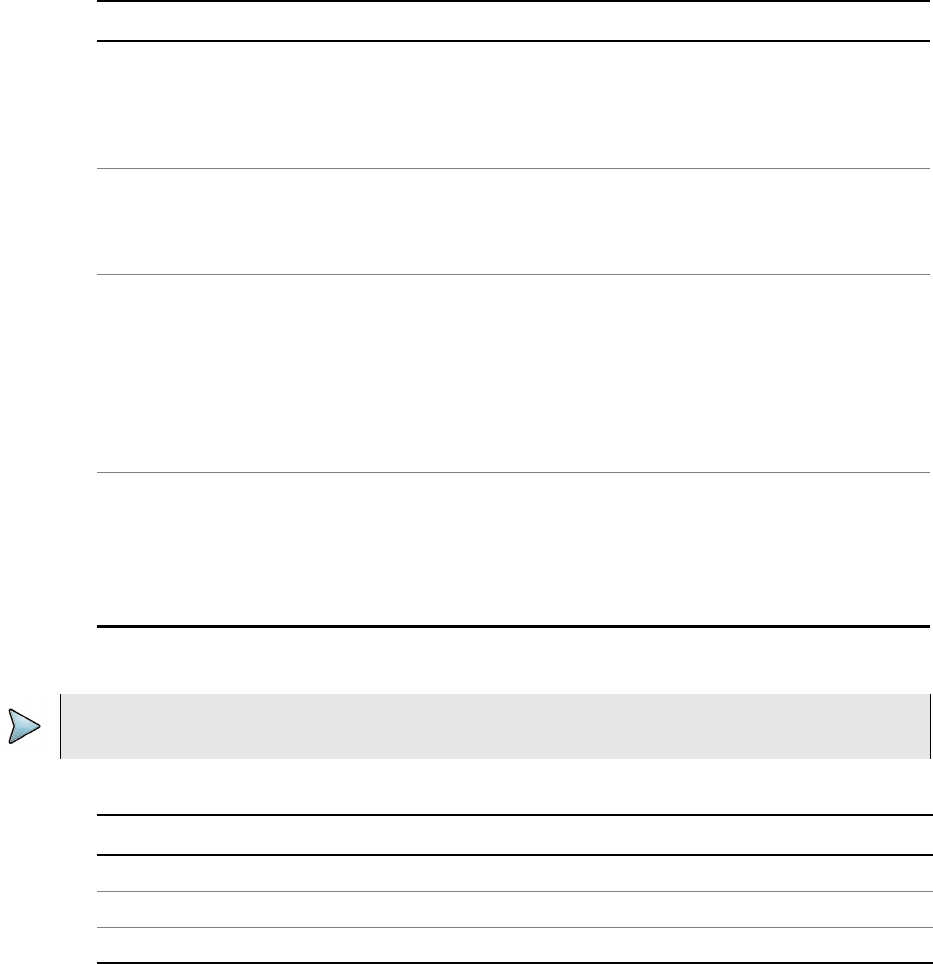
Chapter 12 IP Video Testing
Specifying test settings
SmartClass TPS User’s Guide
May 2014 22035456, Rev 001 99
4On the Video Setup menu, select MOS Setup, and then specify the settings.
The following table describes the settings.
You are finished specifying test settings.
MPEG2-TS PID Timeout Enter the PID Timeout.
This is the amount of time to wait for a PID that has been declared as
having video or audio data for traffic, since the last traffic was
received. If this threshold is violated, then the PID Timeout result will
increment.
MPEG2-TS PAT/PMT Time-
out
Enter the PAT/PMT Timeout.
This is the amount of time to wait after the last received PAT or PMT
packet before declaring a timeout condition (which would then incre-
ment the PAT Errors or PMT Errors statistics)
RTP Loss Distance Enter the Loss Distance threshold, in number of packets.
This triggers when RTP losses cause a RTP LD Error.
“Loss Distance” measures the difference in sequence numbers of
two loss events, with a “loss event” being the loss of one or more
packets in a row. So for the following stream (1 x 3 4 5 x x 8 9 10) the
loss distance between the two events is 4. If the loss distance is less
than the configured threshold, then the “Loss Distance Error” statistic
will increment.
RTP Loss Period Enter the Loss Period threshold, in number of packets.
This triggers when RTP losses cause a RTP LP Error.
“Loss period” is the length of a single loss event, that is, the number
of lost packets between two successfully received packets. So for the
following example stream (1xxx567xx10x12), there are three
loss periods, with lengths of 3, 2, and 1.
Setting Description
NOTE:
When MOS Support is enabled, analysis is limited to one stream.
Setting Description
MOS Support Specify whether MOS Support is enabled or disabled.
ISMA Video Type Specify the type of video codec used for analysis of ISMA streams.
ISMA Audio Type Specify the type of video codec used for analysis of ISMA streams.

Chapter 12 IP Video Testing
Connecting to the line
SmartClass TPS User’s Guide
100 22035456, Rev 001 May 2014
Connecting to the line
After specifying the test settings, you can connect to the line. The procedure is different depending
on the access interface.
– For Ethernet connections, connect as described in “Connecting to the line” on page 44.
– For DSL connections, connect as described in “Connecting to the line” on page 57.
Analyzing video streams
The SmartClass Triple Play Services analyzes the video data packet flow at the packet level. Since
the initial video quality is established by the source material and encoding process at the head end,
and the decoding quality is established by the STB, the effects of the transport and access networks
on the video streams are the variables requiring analysis. Actual video content decoding is not
performed.
After the SmartClass Triple Play Services is setup, it can analyze video performance. Up to three
streams can be simultaneously analyzed in Terminate mode. In monitor mode, up to 3 simultaneous
streams can be analyzed at one time, with statistics available for up to 10 previous streams. To view
statistics on another stream, use the up or down arrow keys.
Terminate mode
In the terminate mode, you can emulate a set-top-box and request broadcast programs.
To run IP video tests in Terminate mode
1Verify that the network connection is established.
2From the IP Video menu, select Stream 1 Results (or your desired stream number).
3Select Start Stream to request the program material.
This initiates the IGMP signaling protocol sequence. The state of the IGMP messaging is
shown on the screen. Typically, the status will change from Idle to Media Wait to Stream
Up.
4To view additional results, do one of the following:
– Press the right arrow.
–Press the Cancel key, and then select either Stream Results (to view results per stream) or
Video Results (to view total video results).
5To save a test report, press the utility (i) key and then select Save Report, and then specify
the report settings such as report name, report format, technician ID, location, and other
settings as needed.
6To clear (or reset) the results, use the * key.
This will either Clear Stream if you are on a Stream Results menu or Clear Stats if you are on
the Total Video Results menu.
See “Video results” on page 134 to learn what your results mean.
NOTE:
The data connection must be established for video streams to be visible to the SmartClassTriple
Play Services and the video statistics screens to show activity.
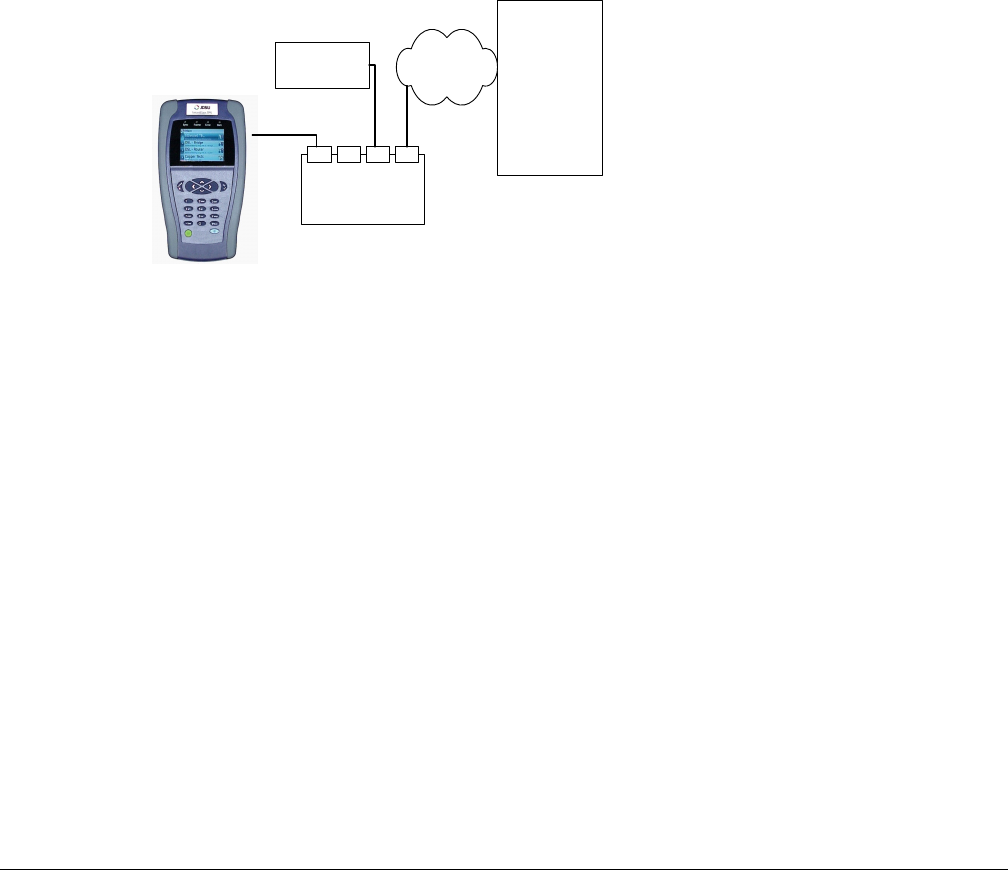
Chapter 12 IP Video Testing
VideoCheck test
SmartClass TPS User’s Guide
May 2014 22035456, Rev 001 101
Monitor mode
In the monitor mode, up to 3 simultaneous streams can be analyzed at one time, with statistics avail-
able for up to 10 previous streams.
If monitoring on an Ethernet interface, you may need an Ethernet hub (such as a NETGEAR®
EN 104) between the CO and the set-top-box, as shown in Figure 18 below.
To run IP video tests in Monitor mode
1Verify that the network connection is established.
2From the main Video menu, select a result menu.
– To view results for a specific stream, select Stream 3 Results (or the desired stream
number).
– To view total results for all streams, select Video Results.
3Use the left or right arrow key to scroll through the screens.
4To save a test report, press the utility (i) key and then select Save Report, and then specify
the report settings such as report name, report format, technician ID, location, and other
settings as needed.
5To clear (or reset) the results, use the * key.
This will either Clear Stream if you are on a Stream Results menu or Clear Stats if you are on
the Total Video Results menu.
See “Video results” on page 134 to learn what your results mean.
VideoCheck test
The VideoCheck test is an automated test used to verify the channels are provisioned as the
subscriber requested. See “Running the VideoCheck test” on page 34.
Figure 18 IP video monitoring with a hub
STB
CO
Ethernet Hub
Network
`
Chapter 12 IP Video Testing
VideoCheck test
SmartClass TPS User’s Guide
102 22035456, Rev 001 May 2014

13
SmartClass TPS User’s Guide
May 2014 22035456, Rev 001 103
Chapter 13
Web browser
This chapter describes the optional web browser. Topics discussed in this chapter include the
following:
–“About the web browser” on page 104
–“Browsing the web” on page 104
–“Navigating the browser” on page 104
–“Exiting the browser” on page 106
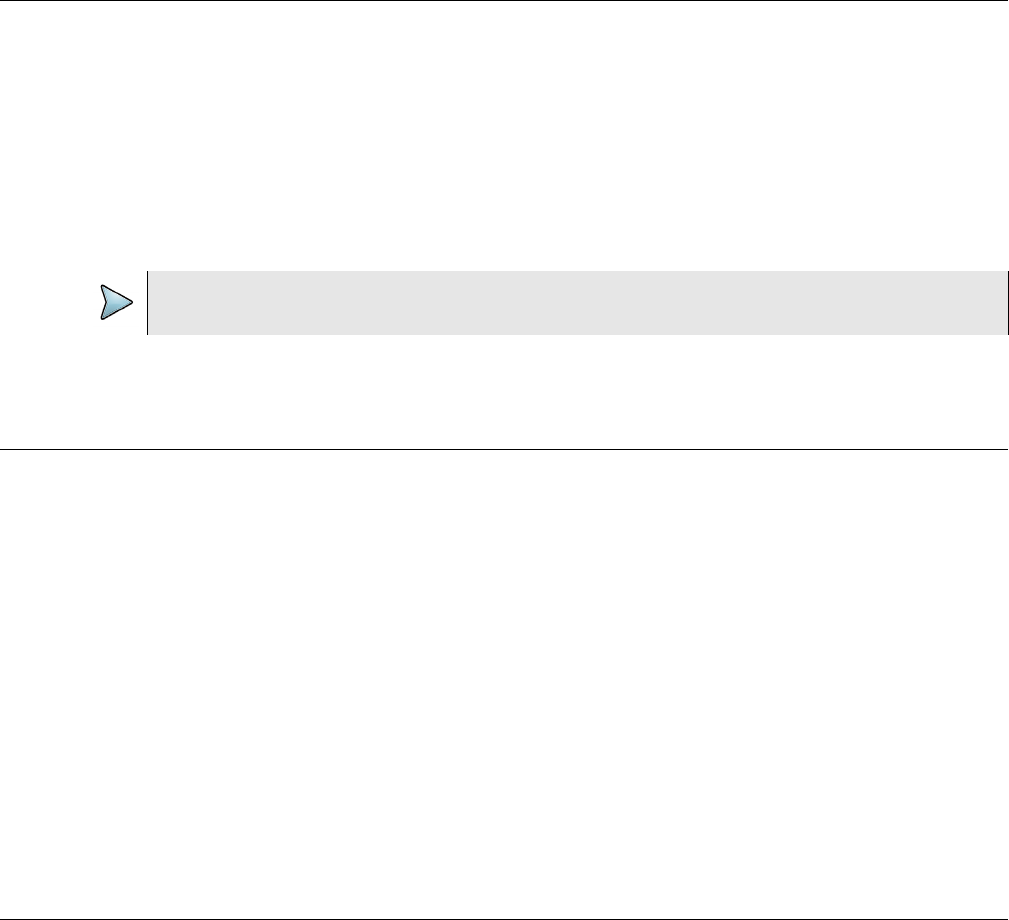
Chapter 13 Web browser
About the web browser
SmartClass TPS User’s Guide
104 22035456, Rev 001 May 2014
About the web browser
With the web browser feature, you can provide visual proof to customers that a circuit is correctly
provisioned all the way to the Internet. The browser works over both DSL and Ethernet interfaces,
allowing you to verify connectivity from the customer's NID or demarcation point using only the
SmartClass Triple Play Services.
Because the browser's primary purpose is to demonstrate connectivity, it does not have all the
capabilities of typical web browsers, such as Internet Explorer or Netscape Navigator (for example,
viewing online video, or viewing secure http “https” sites).
The following sections in this chapter describe how to access and use the web browser.
Browsing the web
Like IP ping, you must have an established underlying network connection, such as Ethernet TE
mode with PPPoE data mode, before you can use the browser. After you have a successful network
connection, the Frame LED turns green. If the Frame LED is off, the underlying connection is not
ready, and the web browser (and IP ping) will not work.
To browse the web
1Select an interface (Ethernet TE, Wi-Fi, DSL-Bridge, or DSL-Modem/Router), and then select
Web Browser.
The Web Browser Setup menu appears.
2Specify the web site address (URL) where you wish to go.
3Select Go.
You are browsing the web.
Navigating the browser
Use the SmartClass TPS keypad to navigate the web browser. The following sections describe how
to use keypad to navigate the web browser.
Scrolling the view
Because of the size of the screen, the SmartClass TPS initially displays only the top left section of
a full page. To view other areas of a web page, use the arrow keys to scroll the page view.
NOTE:
The web browser is only available in IPv4 modes (not available in IPv6).
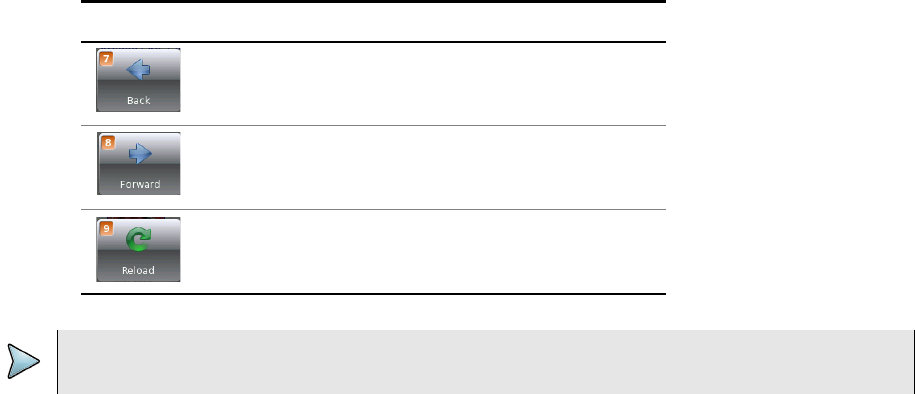
Chapter 13 Web browser
Navigating the browser
SmartClass TPS User’s Guide
May 2014 22035456, Rev 001 105
Selecting links
The following procedure describes how to select a link on a web page.
To select a link
1Navigate the cursor to the link using the arrow keys.
A dotted line box highlights the link.
2Press the OK key.
The screen changes as appropriate.
Moving among or refreshing pages
As with a typical browser, you can move among viewed web pages with the NEXT and PREVIOUS
page buttons. In addition, you can refresh a page. To move among or refresh pages, press the utility
(i) key and then select one of the following.
Typing text in a field
If you wish to enter text in a field on a web page (such as a search bar), the following procedure
describes how to type text.
To type text in a field
1Use the asterisk (*) or pound/hash (#) keys to go to the field.
2Press the OK key.
This enables text entry mode.
3Use the keypad to enter characters.
– Text entry is done the same way as on a cell phone, where repeated presses move among
characters. For example, repeated presses of the 3 key will move among d, e, f, or 3.
– To enter special characters, use the asterisk (*) or pound/hash (#) keys. The same charac-
ters are available with each key, but they scroll in opposite directions.
– When in text entry mode, the arrow keys do the following:
- the down arrow deletes one character to the left (backspace)
Icon Function
Previous page
to go back to the previous page
Next page
to go forward a page
Refresh
to reload the current page
NOTE:
These icons are only available when running the Browser.

Chapter 13 Web browser
Exiting the browser
SmartClass TPS User’s Guide
106 22035456, Rev 001 May 2014
- the up arrow changes the text entry type: lower case (abc), upper case
(ABC), or numeric (123)
- the left and right arrows allow you to move among typed characters
Selecting items in a drop-down list
If you are in a field that uses a drop-down list, the following procedure describes how to select drop-
down items.
To select items on a drop-down list
1Use the asterisk (*) or pound/hash (#) keys to go to the field.
2Press the OK key to select the field.
If this is a field that also allows text entry (such as a search bar, enter a few characters. See
“Typing text in a field” on page 105.
3Press the Cancel key to allow movement up and down the list.
4Use the up and down arrows to navigate to the desired item, and then press the OK key.
The item is selected and the screen changes as appropriate.
Exiting the browser
When you are finished demonstrating internet access to the user, you should exit the browser.
To exit the browser
1Press the Cancel key.
You will get a verification pop-up, asking if you are sure you want to exit.
2Press the OK key.

14
SmartClass TPS User’s Guide
May 2014 22035456, Rev 001 107
Chapter 14
Optical Tools
This chapter describes the optical accessories and how to use them with the SmartClass Triple Play
Services. Topics discussed in this chapter include the following:
–“About the optical tools” on page 108
–“Measuring optical power” on page 108

Chapter 14 Optical Tools
About the optical tools
SmartClass TPS User’s Guide
108 22035456, Rev 001 May 2014
About the optical tools
The Optical Power Meter is a JDSU accessory used to measure optical power.
– The MP-60 meter measures 850, 1300, 1310,1490, and 1550 nm wavelengths
– The MP-80 meter measures 980, 1310,1480, and 1550 nm wavelengths
The features of the Optical Power Meter include:
– Takes power measurements for all single-mode and multi-mode connectors via USB 2.0
connection.
– Measures optical power with multiple pre-calibrated wavelengths.
– Integrates digital power measurements, fiber inspection, and analysis into a single, unified work
sequence.
Measuring optical power
To measure optical power, a Power Meter must be inserted into the USB port.
To measure optical power
1From the Main menu, select Optical Power.
The Optical Power Setup menu appears.
2Specify the settings.
3Connect the Optical Power Meter to the USB connector on the right side of the instrument.
4Connect the optical patch cord to the power meter.
Table 17 Optical Power Meter Settings
Setting Description
Wavelength To measure a specific wavelength, select the wavelength.
Use Auto to automatically detect the wavelength.
NOTE: Auto-Detect requires a JDSU optical source.
Units Specifies the absolute measurement unit: mW or dBm.
LED Threshold Specify the LED threshold (in dBm). This specifies the threshold for the power
LED on the Optical Power Meter. Solid indicates the power is below the thresh-
old (low power), flashing indicates the power is above the threshold.
Pass/Fail Thresh. Specify the pass/fail threshold (in dBm) for the test. If the measured power is
below the threshold, it fails.
Pass/Fail Enable Specify whether to run the pass/fail test.
Meter FW Rev Reports the firmware rev of the attached power meter.
Chapter 14 Optical Tools
Measuring optical power
SmartClass TPS User’s Guide
May 2014 22035456, Rev 001 109
5Select Optical Power Test Menu.
This menu item appears only when an Optical Power Meter is plugged into the USB
connector; otherwise, “Insert USB Power Meter” appears.
The power meter test results appear. The measurement begins as soon as the test is
launched.
6To change the measurement mode to relative mode, press the # key.
This sets the current absolute power level as the new reference value.
7To save a test report, press the utility (i) key and then select Save Report or Save To Job, and
then specify the report settings such as report name, report format, technician ID, location,
and other settings as needed.
For descriptions of the results, see “Optical power results” on page 135.
Chapter 14 Optical Tools
Measuring optical power
SmartClass TPS User’s Guide
110 22035456, Rev 001 May 2014

15
SmartClass TPS User’s Guide
May 2014 22035456, Rev 001 111
Chapter 15
Copper Testing
This chapter provides task-based instructions for using the optional copper testing features. Topics
discussed in this chapter include the following:
–“About copper testing” on page 112
–“Cord compensation” on page 112
–“Specifying Copper settings” on page 113
–“Running a CableCheck” on page 114
–“Performing a snapshot test” on page 114
–“Running copper measurements” on page 115
–“Placing and receiving POTS calls” on page 117
–“Calibrating the unit” on page 117

Chapter 15 Copper Testing
About copper testing
SmartClass TPS User’s Guide
112 22035456, Rev 001 May 2014
About copper testing
The SmartClass Triple Play Services’s optional copper features allow quick turn-up and basic trou-
bleshooting of the copper local loop.
The copper features include two quick tests:
– CableCheck
– Snapshot test
You can also perform specific measurements for the following tests:
– AC volts
– DC volts
– Resistance
– Leakage
– Distance to short
– Opens (distance) and capacitance
– DC current
–Balance
– Load coil detect
– POTS calls
Each of these tests is described in the following sections.
Cord compensation
For greatest accuracy, JDSU recommends that you perform a cord compensation to remove the
effects of the test leads from the test measurements. There are two scenarios for compensation: all
leads open and all leads shorted (resistance).
To compensate for the cords
1From the main menu, select Copper.
2Select Calibration.
3Select which cable compensation you wish to perform: Opens (capacitance) or Short (resis-
tance).
4Follow the instructions on the screen to connect the black, red, and green leads to perform test
lead compensation.
5Press the OK key to begin the compensation.
The compensation stops automatically when finished.

Chapter 15 Copper Testing
Specifying Copper settings
SmartClass TPS User’s Guide
May 2014 22035456, Rev 001 113
Specifying Copper settings
Before running the copper tests, you need to specify copper settings. The following procedure
describes how to specify the Copper settings.
To specify Copper settings
1Select Copper from the Main Menu.
2Select Setup.
The Setup menu appears.
Some of the setup values change, depending on the country settings specified on the Interna-
tional Settings menu.
3Specify the settings.
Configuring the settings can be done one of two ways:
– Press a number on the key pad that corresponds to the setting you want to configure.
– Use the arrow keys to highlight the setting you want to change, and then press the OK key.
Press the Cancel key to exit a menu.
The following table describes the settings.
Setting Description
Default Pair Specify which two leads will be tested.-
Cable Type Specify which type of cable will be tested.
Custom Cable Mutual
(if Custom cable type)
Specify the mutual conversion factor in F/mile (or per km). This is used for Tip-to-Ring (or
A-B) capacitance.
Custom Cable Ground
(if Custom cable type)
Specify the ground capacitance between Tip (A) to Ground (E), and Ring (B) to Ground (E),
in F/mile (or per km). This is used for Tip (A) or Ring (B) to Ground (E) capacitance.
Cable Gauge Specify the gauge of the cable to be tested.
Temperature Specify the temperature of the cable to be tested.
Units Specify which unit of measure to use: Metric or US.
Termination Specify the volt meter measurement impedance.
Limits Specify pass/fail thresholds.
– Specify the Low and High values for AC Voltage.
If the AC result is below the low value, it passes. If the result is above the high value, it fails.
Values between the high and low are marginal.
– Specify the Low and High values for DC Voltage.
If the DC result is below the low value, it passes. If the result is above the high value, it fails.
Values between the high and low are marginal.
– Specify the Low and High values for Resistance.
If the Resistance result is below the low value, it fails. If the result is above the high value, it
passes. Values between the high and low are marginal.
– Specify the threshold value (length) for Opens.
If the Opens result is above the value, it passes.
– Specify the dB limit for Balance and percentage limit for Capacitive Balance.
If the Balance result is below the low value, it fails. If the Capacitance Balance is above the
high value, it fails.
– Specify the percentage (delta from the Balance measurement) for Good Ground Check.
If the Good Ground result is below the value, it fails.

Chapter 15 Copper Testing
Running a CableCheck
SmartClass TPS User’s Guide
114 22035456, Rev 001 May 2014
Running a CableCheck
The CableCheck is an JDSU out-of-service pair quality test. It automatically performs a series of
tests and compares results to user-defined threshold values and provides a pass/fail indication.
To run a CableCheck
1Connect the Tip (A), Ring (B), and Ground (E) leads to the line under test.
2From the main menu, select Copper.
3Select CableCheck.
The test begins to run the series of tests.
– DVOM (AC/DC volts, resistance, Leakage)
– Opens/Capacitance
–Balance
– Load Coil Detect
– Good Ground Test
As each test runs, the test summary is updated. The summary provides a simple pass/fail indi-
cation.
4To view more detail, use the arrow keys to scroll through the result values.
To learn what your results mean, see “Copper results” on page 135.
5To save a test report, press the utility (i) key and then select Save Report or Save To Job, and
then specify the report settings such as report name, report format, technician ID, location,
and other settings as needed.
Performing a CableCheck is complete.
Performing a snapshot test
The snapshot feature performs a quick test of AC volts, DC volts, and resistance across all pairs (T-
R/T-G/R-G).
To perform a snapshot test
1Connect the Tip (A), Ring (B), and Ground (E) leads to the line under test.
2From the main menu, select Copper.
3Select Snapshot.
The test begins to run.
The test stops automatically when complete.
4To save a test report, press the utility (i) key and then select Save Report, and then specify
the report settings such as report name, report format, technician ID, location, and other
settings as needed.
NOTE:
You can specify the pass/fail threshold values on the Copper> Setup menu.
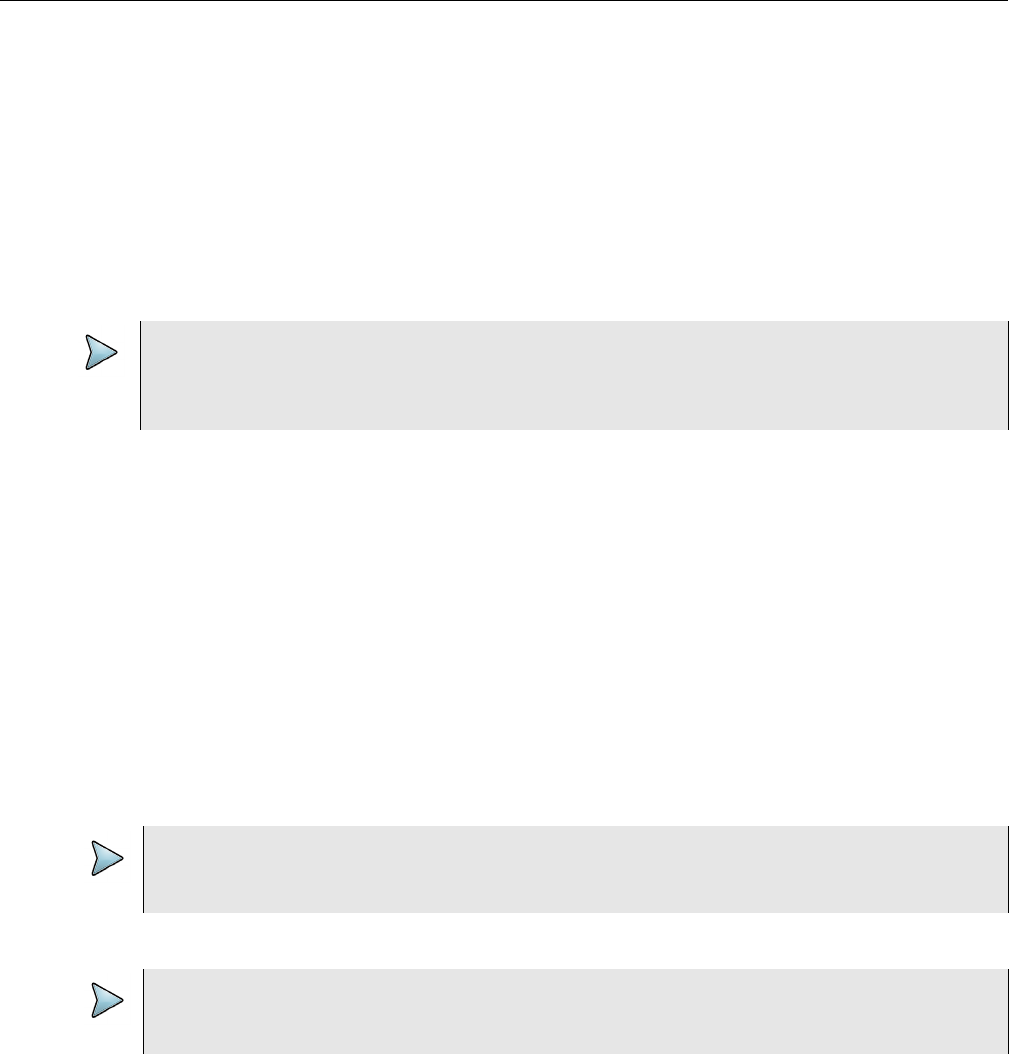
Chapter 15 Copper Testing
Running copper measurements
SmartClass TPS User’s Guide
May 2014 22035456, Rev 001 115
To learn what your results mean, see “Copper results” on page 135.
Running copper measurements
Using the Measure menu, you can individually perform all of the copper measurements. If you want
to skip a measurement, use the down arrow to move to the next test. Use the up and down arrow
keys to change the pair. After a one second pause, the test begins automatically. To clear the results
and restart the test, press the asterisk () key.
To run copper measurements
1Connect the Tip (A), Ring (B), and Ground (E) leads to the line under test.
2From the main menu, select Copper.
3Select Measure.
4Select AC Volts.
The AC voltage test can detect the presence of hazardous voltages, measure induced AC
current from power lines and other AC sources, and measure ringer voltage levels.
After a one second pause, the test begins automatically and results appear on the screen.
5Press the right arrow to move to DC Volts.
The DC voltage test can detect and measure CO/exchange battery current and detect crossed
battery conditions.
After a one second pause, the test begins automatically and results appear on the screen.
6Press the right arrow to move to Resistance.
Resistance should be measured with the battery disconnected, so that the resistance of the
battery itself doesn't affect the measurements.
After a one second pause, the test begins automatically and results appear on the screen.
7If resistance is 4 k or less, use the pound/hash (#) key to measure the Distance to Short.
After a one second pause, the test begins automatically and results appear on the screen.
8Press the right arrow to move to Leakage.
After a one second pause, the test begins automatically and results appear on the screen.
9Press the right arrow to move to Opens.
This test measures the total electrical (capacitive) length of a pair.
NOTE:
This procedure describes how to run all of the measurements in one test sequence. If desired,
you may run a single copper test, such as measuring DC Current only. To do this, from the Mea-
sure menu, select the test you wish to run and then view the results.
NOTE:
The unit will check for damaging voltages before performing the resistance test. If detected, the
unit will display “WARNING! VOLTAGE DETECTED” and will not perform the test.
NOTE:
For the resistive distance to be accurate, it is critical that you enter the correct gauge and tem-
perature (in the COPPER SETUP menu).

Chapter 15 Copper Testing
Running copper measurements
SmartClass TPS User’s Guide
116 22035456, Rev 001 May 2014
After a one second pause, the test begins automatically and results appear on the screen.
10 Press the right arrow to move to DC Current.
This test checks for continuity and checks for proper loop current for POTS lines (to verify if
enough current is present to operate equipment including the phone or caller ID boxes).
After a one second pause, the test begins automatically and results appear on the screen.
11 Press the right arrow to move to Balance.
Balance is a number representing the quality of the telephone circuit and the degree to which
the Tip (A) and Ring (B) conductors are electrically the same in their ability to cancel noise.
The balance measurement is used to identify poor loop quality or cable bonding and
grounding issues that allow excessive loop noise.
After a one second pause, the test begins automatically and results appear on the screen.
12 Press the right arrow to move to Load Coil.
The SmartClass Triple Play Services can detect up to five load coils that may exist on the line,
out to 27,000 (8,200 meters) feet. It will also report a short, open, or a high noise condition, if
detected. For accurate load coil detection, disconnect the pair from the CO/exchange to
remove CO battery/wetting current. Although the detector will work with voltage on a pair,
accuracy will be reduced. In addition, the detector works best when the last coil is followed by
at least 1200 feet (336 meters) of cable.
After a one second pause, the test begins automatically and results appear on the screen.
13 To save a test report, press the utility (i) key and then select Save Report, and then specify
the report settings such as report name, report format, technician ID, location, and other
settings as needed.
To learn what your results mean, see “Copper results” on page 135.
You are finished performing measurements.
NOTE:
When measuring from Tip (A) or Ring (B) to Ground (E), you should connect the Ground (E) lead
to the shield (ground), and be sure to enter the fill type (in the COPPER SETUP menu) or the
distance will not be accurate. If you connect to some other ground that is not parallel to your pair,
and do not enter the appropriate fill type, this measurement will be inaccurate.
NOTE:
A ground connection is required to measure balance.

Chapter 15 Copper Testing
Placing and receiving POTS calls
SmartClass TPS User’s Guide
May 2014 22035456, Rev 001 117
Placing and receiving POTS calls
The POTS dialer allows you to place and receive voice calls to verify that the service is working
properly.
To test voice service
1Connect to the line using the POTS jack.
2From the main menu, select Copper.
3Select POTS Dialer.
4Place a call.
aSelect Touch-Tone Entry, and then use the keypad to enter the number to dial.
bPress the pound/hash (#) key to go off hook and initiate the call.
cOptional. Use the keypad to send DTMF tones.
dPress the asterisk () key to talk, and then speak into the microphone located on the left
side of the unit.
ePress the pound/hash (#) key to go on hook and end the call.
5Receive a call.
aRequest someone to call you.
bWhen the SmartClass Triple Play Services indicates an incoming call, press the pound/
hash (#) key.
cPress the asterisk () key to talk, and then speak into the microphone located on the left
side of the unit.
dPress the pound/hash (#) key to go on hook and end the call.
Testing voice service is complete.
Calibrating the unit
On occasion, your unit may need calibration to maintain accuracy of the copper test functions. For
example, if the test environment changes significantly (such as extreme temperature) and you wish
to maintain the highest accuracy given the new circumstances, perform the self calibration. This
built-in calibration replaces the need for factory calibration.
To calibrate the unit
1From the main menu, select Copper.
2Select Calibration.
3Select Self Calibration.
The SmartClass Triple Play Services performs a self calibration. The self-calibration values
are stored in internal memory.
Press Cancel to return to the Copper Test menu.
Chapter 15 Copper Testing
Calibrating the unit
SmartClass TPS User’s Guide
118 22035456, Rev 001 May 2014

16
SmartClass TPS User’s Guide
May 2014 22035456, Rev 001 119
Chapter 16
Test Results
This chapter describes the test results that are gathered when running a test. To view the different
categories of statistics, use either the left and right arrows, or press the number for the desired result
category. Topics in this chapter include the following:
–“Saving results” on page 120
–“Network Status” on page 121
–“LAN Statistics” on page 122
–“DSL Results” on page 122
–“IP Data results” on page 128
–“Wi-Fi results” on page 129
–“HPNA results” on page 130
–“SmartID results” on page 131
–“VoIP results” on page 132
–“Video results” on page 134
–“Optical power results” on page 135
–“Copper results” on page 135

Chapter 16 Test Results
Saving results
SmartClass TPS User’s Guide
120 22035456, Rev 001 May 2014
Saving results
After running tests, there are two ways to save results:
to a file - used to save the file as text, HTML, or PDF and then export for viewing or printing using
a PC.
to a job - used to associate test results from different applications to a single job
Saving results to a file
After running tests, you can save the results to a report file, and then export for viewing or printing.
To save results to a file
1After your test is finished, press the Utility (i) key, and then press the 5 key.
2Specify the report settings.
If you select Show More, you can enter more detailed information, such as Circuit Name, ID,
and location, as well as Telephone and Fax Numbers.
3Do one of the following:
aPress * to Save the file to internal or USB storage.
bPress # to Save and Send the file to a FTP server.
The report is saved and then the Report Send menu appears.
Verify the server settings, and then press # to send the report.
The test results are stored.
Use the File Browser to copy the file to USB for viewing or printing using a PC.
Saving results to a job
If you ran a Copper Pair Check, HPNA test, SmartID test, DSL test, OneCheck test, or an Optical
Power Meter test, you can save the results to a job.
To save results to a job
1After running a test, press the Utility key, and then select Save to Job.
If the “Save To Job” selection is not available, verify you ran one of the tests listed above. (For
example, Save To Job is not available for Ethernet TE tests, IPVideo tests, and VoIP tests).
The Save Test Result menu appears.
2Select Save Result and then select To Job.
Setting Description
Report Name Specify a file name for the report. The default file name uses the type of test fol-
lowed by a three digit number that increments with each file save (for example,
cablecheck001 or DSL002).
Report File Format Specify the file format for the report: Text, HTML, PDF.
Technician ID Enter the technician ID.

Chapter 16 Test Results
Network Status
SmartClass TPS User’s Guide
May 2014 22035456, Rev 001 121
3Verify the circuit ID and other job information. If there is no active job, a popup appears, asking
you to create and activate a job. If the job information is not the desired job, return to the Job
Manager screen and activate the desired job.
4If you ran a Copper or DSL test, select Location, and then specify where the test was
performed (for example, Crossbox, Splitter, or RG).
The SmartClass TPS returns to the last viewed result screen.
Network Status
Table 18 describes the Network Status results.
Table 18 Network Status results
Result Description
Network Status Status of the connection. If testing in Router mode, there are separate status
indications for WAN and LAN.
LAN x If using Multi-VLAN, reports the status of up to three LAN connections.
IP Address The SmartClass Triple Play Services's IP address to the access the provider net-
work. (IPv4)
Global If using IPv6oE, this is the SmartClass Triple Play Services's IP address to the
access the global network, beyond the router.
Local If using IPv6oE, this is the SmartClass Triple Play Services's IP address to the
access the local network.
Subnet prefix If using IPv6oE, this is the length of the subnet prefix.
Netmask The SmartClass Triple Play Services’s netmask address. IP devices use a net-
mask IP address to determine if IP packets are to be routed to other networks or
sub-networks. (IPv4)
Gateway The SmartClass Triple Play Services's gateway address. When an IP device has
determined that a packet is not addressed to it or devices on the same sub-net-
work (subnet), it sends all such packets to the gateway address for further routing
to the correct address.
DNS Domain Name Services. When using internet addresses such as www.jdsu.com,
the SmartClass Triple Play Services (and all IP devices) must translate to an IP
address (such as 157.234.12.20) in order to route the packets or data. To do so, it
first requests a DNS server to translate an internet address into an IP address;
then the SmartClass Triple Play Services can correctly route IP pings or other data.
The DNS address must be that of a real DNS server, preferably in the provider net-
work.
MAC Address The MAC address of the LAN.

Chapter 16 Test Results
LAN Statistics
SmartClass TPS User’s Guide
122 22035456, Rev 001 May 2014
LAN Statistics
Table 19 describes the LAN Statistics.
DSL Results
The following section describes the results available in DSL mode. To view the different categories
of statistics, use either the left and right arrows, or press the number for the desired result category.
Summary
This category provides a summary of the most frequently used DSL test results. Ta b l e 2 0 describes
the DSL Summary results.
Table 19 LAN Statistics
Result Definition
Link Status Status of the connection.
RX Bytes Total bytes received
RX Frames Total frames received
RX Errors Total errors received
RX Dropped Total dropped frames received
TX Bytes Total bytes transmitted
TX Frames Total frames transmitted
TX Errors Total errors transmitted
TX Dropped Total dropped frames transmitted
TX Collisions Ethernet frames are transmitted “space-available” when there is a break on the sig-
nal on the cable; sometimes frames are transmitted at the same time as another
transmitter, causing a “collision” of frames.
Table 20 DSL Summary results
Result Description Range
Training State The state of modem synchronization (appears in the
menu heading)
Booting, Idle, Init,
Showtime
Trained Mode The DSL line format agreed upon during training
(appears in the menu heading).
T1.413, READSL,
ADSL2+, ADSL2,
G.Lite, G.DMT, VDSL2
Connection Statistics
Actual Rate Current upstream and downstream connection rates 32 kB–3.3 MBa (Up)
32 kB–25 MBa (Dn)
64 kB–50 MB (Up)b
64 kB–100 MB (Dn)b

Chapter 16 Test Results
DSL Results
SmartClass TPS User’s Guide
May 2014 22035456, Rev 001 123
In the saved test report, two additional statistics are included:
–Start Time is the time (time of day) when the DSL modem achieves Showtime. The Start time
is updated if you clear errors.
–Stop Time is the time (time of day) when the report is generated or DSL sync is lost.
Bonded DSL statistics (For Catalogs CSC-TPSVW and CSC-TPSVW-CU only)
For bonded mode, the same results are shown, but the bonded results are separated into different
screens:
– Group - results for both pairs combined
– Pair 1 or Pair 2 - Same results as the non-bonded screen, except the title.
Signal
This category provides statistics for the signal. Table 2 1 describes the DSL Summary results.
Max Rate Maximum upstream and downstream connection
rates
32 kB–3.3 MBa (Up)
32 kB–25 MBa (Dn)
64 kB–50 MB (Up)b
64 kB–150 MB (Dn)b
Capacity The percentage of total bandwidth currently used by
the actual connect rate upstream and downstream.
0–100%
Actual Margin SNR margin upstream and downstream 0–63.5 dB
ATN The degradation of signal strength in dB upstream
and downstream. It is the differ-ence in Tx power from
the transmitter to receiver.
0–126.95 dB (VDLS2)
0–254.9 dB (ADLS2)
Sync Time The elapsed time (duration) since reaching Showtime. n/a
a. These are ADSL2 rates.
b. These are VDSL2 rates.
Table 21 DSL Signal results
Result Description
Sync Count The number of synchronization attempts. it is possible that modems do not syn-
chronize immediately and make multiple attempts before achieving synchroniza-
tion.
Trained Path Whether the modems trained with the FAST or INTLV (interleaved) path.
Loop Length The estimated loop length.a
Vectoring Status V-Configure, V-Full, V-Trigger, V-Running, V-Disabled,
Multiple V-Disabled, V-Unconfigd, V-Unknown
Signal
SATN Signal attenuation. Attenuation average of the bins/tones that contain the actual
signal (empty bins are not included).
Table 20 DSL Summary results (Continued)
Result Description Range

Chapter 16 Test Results
DSL Results
SmartClass TPS User’s Guide
124 22035456, Rev 001 May 2014
SNR Margin
This category provides statistics for the following values in both Up and Down directions.
DSL Errors
Table 23 describes the DSL Errors.
LATN Line attenuation. Attenuation average of all tones/bins (the entire line, including
empty bins/tones).
1MHz ATN Attenuation measured at 1MHz.
Tx Power Power level, in dB, of the VDSL signal, downstream (from the DSLAM) and
upstream (transmitted by the SmartClass Triple Play Services).
INTLV Delay Interleaving depth set by the DSLAM. This is a measure of latency introduced on
the link due to the scrambling of DSL frames to protect data and create a more
reliable link.
Actual INP The INP (Impulse Noise Protection) values negotiated during training.
a. The estimated loop length is a rough estimated based on attenuation. For a more accurate measure of loop length,
use the TDR in Copper mode.
Table 22 SNR Margin results
Result Description
Max Margin The maximum SNR margin upstream and downstream.
Actual Margin SNR margin upstream and downstream.
Min Margin The minimum SNR margin upstream and downstream.
Table 23 DSL Errors
Result Description
FEC Forward Error Correction upstream and downstream for Fast Path and Interleave
Path.
CRC Cyclical redundancy check upstream and downstream for Fast Path and Interleave
Path.
ES Errored Seconds. Number of seconds during which a LOS, SEF, LPR, or CRC
occurred since starting the test.
SES Severely Errored Seconds. Number of seconds during which one or more LOS, SEF,
or LPR errors were present, or 18 CRCs occurred.
UAS Unavailable Seconds. A count of the number of test seconds which met the ITU-T
Rec. G.821 definition of unavailable time.
Table 21 DSL Signal results (Continued)
Result Description

Chapter 16 Test Results
DSL Results
SmartClass TPS User’s Guide
May 2014 22035456, Rev 001 125
DSL Alarms
Table 24 describes the DSL Alarms.
Band statistics
This category only appears for VDSL lines. It provides loop and signal attenuation (LATN/SATN),
SNR margin, and TX power per band.
G.INP statistics
This category provides statistics for DSL retransmission (G.INP). This category is only available in
non-bonded mode and the xDSL standard is VDSL. Table 25 describes the G.INP statistics.
DSL Identity
Table 26 describes the DSL Identity results.
Table 24 DSL Alarm Seconds results
Result Description
LOS Loss of Signal. Number of errored seconds due to loss of signal.
LOF Loss of Frame. Number of errored seconds due to loss of framing.
LOM Loss of Margin Errors. Number of errored seconds due to loss of margin.
Table 25 G.INP statistics
Result Description
Status Reports whether G.INP is in use for upstream or downstream.
Retransmitted DTUs Retransmitted DTUs. The number of retransmitted DTUs that were
received.
Corrected DTUs The number of DTUs the unit received a correction for.
Uncorrected DTUs Uncorrected DTUs. The number of DTUs that did not get a retransmission
(not received within the time limit).
INP Rein The effective impulse noise protection (INP) as a result of G.INP support.
Table 26 DSL Identity results
Result Description
ATU-C or VTU-O Vendor CO vendor code (ATU-C for ADSL, VTU-O for VDSL)
ATU-C or VTU-O Revision CO revision number (ATU-C for ADSL, VTU-O for VDSL)
xTU-R SW Revision SW revision of the local modem (ATU-R for ADSL, VTU-R for VDSL)
xTU-R PHY Revision PHY firmware revision for the local modem (ATU-R for ADSL, VTU-R for
VDSL), based on the setup.
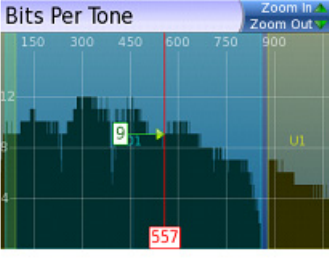
Chapter 16 Test Results
DSL Results
SmartClass TPS User’s Guide
126 22035456, Rev 001 May 2014
Tone Graphs
The graphs provide a graphical representation of the following:
– SNR (signal to noise ratio) Per Tone
– Bits Per Tone (BPT)
Figure 19 provides an example of a Bits Per Tone graph.
– QLN (quiet line noise) Per Tone (Broadcom only)
– Hlog Per Tone (Broadcom only). If a bridged tap is found, press the Utility key and then select
Calculate Bridge Tap Length. The bottom number on the cursor display changes from frequency
and tone to frequency and length (for example, “2.10 MHz (486)” changes to “2.10 MHz (77
ft)”).
Navigating the graph
To view the cursor
– Press the OK key when viewing the graph.
The cursor appears (the red line in Figure 19).
The number at the bottom indicates the cursor location (tone 557 in Figure 19). The upper number
indicates the numeric value (BPT=9 in Figure 19). Use the left and right arrows to scroll among the
tones.
To zoom
– Press the up arrow to zoom in or the down arrow to zoom out.
Troubleshooting using the graphs
The SNR graph indicates line quality. The BPT graph indicates the total bit rate and is a useful tool
for finding disturbers. Bits per tone is defined as bits assigned per DMT tone.
Examine the portions of the graphs where there are dips or breaks. These dips represent areas
where interference is degrading the DSL signal.
Figure 19 Bits Per Tone graph

Chapter 16 Test Results
DSL Results
SmartClass TPS User’s Guide
May 2014 22035456, Rev 001 127
Table 27 lists common noise sources and the corresponding frequencies and tones.
ATM results
ADSL typically transports data over ATM (Asynchronous Transfer Mode) circuits. (VDSL, as well as
some ADSL systems transmit over packet mode circuits.) The ATM category provides results that
help you troubleshoot these connections. These results are helpful if IP pings are not working, but
your tester is still sending and receiving ATM cells.
Cell Count
Table 28 describes the ATM Cell Count results.
Errors
Table 29 describes the ATM Error results.
Table 27 Noise sources and tones
Noise Source Noise Frequency (kHz) Tone # Tone Frequency (kHz)
ISDN BRI 40 9 38.8125
HDSL passband center 196 45 194.0625
HDSL passband max 392 91 392.4375
HDSL2 274 64 276
T1 passband center 772 179 772
E1 passband center 1024 237 1022
Table 28 ATM Cell Count results
Result Definition
User Number of cells that contain user data.
OAM Number of cells that contain OAM data.
Bad Number of bad cells received.
Dropped Total number of dropped cells. The ATM network will discard or “drop” erred cells
which must then be retransmitted (this is done automatically). The SmartClass Triple
Play Services counts the number of ATM cells and how many were dropped, giving an
indication of service quality.
Table 29 ATM Error results
Result Definition
HEC Header error correction. Errored ATM cell headers that have been automatically cor-
rected.
OCD Out-of Cell Delineation. Occurs when cells fail to contain a valid HEC (Header Error
Check)
LCD A Loss of Cell Delineation. Initially triggered when an OCD condition occurs and
doesn't clear for more than 4ms.

Chapter 16 Test Results
IP Data results
SmartClass TPS User’s Guide
128 22035456, Rev 001 May 2014
IP Data results
The following section describes the results available in IP Data mode. To view the different catego-
ries of statistics, use either the left and right arrows, or press the number for the desired result cate-
gory.
Ping results
Table 30 describes the ping results.
File Transfer results
Table 31 describes the File Transfer results.
Table 30 IP Ping results
Result Definition
Destination Destination address where the ping is being sent.
Message Status message.
Echos TX The number of ping messages sent.
Replies RX The number of echo reply messages returned to the SmartClass from the desti-
nation.
Replies Lost The number of pings that did not return to the SmartClass Triple Play Services.
This could be caused by an unresponsive target (destination) or by heavy con-
gestion on the network; the more packets lost the more congested the network,
indicating slow or poor throughput.
Replies Lost % The percentage of lost echos compared to echos sent.
Echos RX The number of ping messages sent to the Triple Play Services from other
devices on the network.
Ping Time The current, minimum, maximum, and average time in milliseconds it has taken
one transmitted ping to reach its destination and receive a reply back to the
SmartClass Triple Play Services.
Table 31 File Transfer results
Result Description
Status The status of the transfer.
Percent Transferred The percentage of the file that has been transferred.
File Size Size of the file being transferred.
Bytes Transferred The number of bytes transferred.
Transfer Rate The speed that the file was uploaded or downloaded.
Total Transfer Time The total time it took for the entire transfer, from beginning to end.
Pretransfer Time The number of seconds of processing elapsed before the transfer began.
Start Transfer Time The time that the transfer began.
Name Lookup Time The number of seconds it took to lookup the name.
Connection Time The time that the transfer began.

Chapter 16 Test Results
Wi-Fi results
SmartClass TPS User’s Guide
May 2014 22035456, Rev 001 129
Traceroute results
Table 32 describes the trace route results.
Wi-Fi results
The following section describes the results available in Wi-Fi mode.
Status
Table 37 describes the status results. The status may be included on the Access Point Status menu
or the End Point Status menu.
Redirect count The number of times the client was redirected.
HTTP Code HTTP status code message
Header Size Number of bytes in the header
Request Size Number of bytes in the request message
Table 32 Trace route results
Result Definition
State Current state of the trace
Number of hops The number of points crossed from the source to the destination
Table 31 File Transfer results (Continued)
Result Description
Table 33 Status
Result Definition
Status Indicates the link status.
Scanning – Scanning for the SSID configured in setup
Associating – associating to a BSS
Associated – Associated to a BSS. However, the link is not fully up yet.
WPA Handshake – Completing the WPA handshake to set up encryption
Link up – Link is fully up.
SSID The Wi-Fi network ID that you are connected to.
BSSID The access point MAC address.
Signal Strength The strength of the signal, in dBm.
Protocol The Wi-Fi protocol in use (such as IEEE 802.11bg).
Channel The 802.11b/g channel the particular BSS is operating in.
Encryption Type The type of encryption (WPA/WEP)
Maximum BW The maximum bandwidth available on the network.
Network Status Status of the data network.

Chapter 16 Test Results
HPNA results
SmartClass TPS User’s Guide
130 22035456, Rev 001 May 2014
Results
Table 37 describes the End Point result
HPNA results
The following section describes the results available in HPNA mode.
Table 35 describes the HPNA results.
Connection duration The amount of time the instrument has been connected to the Wi-Fi network.
IP address The IP address assigned to the instrument by the network.
Netmask The instrument’s netmask address. IP devices use a netmask IP address to
determine if IP packets are to be routed to other networks or sub-networks
Gateway The instrument’s gateway address. When an IP device has determined that a
packet is not addressed to it or devices on the same sub-network (subnet), it
sends all such packets to the gateway address for further routing to the correct
address.
DNS Domain Name Services. When using internet addresses such as
www.jdsu.com, the SmartClass Triple Play Services (and all IP devices) must
translate to an IP address (such as 157.234.12.20) in order to route the packets
or data. To do so, it first requests a DNS server to translate an internet address
into an IP address; then the SmartClass Triple Play Services can correctly route
IP pings or other data. The DNS address must be that of a real DNS server,
preferably in the provider network.
MAC Address The MAC address of the LAN.
Connected Devices The number of devices connected to the Wi-Fi network.
Table 34 End Point results
Result Definition
Status Indication of the status of the Wi-Fi link
Rx & Tx Results
Bytes Total bytes received or transmitted.
Frames Total frames received or transmitted.
Errors Number of errors received or transmitted.
Dropped Number of dropped bytes received or transmitted.
Collisions Number of transmit collisions
Table 33 Status (Continued)
Result Definition
Table 35 HPNA results
Results Description Units Range/Values
Station ID -> ID This is a directional indication of each link denoted by
each node ID
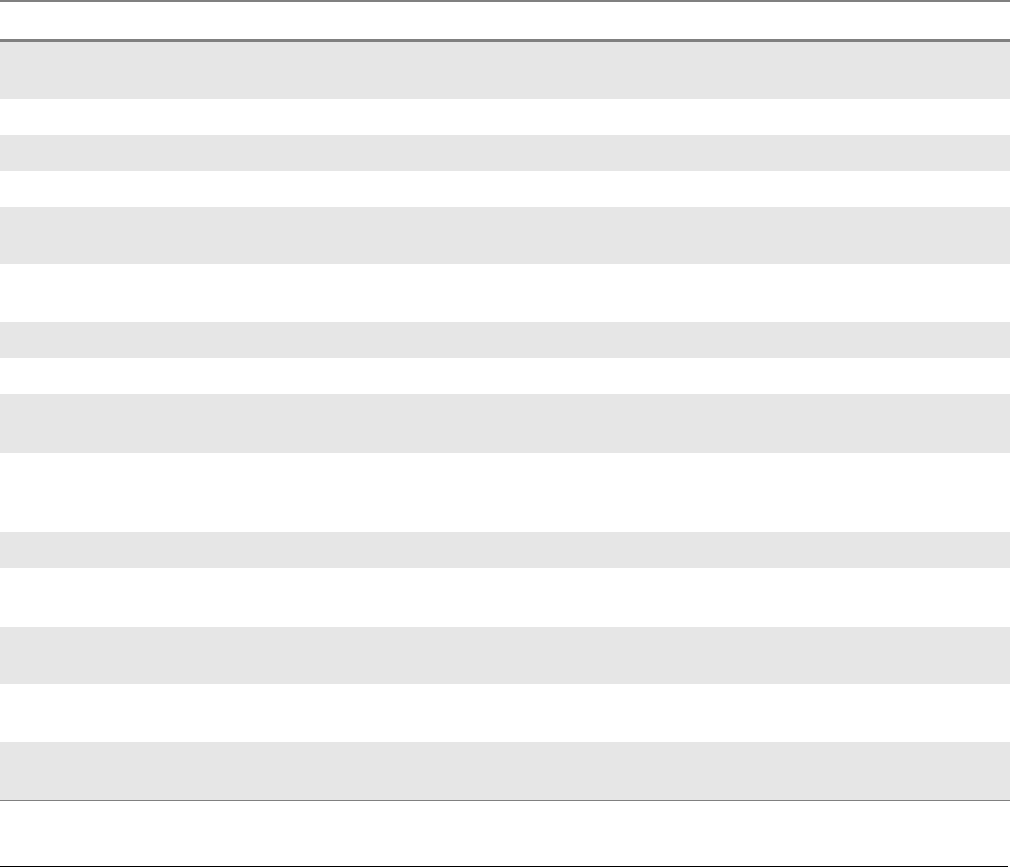
Chapter 16 Test Results
SmartID results
SmartClass TPS User’s Guide
May 2014 22035456, Rev 001 131
SmartID results
The following section paragraphs describes the results available in SmartID tests.
Test Summary
This category provides an overview of the results, including basic pass/fail indications of the links
between the SmartIDs. Use the arrow keys to navigate and highlight a section. The details for that
section appear. If you navigate to a section/link that failed, the results on the left update and you
can see which measurement failed.
Detailed View
This category shows detail of the selected section/link of the network between two SmartIDs. Use
the # key to reverse the direction (change the focus from the near end of the cable to the far end).
Rate, Mod Mbps This is the current data rate, and baud/constellation of the
specific link.
Mbps, MBaud/bits
per symbol
0-112, 2-24/2-10
PER The Packet Error Rate on the specific link. Rate x.xxe+yy 0.00e0 - 1.00e0
SNR This is the Signal to Noise Ratio of the specific link. dB
Receive and Transmit Results
bytes The number of total (good and bad) transmitted or
received bytes
Bytes
packets The number of total (good and bad) transmitted or
received packets.
Packets
bcast The number of transmitted or received broadcast packets. Packets
mcast The number of transmitted or received multicast packets. Packets
dropped The number of transmitted or received packets dropped
due to lack of resources.
Packets
crc The number of received packets that have had an invalid
checksum.
(NOTE: There is no count for transmitted packets)
Packets
Protocol Messages
ctrl_log_req The number of control requests from the local host (CERT
protocol.)
ctrl_log_rec The number of control replies to the local host (CERT pro-
tocol.)
ctrl_rem_req The number of control requests from a remote host
(CERT protocol.)
ctrl_rem_rec The number of control replies to a remote host (CERT
protocol.)
Table 35 HPNA results (Continued)
Results Description Units Range/Values

Chapter 16 Test Results
VoIP results
SmartClass TPS User’s Guide
132 22035456, Rev 001 May 2014
Network Map
This category shows the layout of the network. The SmartID connected to the <product name> is
on the left and the home network cascades to the right. Use the up and down arrow keys to select
different SmartIDs on the map. Press OK to see details of a particular segment.
Sweep Data
This category shows a graph of the frequency sweep. Use the # key to reverse the direction.
VoIP results
The following section describes the results available in VoIP mode. To view the different categories
of statistics, use either the left and right arrows, or press the number for the desired result category.
Call Information results
Table 37 describes the Call Information results.
Throughput
Table 37 describes the Throughput results.
Audio Delay
Table 37 describes the Audio Delay results.
Table 36 Call Info results
Result Definition
Call Duration Length of time for the current call. If the call duration continues beyond
59:59 (meaning, is more than an hour), the display changes from mm:ss to
hh::mm (note the change from : to :: ).
Far End Information The IP address, ID Name, Alias, and Connect method for the incoming call.
Audio Parameters The receive and transmit codec being used, whether RTCP is being used for
the Audio or Video path, and whether silence suppression is enabled.
Table 37 Throughput results
Result Definition
Local Audio Bytes Total number of bytes transmitted (TX) or received (RX)
Local Audio Packets Total number of packets transmitted (TX), received (RX), lost, or out of
sequence (OOS).
Table 38 Audio Delay results
Result Definition
Incoming Audio Codec The audio codec used for the incoming call

Chapter 16 Test Results
VoIP results
SmartClass TPS User’s Guide
May 2014 22035456, Rev 001 133
Audio Quality Scores
Table 39 describes the VoIP Audio Quality Score results. These results relate to one call.
To view audio quality scores for multiple calls, select Multi-Call Quality Stats. The same results will
be reported as above with the minimum, maximum, and average results for the calls. The two “Best
Possible” results aren’t included because they don’t apply to multi-call results.
Network Delay Time, in milliseconds, needed to travel the network (only displayed when a
call is active)
Encoding Delay Time, in milliseconds, needed to convert samples in selected codec form
Packetization Delay Number of milliseconds needed to fill the frame(s) comprising one RTP data
packet
Buffering Delay Time, in milliseconds, that the data was held in a jitter buffer
Total Delay Total of all delays
Table 39 Audio Quality Score results
Result Definition
Best Possible CQ MOS The best conversation quality (CQ) mean opinion score (MOS) possible
CQ MOS Current conversation quality mean opinion score
LQ MOS Current listener quality mean opinion score
PQ MOS Current packet quality mean opinion score
Best Possible CQ R Factor The best conversation quality R factor possible
CQ R Factor Current conversation quality R factor
LQ R Factor Current listener quality R factor
G.107 R Factor Current G.107 R factor
Burst R Current burst R factor
Gap R Current gap R factor
Table 38 Audio Delay results (Continued)
Result Definition
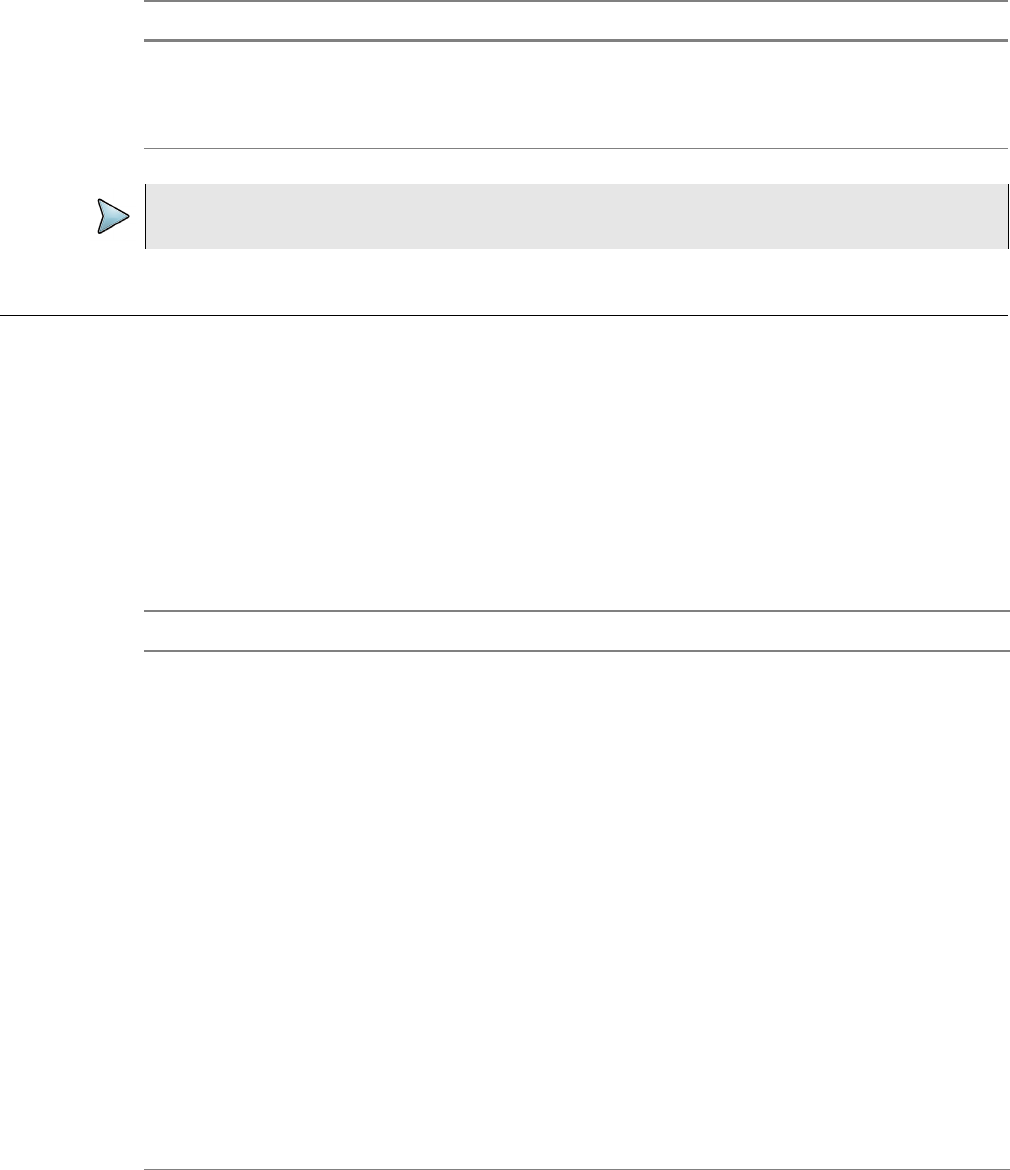
Chapter 16 Test Results
Video results
SmartClass TPS User’s Guide
134 22035456, Rev 001 May 2014
Local and Remote QoS
This category provides quality of service (QoS) test results. The Local QoS reports what we receive
(in the test set), while the Remote QoS reports what they receive (at the far end). Tabl e 2 0 describes
the QoS results.
Video results
The following section describes the results available in IP Video mode. To view the different cate-
gories of statistics, use either the left and right arrows, or press the number for the desired result
category.
Stream Results
This category provides statistics for each test stream. Ta b l e 4 2 describes the Video Stream Results.
Table 40 QoS results
Result Definition
Delay End to end delay in milliseconds
Jitter Deviation in packet arrival times, in milliseconds)
Loss Packet loss based as a percentage lost divided by total packets
NOTE:
The Delay result is only calculated if the RTCP signaling is active.
Table 41 Stream results
Result Description
State Status of the stream
–Stream Up - Active
–Idle - No active stream
–Failed - A stream is no longer detected.
All streams brought up using RTSP protocol will eventually reach the Failed
state. This is because the SmartClass Triple Play Services does not detect
RTSP termination messages or RTSP messages used for special features
such as pause.
Media Type The type of media detected:
–udp (for MPEG-2 TS Video over UDP)
–rtp (MPEG-2 TS Video over RTP)
Media IP The IP address of the stream.
Media Port The RTSP port of the stream.
NOTE: The State, Type, IP address, and Port results refer to the media stream, not the signaling protocol
(IGMP or RTSP) that brought up the stream.
Packet Loss Stats Current, Maximum, and Total Packet Gap Errors, as well as the Maximum
Packet Gap in ms.
Packet Jitter Stats Current and Maximum results for PCR Jitter and IP Jitter.

Chapter 16 Test Results
Optical power results
SmartClass TPS User’s Guide
May 2014 22035456, Rev 001 135
Video Results
This category reports the total number of active video streams and provides the combined total data
rate associated with the ATM Video Virtual Channel selected when configuring the ADSL interface
or the Ethernet port used in the Ethernet mode. The screen provides a quick summary of the total
data rates for all of the video program flows present on the interface under test.
The total video bandwidth (data rate) peaks can be important in analyzing total bandwidth available.
The total bandwidth is found on the ADSL Summary screen. The difference in the two numbers is
the bandwidth available for either Internet data or Internet data and VoIP data.
Table 42 describes the video results.
Optical power results
The optical power is displayed as dBm or mW (depending on your selection on the Setup menu)
along with the Min, Max, and Average. The wavelength is displayed just under the power measure-
ment.
If using relative measurement mode, the received signal is compared to the reference value, and
displays the difference in dB. NOTE: If no reference value has been stored, 0.00 dBm will be used
as reference value.
Copper results
The copper results are described in the tables below.
AC voltage
You measure AC volts to:
Delay Stats The current latency and the maximum latency since the stream became active.
(Latency is the time to complete a program change, in
milliseconds.)
Rate Stats Reports individual bit rates for each portion of the video stream. The “IP
Total” statistics measure the bandwidth used by the video stream,
including the UDP and IP headers.
Table 42 Total video rates results
Result Description
Active Streams Number of active streams
Current Combined Rate The combined rate at this moment.
Maximum Combined Rate The maximum combined rate seen since the start of the test.
Average Combined Rate The average of all combined rates.
Table 41 Stream results (Continued)
Result Description
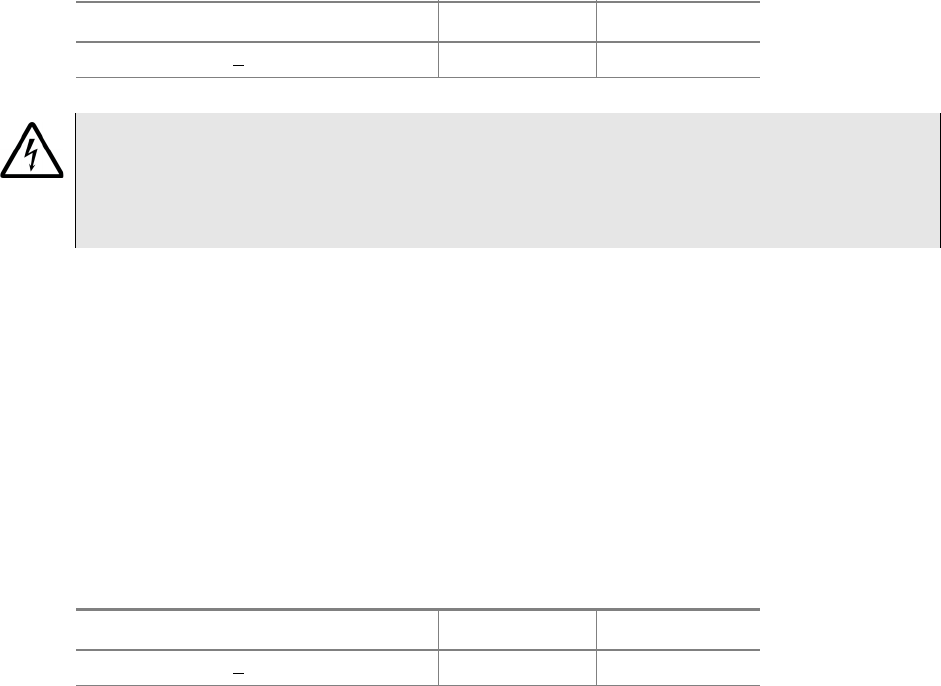
Chapter 16 Test Results
Copper results
SmartClass TPS User’s Guide
136 22035456, Rev 001 May 2014
– detect the presence of hazardous voltage.
– measure stray or foreign voltages.
– measure ringer voltage level.
AC voltage results on Tip (A) to Ring (B) should be 0.0 volts. Tip (A) to ground and Ring (B) to
ground should be equal to each other. Anything else indicates AC signal interference and/or an
unbalanced line.
Table 43 describes the AC voltage result.
DC voltage
You measure DC volts to:
– detect and measure CO/exchange battery voltage.
– detect crossed battery conditions.
To measure DC volts, remove the line battery and measure Tip (A) and Ring (B) to ground. It should
be < 3.0 volts; anything else indicates crossed battery that inhibits digital signals.
Table 44 describes the DC voltage result.
Resistance
You measure resistance to test line continuity and quality, and to detect corrosion, shorts, opens,
and faults.
The SmartClass Triple Play Services is able to measure resistance in the presence of noise and
foreign voltage, but the accuracy may be reduced, depending on the noise level.
Resistance should be measured with the line disconnected, so that the battery voltage and CO/
Exchange termination don't affect the measurement.
Normal resistance should be at least 5 M; lower values indicate the presence of faults.
Table 43 AC Voltage result specifications
Range (VAC) Resolution (V) Accuracy
AC peak + [VDC] < 300 1 2% ± 1.0V
WARNING: INSTRUMENT DAMAGE
Although the SmartClass Triple Play Services is designed to measure hazardous voltage, it is
designed to do so on telecom circuits, not power mains. Hazardous voltages may be on the
power lines. 220 mains (RMS) are equivalent to 308 peak. Connecting to these circuits may
result in damage to equipment or serious injury.
Table 44 DC voltage result specifications
Range (VDC) Resolution (V) Accuracy
AC peak + [VDC] < 300 1 2% ± 1.0V
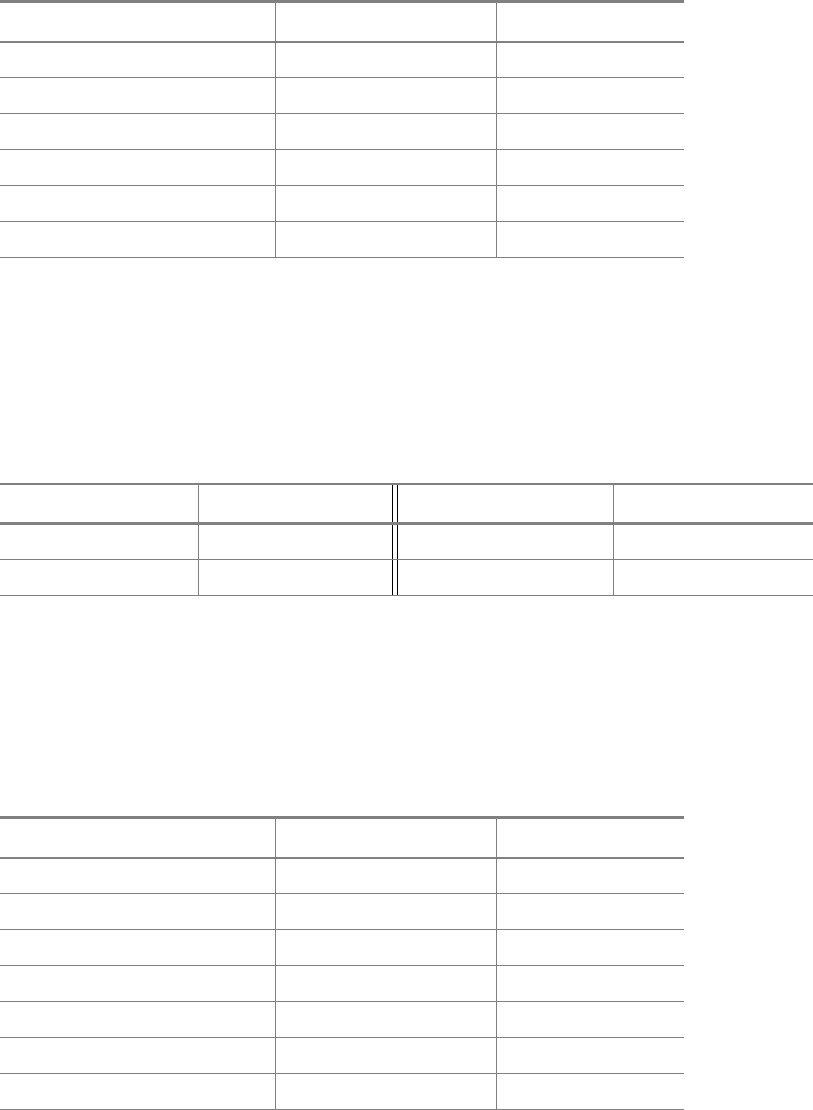
Chapter 16 Test Results
Copper results
SmartClass TPS User’s Guide
May 2014 22035456, Rev 001 137
Table 45 describes the resistance result.
Distance to short
This result measure the distance to the short. A resistance measurement of 4 k or less typically
indicates a short. For values greater than 4 k, this function is disabled.
Table 46 describes the distance to short result.
Leakage
Leakage is a resistance measurement using higher voltage.
Table 47 describes the leakage result.
Opens/Capacitance
You measure opens/capacitance to:
– measure total electrical loop length (includes length of bridged taps).
Table 45 Resistance result specifications (no ambient)
Range () Resolution ()Accuracy
0 to 999 1 2% ± 2.5
1.0K to 9.99K 10 2%
10.0K to 99.9K 100 2%
100.0K to 999K 1K 2%
1.0M to 9.9M 10K 6.5%
10.0M to 100M 100K 10%
Table 46 Distance to short result specifications
Range (feet) Resolution Range (meters) Resolution
0 to 3000 30 feet 0 to 999 9 meters
3000 to 30,000 100 feet 1000 to 10,000 30.5 meters
Table 47 Leakage result specifications (no ambient)
Range () Resolution ()Accuracy
0 to 49.99 1 2% ± 2.5
50 to 999 1 5% ± 2.5
1.0K to 9.99K 10 5%
10.0K to 99.9K 100 5%
100.0K to 999K 1K 5%
1.0M to 9.9M 10K 10%
10.0M to 100M 100K 15%

Chapter 16 Test Results
Copper results
SmartClass TPS User’s Guide
138 22035456, Rev 001 May 2014
– find wet sections, bridged taps or open faults.
Opens/Capacitance: < 3% difference between Tip (A) and Ring (B) values indicate an acceptably
balanced loop. Anything greater indicates an unbalanced line or open fault, which inhibit digital
signals.
Table 48 describes the opens/capacitance result.
DC current
You measure DC current to verify if enough current is present to operate equipment including the
phone or caller ID boxes.
DC current on Tip (A) to Ring (B) should be 23 mA at the NID. Anything less will not allow for differ-
ences in temperature and phone equipment will not operate during extremes.
Table 49 describes the DC current result.
Table 48 Opens/Capacitance result specifications (no ambient)
Range (feet) Resolution
(feet) Range (meters) Resolution
(meters)
Range
(capacitance)
Accuracy (applies to
capacitance only)
0 to 2,999 1 foot 0 to 999 0.1 meter 0 to 44.9 nF 3% ± 45 pF
3000 to 66000 1 foot 1,000 to 20,000 0.1 meter 45 nF to 1.04 µF 3%
Table 49 DC current result specifications
Range Resolution Accuracy
0 to 110 ma 1ma 2% ± 1ma

Chapter 16 Test Results
Copper results
SmartClass TPS User’s Guide
May 2014 22035456, Rev 001 139
Longitudinal balance
You measure longitudinal balance to:
– measure the quality of the pair: a measurement of the degree to which the Tip (A) lead is elec-
trically the same as the Ring (B) lead.
The more each lead is electrically identical (capacitance, inductance, impedance), the better the
pair will resist induced noise.
The balance result should be >60 dB. Anything less indicates electrical differences between Tip (A)
and Ring (B) that can lead to noise and other signal problems.
Table 50 describes the DC current result.
Good Ground check
The good ground check is a ground resistance measurement. It tests whether the ground used for
longitudinal balance is acceptable. The result should be <35dB.
Load coil
You check for load coils to ensure there are no load coils present on a digital line (such as ADSL or
ISDN). Load coil detection and elimination is essential in the installation of an xDSL circuit
Table 49 describes the load coil result.
Table 50 Balance result specifications
Range Resolution Accuracy
35 to 70 dB 1 dB 2 dB
Table 51 Load coil result specifications
Range Resolution Accuracy
Up to 27,000 ft (8229.6 m) up to 5 ± 1
Chapter 16 Test Results
Copper results
SmartClass TPS User’s Guide
140 22035456, Rev 001 May 2014

17
SmartClass TPS User’s Guide
May 2014 22035456, Rev 001 141
Chapter 17
StrataSync
This chapter provides task-based instructions for synchronizing the SmartClass TPS with a central
StrataSync server. Topics discussed in this chapter include the following:
–“About StrataSync” on page 142
–“Synchronizing to the StrataSync server” on page 142
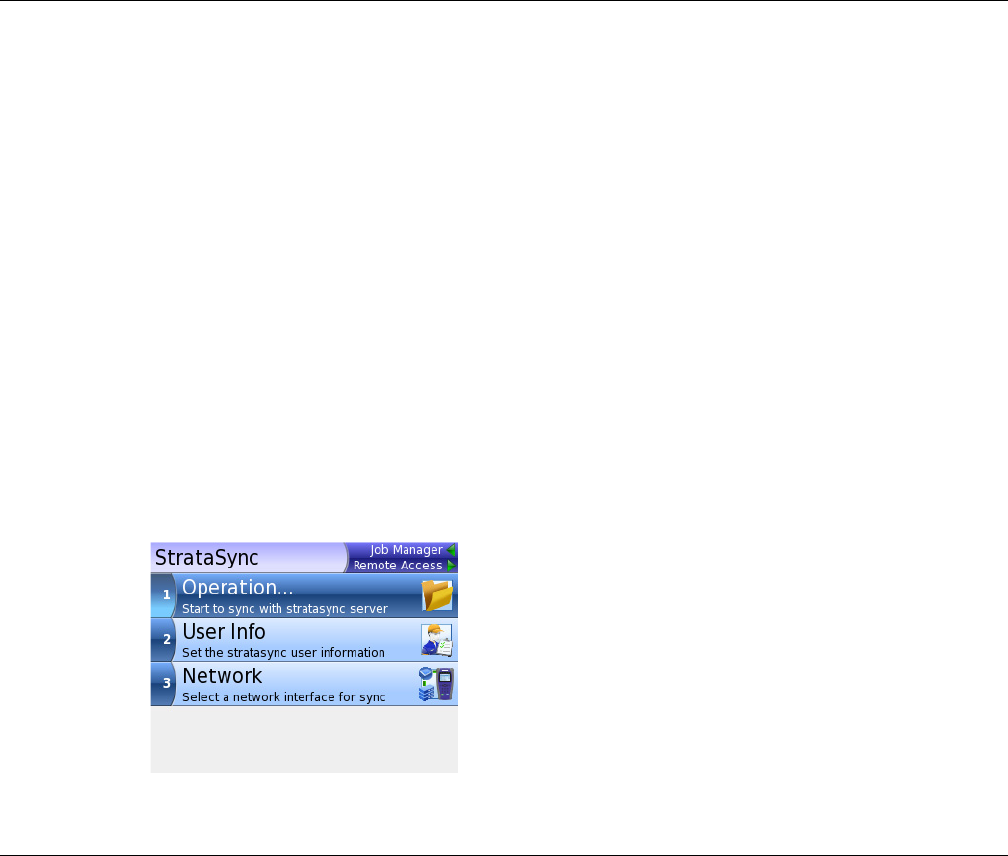
Chapter 17 StrataSync
About StrataSync
SmartClass TPS User’s Guide
142 22035456, Rev 001 May 2014
About StrataSync
StrataSync® is a hosted, cloud-based software application that provides JDSU instrument asset,
configuration, and test-data management. StrataSync manages inventory, test results, and perfor-
mance data anywhere with browser-based ease and improves technician and instrument efficiency.
Features include the following:
– Uploading test results to StrataSync server
– Uploading configuration settings to StrataSync server
– Pushing certain configuration settings to multiple SmartClass TPS units
– Adding and/or removing software options on multiple SmartClass TPS units
– Updating the software on the SmartClass TPS
– Tracking ownership of the SmartClass TPS
To access the StrataSync menu
1From the Main menu, select System Setup.
2Select StrataSync.
The StrataSync menu appears.
Synchronizing to the StrataSync server
To obtain the latest configuration settings, software options and updates, and ownership registration
information, the SmartClass TPS can synchronize with a JDSU server via the internet. The synchro-
nization also stores any user files saved on the unit to the StrataSync server. This procedure should
be undertaken immediately upon receipt of the unit and on a regular (daily) basis thereafter to
ensure that the unit is as up-to-date as possible and to allow all user information to be backed up.
Before attempting to synchronize with StrataSync, please confirm your server settings with your
manger or your company's IT organization.
To sync with StrataSync
1If you haven’t already done so, specify the user information on the User Info menu - from the
StrataSync main menu, select User Info. A valid account ID must be entered in order to
synchronize with the StrataSync server.
2If the network connection has already been set up, the Network entry on the StrataSync menu
will be greyed-out.

Chapter 17 StrataSync
Synchronizing to the StrataSync server
SmartClass TPS User’s Guide
May 2014 22035456, Rev 001 143
If not, from the StrataSync main menu, select Network and then Select Connect With and
specify the access technology through which the SmartClass TPS will be connected to the
network.
– Ethernet
–DSL
–Wi-Fi
3Depending on the access technology specified in the step above, specify the interface to use
for the connection:
For Ethernet, select Network Setup to do the configuration. Refer to “Specifying the network
setup” on page 42 for the definitions of the
parameters.
For DSL, select DSL Setup to do the DSL configuration. Refer to “Specifying DSL settings” on
page 52 for the definitions of the parameters. Next, select DSL Network Setup to do the
network configuration. Refer to “Specifying the modem operation” on page 50, “Specifying
network settings” on page 54, and “Specifying WAN settings” on page 54 for the definitions of
the parameters.
For Wi-Fi, select Wi-Fi Network Setup to do the configuration. SSID is the public name of the
wireless network. Refer to “Specifying the network setup” on page 42 for the definitions of the
rest parameters.
4From the StrataSync main menu, select Operation and then specify additional connection and
server settings.
Setting Description
Connection Type Specify how to connect to the server.
– Lookup – Use an intermediate server that will automati-
cally identify (“lookup”) the specific StrataSync server to
be addressed. The lookup server connection type is typi-
cally used when there are multiple StrataSync servers in
the user’s corporate footprint.)
– Direct – Use a direct reference to a specific StrataSync
server)
NOTE: The SmartClass TPS uses HTTPS (secure HTTP) to
connect to the server.
Server Method Specify how to refer to the server (this applies for both con-
nection types)
– Address Server by IP (192.168.0.1)
– Address Server by Name (myServer)
Server IP/Lookup Server IP, or
Server Name/Lookup Server Name
Enter the server IP/lookup server IP or the server name/
lookup server name on demand.
Server Port/Lookup Server Port Enter the server port number.
Proxy URL Enter the proxy URL. You can leave it blank - as by default
and not using any proxy.
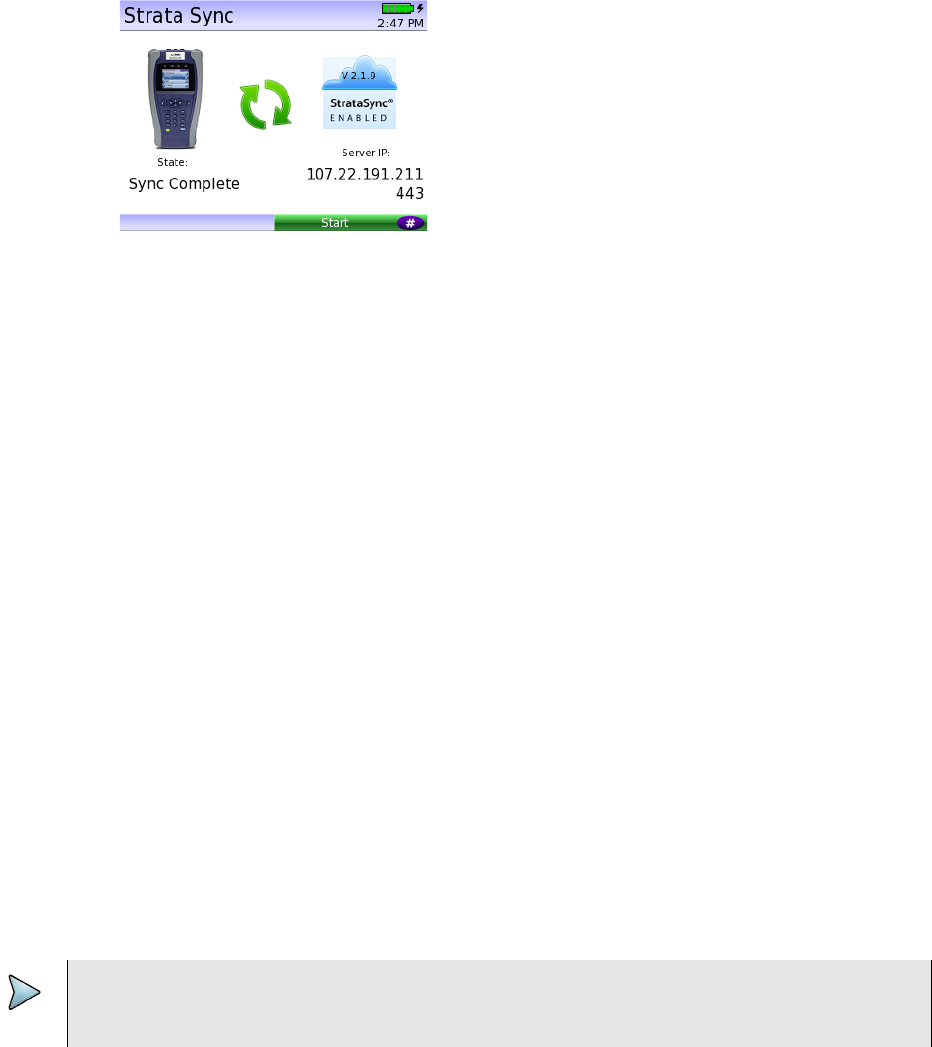
Chapter 17 StrataSync
Synchronizing to the StrataSync server
SmartClass TPS User’s Guide
144 22035456, Rev 001 May 2014
5On the StrataSync screen, press the Sync soft key to start the synchronisation.
As the process runs, the sync state is displayed in the lower left.
The server name or IP and port are shown in the lower right.
The StrataSync software version is displayed on the cloud icon.
You can press the Stop soft key to stop the synchronisation.
6Upon synchronization with the StrataSync server, the unit will send to the server the following
information:
– The unit’s serial number.
– The unit’s hardware information - constituent assemblies and their revision levels.
– The unit’s MAC address.
– The unit’s User settings - name (user/technician) and ID.
If the configuration information contained on the server is newer than that on the unit, the
server will be considered to be the most up-to-date.
7The server will then send any files to the unit being synchronized that it determines are newer
than those on the unit.
8The unit will then send any Reports, Configuration profiles, screen shots, etc. that have been
saved on the unit since the last configuration.
9The server then applies any applicable Options or Configuration Templates to the unit.
When successful, a message box will be displayed.
For applying the option, the message is “New option was deployed to this unit by StrataSync.
It will become effective after the next startup.”
For applying the configuration, the message is “New configuration was deployed to this unit by
StrataSync. It will become effective after the next startup.”
10 Lastly, if any upgrades are available, the user will be informed of their availability and asked to
verify their desire to receive the upgrade.
11 When synchronization is complete, the Status will indicate “Sync Complete”. The unit may be
disconnected from the server.
The unit has been synchronized to the StrataSync Server.
NOTE:
If an Option Code was entered as a part of synchronization, power must be cycled to the unit to
complete the process and initialize the option.

18
SmartClass TPS User’s Guide
May 2014 22035456, Rev 001 145
Chapter 18
Maintenance and Troubleshooting
This chapter describes how to maintain the SmartClass Triple Play Services instrument and its
battery and how to identify and correct problems related to the SmartClass Triple Play Services.
Topics discussed in this chapter include the following:
–“Cleaning the instrument” on page 146
–“Prolonging battery life” on page 146
–“Recharging the battery” on page 146
–“Replacing the battery pack” on page 147
–“Updating the software” on page 148
–“Adding options” on page 149
–“Getting Technical Assistance” on page 149
–“Additional information” on page 150
–“Resolving problems” on page 150
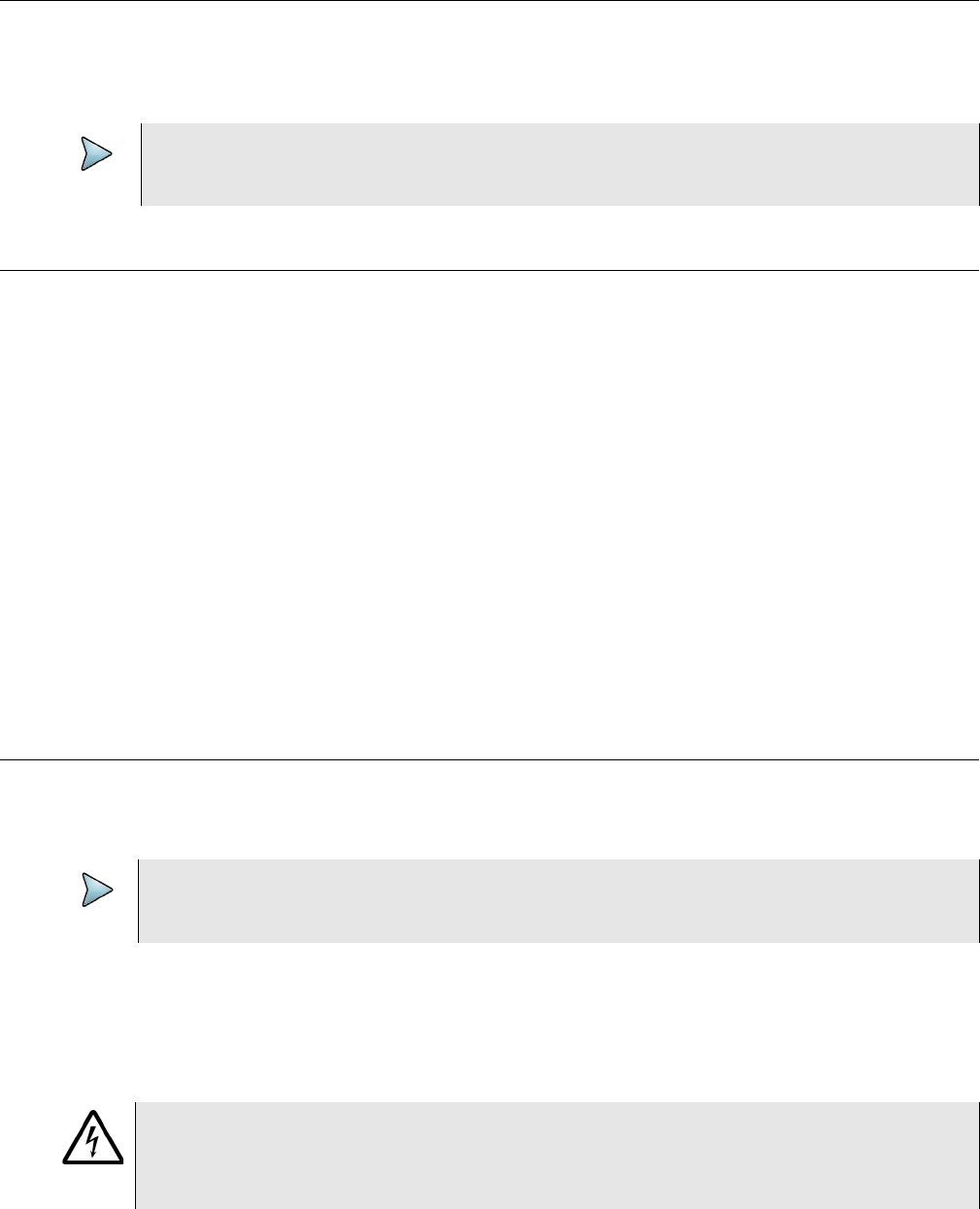
Chapter 18 Maintenance and Troubleshooting
Cleaning the instrument
SmartClass TPS User’s Guide
146 22035456, Rev 001 May 2014
Cleaning the instrument
The instrument itself does not require any specialized cleaning. An occasional wipe with a damp
cloth is sufficient.
Prolonging battery life
The SmartClass Triple Play Services uses a rechargeable Lithium Ion (LiIon) battery pack. To
prolong the life span of any batteries, follow the guidelines below:
– When not connected to the unit, store the battery in a cool, dry, and clean environment. Do not
leave the battery in a car or truck, particularly during extremely hot or cold weather.
– The first time you use the SmartClass Triple Play Services, or after prolonged storage, use the
AC adapter to power the unit.
– If the battery capacity is depleted or if the battery has been stored for a prolonged period,
charge the battery before use.
– If charging the battery while they are in the unit, use the JDSU AC adapter to charge the
batteries. Do not use an un-approved charger.
– The charger will not charge the battery when it is extremely hot or cold.
– Always dispose of batteries properly.
The following section describes how to recharge and replace the batteries.
Recharging the battery
When the Batt LED lights red, the battery should be charged or replaced.
To charge the battery
1Connect one end of the AC adapter to the connector on the bottom of the SmartClass Triple
Play Services.
2Connect the other end of the AC adapter to an AC power supply.
NOTE:
When cleaning the instrument, JDSU recommends a damp cloth and water only. Cleaning with
chemicals could cause damage to the plastic case, buttons, or removal of markings.
NOTE:
You can test a circuit and recharge the battery at the same time. If you do not want to interrupt
the current test, you may leave the power on and connect the AC power adaptor.
WARNING: ELECTRICAL SHOCK
Electrical shock may result in serious injury or death. Be sure the AC Adapter is connected to the
correct voltage mains. Do not use outdoors or in wet locations. Use only the AC Adapter supplied
with the test set.
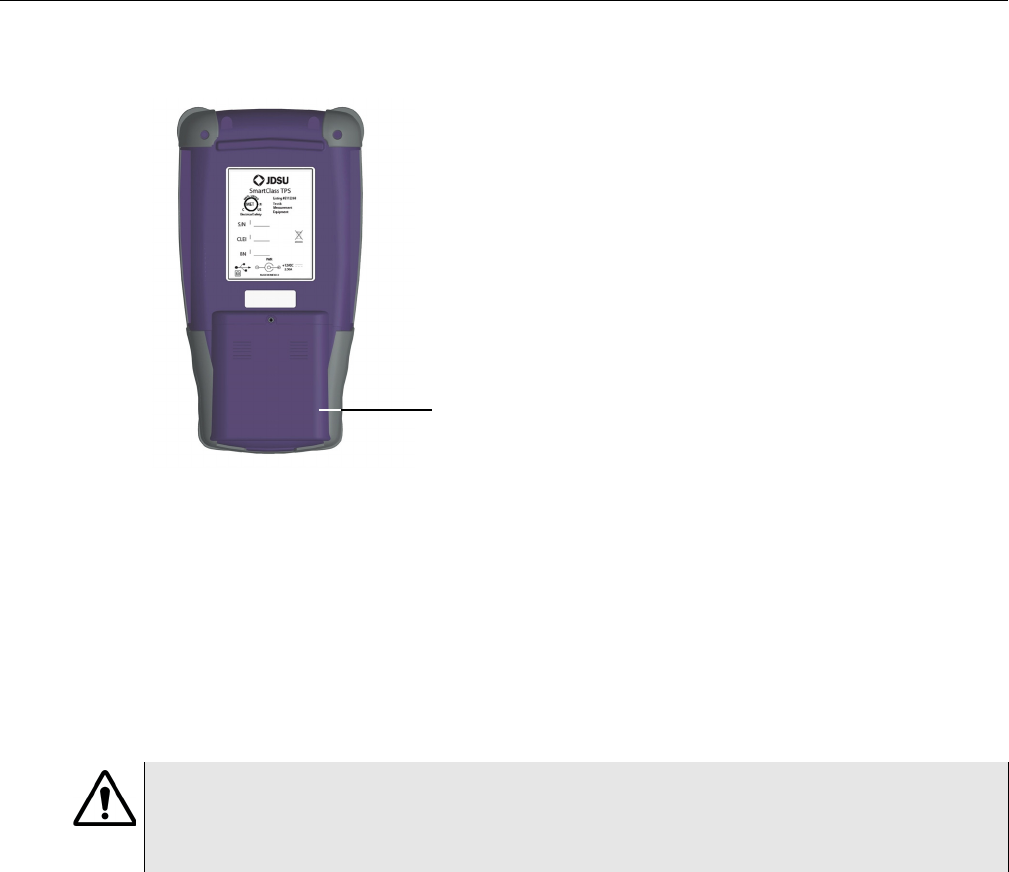
Chapter 18 Maintenance and Troubleshooting
Replacing the battery pack
SmartClass TPS User’s Guide
May 2014 22035456, Rev 001 147
3Let the SmartClass Triple Play Services charge for 5 hours for a fast charge; for maximum
capacity, allow the SmartClass to (trickle) charge overnight.
The charging time will be the same whether the power is on or off.
The Batt LED is amber when the unit is fast charging. The SmartClass Triple Play Services
will trickle charge at other times when the charger is connected and the Batt LED is green.
After the Batt LED turns green (fast charge is complete), allow the unit to trickle charge over-
night for maximum performance.
Charging the batteries is complete.
Replacing the battery pack
The battery compartment is located on the back of the unit, as shown in Figure 20.
The following procedure describes how to replace the battery pack.
Before replacing the battery pack, verify that the replacement battery pack is JDSU part number
21129596 (catalog number SCTP-BATTERY).
To replace the battery pack
1Turn the power off.
2Using a phillips screw driver, remove the screw from the battery compartment door.
3Remove the battery compartment door by pressing down and pushing toward the bottom end.
4Disconnect the old battery pack from the wiring.
5Connect the new battery pack to the wiring.
Figure 20 Back of the SmartClass Triple Play Services
Battery compartment
CAUTION: INSTRUMENT DAMAGE
Failure to turn the power off before removing the batteries from the SmartClass Triple Play Ser-
vices could damage internal components and/or corrupt the software. Always power down the
unit before removing the battery pack.
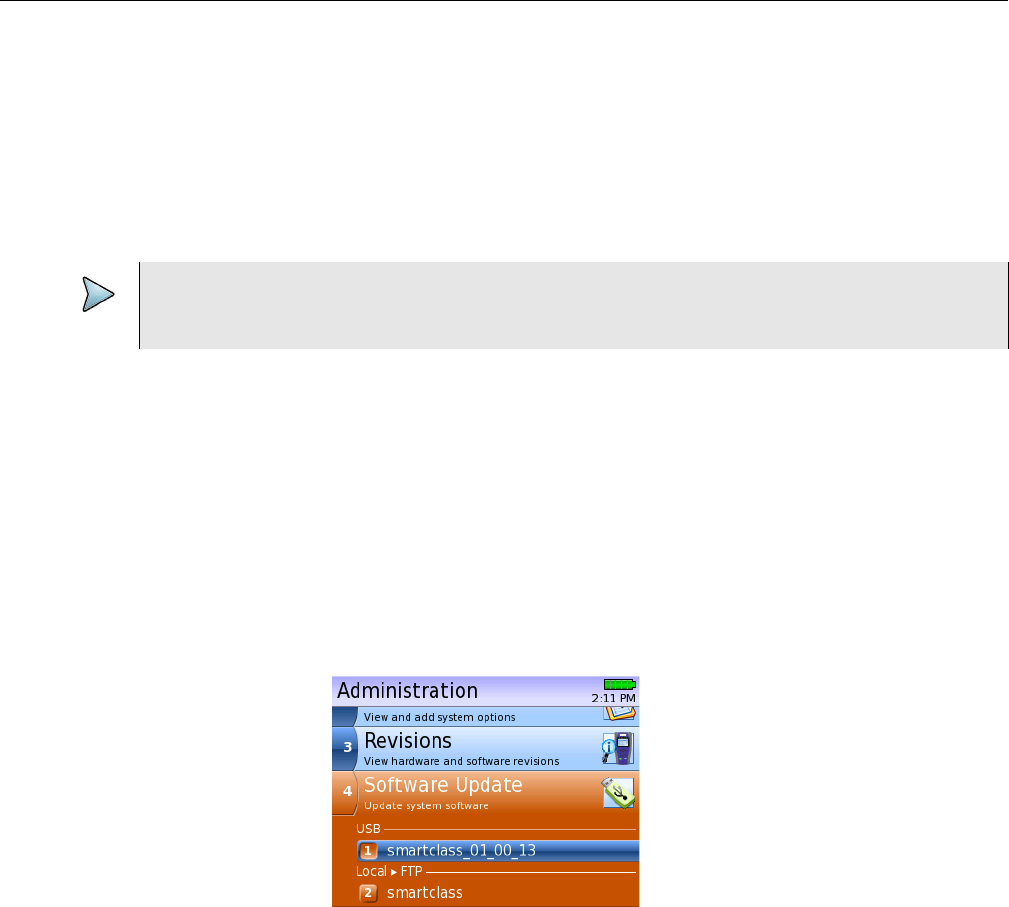
Chapter 18 Maintenance and Troubleshooting
Updating the software
SmartClass TPS User’s Guide
148 22035456, Rev 001 May 2014
6Replace the battery compartment door.
Replacing the battery pack is complete.
Updating the software
The SmartClass Triple Play Services’s software can be upgraded in the field using either FTP or
with the USB port on the right side of the instrument. You can obtain the software (filename
“smartclass_XXXX.tps” where XXXX is the version) by doing one of the following:
–Download it from our web site and then copy it to a USB stick (in the root directory).
– Use the FTP application to download it to the unit.
(This is the “File Transfer Test” in the data application. See “Throughput testing” on
page 64.)
– Call JDSU Customer Service to order an upgrade. You will receive a USB stick with the soft-
ware already on it.
To update software
1If using a USB stick for the update, connect it to the USB connector on the right side of the
unit.
The unit will auto-detect the USB drive.
2From the Main Menu, select System Settings, and then Administration, and then select
Software Update.
The Software Update screen appears.
This screen shows two software files, one on USB and the other is a FTP-downloaded file.
3Select which file to use.
4Press the OK key to verify, and begin the update.
The update status is displayed on the screen.
The update will take several minutes.
NOTE:
If you download or FTP the software, make sure that the filename has a .tps extension. Other
extensions will not work.

Chapter 18 Maintenance and Troubleshooting
Adding options
SmartClass TPS User’s Guide
May 2014 22035456, Rev 001 149
5After the update finishes, turn the unit off then back on.
The software is updated.
Adding options
The SmartClass Triple Play Services allows you to add new options to your unit in the field by
entering a unique number key that will un-lock the new feature. Contact your sales representative
or call JDSU customer service to order your new feature and obtain the unique key for your unit.
This will be a 12 byte (24-digit) number. To generate this key, the JDSU customer service represen-
tative will need the following information:
– The serial number of your unit (found on the label on the back of the unit)
– The unique hardware ID number (see “Viewing unit revisions, options, and IDs” on page 30)
The following procedure describes how to add options. You can also add options through Strata-
Sync by synchronizing your unit with the StrataSync server. Refer to “StrataSync” on page 141.
To add options
1Contact your JDSU representative to obtain the number key that will enable the option you
want to add.
2From the Main Menu, select System Settings, and then Administration.
3Select Options.
A list of current options appears and indicates whether the option is installed on your unit. The
unit’s unique Hardware ID number also appears on this screen.
4Select Add Options.
A prompt appears to enter the code for the option.
5Enter the code obtained in step 1, then press the OK key.
6Restart the unit.
When the menu is viewed again, a check mark appears next to the option indicating it is available
for use.
Getting Technical Assistance
If you need assistance or have questions related to the use of this product, use the information in
Table 52 on page 150 to contact JDSU’s Technical Assistance Center (TAC) for customer support.
For the latest TAC contact information, go to www.jdsu.com or contact your local sales office for
assistance.
NOTE:
During the update the unit will turn off then back on. This allows the software to validate that the
current software update was successful before removing the previous software. If an error occurs
during the update, the unit will revert to the previous software version.

Chapter 18 Maintenance and Troubleshooting
Additional information
SmartClass TPS User’s Guide
150 22035456, Rev 001 May 2014
The regional sales office phone numbers are listed on the back of this manual.
During off-hours, you can request assistance by doing one of the following: leave a voice message
at the TAC for your region; email the North American TAC (tac@jdsu.com); submit your question
using our online Technical Assistance request form at www.jdsu.com.
Additional information
For additional information, visit the SmartClass TPS web page:
http://www.jdsu.com/products/communications-test-measurement/products/a-z-product-list/smart-
class-tps.html
Resolving problems
If you are having trouble with the SmartClass Triple Play Services, the following sections describe
common problems and solutions. You should verify whether your problem is listed here before
contacting technical assistance.
Operating the unit
The following section addresses questions that may be asked about operating and performing basic
functions with the SmartClass Triple Play Services.
Issue
The handset (internal) microphone does not work.
Resolution
The microphone is only used for POTS and VoIP calls.
Table 52 Technical assistance centers
Region Phone Number
Americas 1-855-ASK-JDSU
+1 301 353 1560
tac@jdsu.com
Europe, Africa, and Mid-East +49 (0) 7121 86 1345
(JDSU Germany)
hotline.europe@jdsu.com
Asia and the Pacific +852 2892 0990
(Hong Kong)
+8610 6833 7477
(Beijing-China)
Chapter 18 Maintenance and Troubleshooting
Resolving problems
SmartClass TPS User’s Guide
May 2014 22035456, Rev 001 151
Performing tests
The following section addresses questions that may be asked about completing tests with the
SmartClass Triple Play Services. The following sections are included:
– General
– Ethernet tests
– DSL tests
– VoIP tests
– Video tests
– Copper tests
General test problems
The following section addresses questions about testing in general.
Issue
Inconsistent test results.
Resolution
Verify that your test leads are good and are connected properly for the test you are performing.
DSL test problems
The following section addresses questions about DSL testing.
Issue
The modem cannot achieve sync with the CO.
Resolution
Inability to sync can have many causes. Perform the following steps to troubleshoot:
– Disconnect the customer's DSL modem.
– Verify tester connection to the correct pair.
– Verify the Data mode.
– Verify that the Standard is correct (ADSL2+, G.DMT, Auto, etc.).
– Isolate premise wiring.
– Check for premise alarm system.
– Verify the copper pair is provisioned for ADSL or VDSL at the CO.
– Test at the CO/Exchange on the customer pair.
– Check the DSLAM modem vendor and software version.
Issue
The modem gets sync with the CO, but the rate is lower than expected.
Resolution
Verify that you are on an ADSL2/2+ or VDSL line, as appropriate.
Chapter 18 Maintenance and Troubleshooting
Resolving problems
SmartClass TPS User’s Guide
152 22035456, Rev 001 May 2014
Check the bits/tone and the SNR/tone for areas of the spectrum with low throughput. This could be
caused by bridged taps, cable crosstalk, or AM radio.
Check the DSLAM configuration - the max rate may be limited there.
Check for premise alarm system on the same pair.
Avoid excessive loop length or high attenuation.
Make sure that you are connected on pins 3 and 4.
Verify the noise margin.
Data test problems
The following section addresses questions about Data testing.
Issue
The IP ping menu says pings are being sent, but the network statistics are not incrementing.
Resolution
Verify that the network is up by checking the Frame LED. It should be solid green.
Verify the IP address and netmask.
You may be behind a firewall. Use trace route to determine whether this is the case.
The IP ping function only attempts to send a ping every second. Depending on certain conditions,
a physical ping packet may not be sent.
If IPoE or PPPoE data mode is being used, the device has to ARP the address first. If this fails even-
tually you will see a ARP HOST UNREACHABLE message. Check to see that the destination IP
address and your configured IP parameters are correct.
If the Ethernet interface is being used, make sure that the cabling is correct. If the Ethernet cable is
not hooked up, or is hooked up incorrectly, a packet will not be sent. Thus the Ethernet statistics will
not increment.
Issue
The Sync LED is green, but the Frame LED status is not.
Resolution
Verify that the Data Mode is not set to None.
Issue
In through mode, I’m connected to the Ethernet connector, but I’m not getting a data connection
(green Frame LED).
Resolution
Go to the Ethernet Settings screen and check the Media Type. If it’s set to Auto, change it to match
the specific LAN speed and duplex type that you are using.
Chapter 18 Maintenance and Troubleshooting
Resolving problems
SmartClass TPS User’s Guide
May 2014 22035456, Rev 001 153
Issue
I’m on an ADSL circuit and the ATM results indicate that I am receiving frames but the Frame LED
is not green and IP pings are not working.
Resolution
Check the encapsulation and the mode. The wrong protocol may be in use.
Issue
I’m on an ADSL circuit and I have a PPPoA service and I get a PPP TIMEOUT message
Resolution
Verify that the VPI-VCI is correct.
Verify that the encapsulation is correct.
Verify that the addressing mode is set correctly (IPCP/Static).
Verify that the username and password are correct.
Issue
I have a PPPoE connection and I get a PPPoE FAILED message.
Resolution
Verify that the VPI-VCI is correct.
Verify that the encapsulation is correct.
Verify that the addressing mode is correct.
Verify that the user name and password are correct (including case).
Check for a VLAN.
Issue
I’m on an ADSL circuit and I have a Bridged Ethernet connection and I get a DCHP FAILED
message.
Resolution
Verify that the VPI-VCI is correct.
Verify that the encapsulation is correct.
Verify that the DHCP server isn't out of addresses. (Contact your IT department or help desk.)
Issue
I get an INVALID CONFIG message.
Resolution
Verify that a valid IP address is being used (examples of invalid IP addresses would be *.*.*.0 or
127.*.*.* or 10.0.0.1 or 192.168.0.0).
Chapter 18 Maintenance and Troubleshooting
Resolving problems
SmartClass TPS User’s Guide
154 22035456, Rev 001 May 2014
Verify that the IP address and gateway are on the same network as defined by the netmask.
Check the netmasks if Ethernet IP = DSL IP. The netmasks must be different.
Verify that the Netmask is not set to 0.0.0.0.
Issue
The Frame LED is green, but IP pings are not working.
Resolution
A green Data status indicator does not guarantee an IP ping (or any routed/bridged packet) will be
treated properly once it leaves the unit. In an Ethernet bridged or IP over ATM environment with
static addressing, there is no initial communication with the far end, so as soon as ATM sync occurs
the interface is deemed active to pass user data.
Make sure that the VPI and VCI is correct.
Make sure that the encapsulation is correct.
Try pinging a different host.
Make sure the DNS server is active with another PC.
Set the ping packet size smaller.
Make sure the Data mode is set correctly for the type of circuit under test (such as PPPoE versus
IPoE).
Make sure you are not behind a firewall; they can block ping responses from reaching the host.
Check to see if the connection is unnumbered. If it is, verify that the connection is configured
correctly.
View the IP Ping results menu. It can often give important clues as to why the ping is not successful.
VoIP test problems
The following section addresses questions about VoIP testing.
Issue
The VoIP call didn’t go through.
Resolution
Check your connections to verify that they are hooked up properly.
Check the status LEDs. The Sync and Frame LEDs should be green.
Verify the LAN settings (IP address, netmask, DNS name).
Verify the call control. Most equipment uses Fast Connect.
If you do not have a gatekeeper, verify the outgoing alias and IP address.
If you are using a gatekeeper, verify you are registered with the gatekeeper.
Chapter 18 Maintenance and Troubleshooting
Resolving problems
SmartClass TPS User’s Guide
May 2014 22035456, Rev 001 155
If you are on an IPoE line and STUN is enabled, the data layer will not come up until the STUN client
on the SmartClass has determined the type of NAT used between the SmartClass and the STUN
server. Wait a few minutes and try to resync.
Check with your system administrator to verify that the firewall allows VoIP traffic.
Issue
I am emulating a SIP phone but cannot register with the SIP server.
Resolution
In typical networks, the same server handles both registration and placing and receiving calls.
However, in some networks, there is a Proxy server that handles SIP messaging for placing and
receiving calls, and a registrar that handles registration, which may be in a different domain.
If this is the case, do the following.
– Verify that you specified the “Proxy” on the Proxy Settings menu as the outbound proxy, or the
device from which the SmartClass will send and receive all SIP messages (for placing and
receiving calls).
– Verify that you specified the “Alias” on the General Settings menu as the SIP server or registrar
(the device that keeps track of all the registered devices), using the following format “phone-
Number@domain” where domain is either an IP address of the registrar or a literal domain
such as “jdsu.com”.
Issue
The VoIP delay measurement does not appear.
Resolution
The Delay result is only calculated if the RTCP signaling is active.
Issue
I have very little loss, but a high level of delay.
Resolution
Check your network. It may be experiencing high traffic.
Issue
I have a large amount of jitter, but no loss or delay.
Resolution
Check the setup of your router.
Chapter 18 Maintenance and Troubleshooting
Resolving problems
SmartClass TPS User’s Guide
156 22035456, Rev 001 May 2014
Video test problems
Individual program flows should be analyzed to ensure that both content quality and network perfor-
mance parameters are within desired network specifications. The suggested thresholds are listed
below:
Packet loss = less than or equal to 0.1%
Packet jitter = less than or equal to 5 msec*
PCR jitter = less than or equal to 5 msec*
Error indicator = zero count
IGMP latency = less than or equal to 200 msec
*Specific STB/decoder designs may be able to tolerate higher levels of jitter based on larger
buffer designs. Less than or equal to 10 msec may be acceptable.
Five to ten msec is a conservative PCR jitter level. As network designs and STBs increase
buffer sizes, the acceptable level will rise. The acceptable level for a particular network is a
company-specific issue.
When these measurements are made simultaneously on more than one channel, then content
problems can be easily separated from distribution network problems, a critical determination for
problem resolution.
Issue
I have continuity errors.
Resolution
Packet loss (continuity error) problems are typically seen on all channels/programs coming to the
premise because they are not source or content related. If packet loss is present, analysis of the
physical layer at the xDSL interface or Ethernet interface will aid in sectionalization. If no physical
layer errors are present, then packet loss is most likely being caused by the distribution network not
from the access network. Congestion is most likely at issue.
Looking further into the temporal component can help pinpoint the issue. The answers to the
following questions can help find the problem area(s). Are packets being lost during known peak
traffic times during the day? Are they coming in bursts with intervals with no loss? Are they random
single or small packet loss events?
Bursts of loss might be more symptomatic of buffer overflows related to heavy traffic. Random
single or small events might be more related to noise hits on the access network impacting packet
flows. DSL loop performance in the access network may be pushing the bandwidth limits when
signal to noise margins are low and the addition of a second or third channel flow reaches 100%
capacity of the loop. The copper may be poorly balanced allowing high impulse noise to impact the
data flows. In-home wiring may be introducing noise which also can damage data flows.
Issue
I have a PCR jitter result that is higher than expected.
Resolution
PCR jitter problems may be due to content quality problems as outlined previously or overall
network packet jitter. By evaluating more than one channel/program at a time, this can be deter-
mined. If excessive PCR jitter is present at more than one channel, network jitter is most likely at
fault. If excessive PCR jitter is present on only one channel, then a source problem as described
above is normally the cause.
Chapter 18 Maintenance and Troubleshooting
Resolving problems
SmartClass TPS User’s Guide
May 2014 22035456, Rev 001 157
Issue
I am receiving error indicators.
Resolution
Error Indicator counts indicate content problems, since the indicator can only be set by the encoder.
Typically this would affect only one program or channel. However, if a multiple program feed in the
head end is experiencing problems, more than one program/channel could be affected. Analyzing
a channel from another source, or different feed would be instructive. The video may show poor
quality with only the Error Indicator count showing a problem. Any count is bad.
Issue
I have significantly more IGMP latency on one channel than the others.
Resolution
IGMP latency measures the network's performance. Typically, IGMP latency would be similar for
multiple channels. However, if network topology and management place access to certain program
material farther back in the network, then differences could be experienced. If such a hierarchical
approach is used, then differences might be detected based upon which programs are accessible
deeper in the network. Testing multiple channels/programs to exercise this network design would
be useful.
Copper test problems
The following section addresses questions about Copper testing.
Issue
The Tip (A) - Ring (B) voltage is reading negative.
Resolution
The Tip (A) and Ring (B) test leads may be swapped. Check your test leads to verify that they are
hooked up properly.
Issue
The AC voltage test result from Tip (A) to Ground (E) is 5 volts and from Ring (B) to Ground (E) is
15 volts.
Resolution
Either Tip (A) is open or Ring (B) is longer. This will also be indicated by noise on the loop. Results
on Tip (A) to Ring (B) should be 0.0 volts. Tip (A) to Ground (E) and Ring (B) to Ground (E) should
be equal to each other. Anything else indicates AC signal interference and/or an unbalanced line.
Ringer voltage level can be checked by having the CO ring back on the line. Results should be
either 85 volts (older switches) or 105 volts (newer switches).
Issue
The DC volt measurement on Tip (A) to Ground (E) is 15 volts with the battery removed.
Resolution
This indicates there may be an open in the insulation drawing current from another pair.
Chapter 18 Maintenance and Troubleshooting
Resolving problems
SmartClass TPS User’s Guide
158 22035456, Rev 001 May 2014
To measure DC volts, remove the line battery and measure Tip (A) and Ring (B) to Ground (E). It
should be < 3.0 volts; anything else indicates crossed battery that inhibits digital signals.
To check for span/battery voltage, measure Tip (A) to Ring (B) across several pairs. On good lines
Tip (A) to Ring (B) will be 48–52 volts, Tip (A) to Ground (E) will be < 5 volts, and Ring (B) to Ground
(E) will be -48–52 volts.
Issue
In the winter, the DC current measured 21 mA from an aerial cable at the NID with are no problems.
In the summer, the same line measured 17 mA.
Resolution
The heat has increased resistance and lowered the current.
DC current on Tip (A) to Ring (B) should be 23 mA at the NID. Anything less will not allow for differ-
ences in temperature and phone equipment will not operate during extremes.
The 23 mA threshold covers most temperature extremes.
Issue
The resistance measurement on Tip (A) to Ring (B) is 3.5 M, Ring (B) to Ground (E) is 3.5 M,
and Tip (A) to Ground (E) is 5 k.
Resolution
There is a ground fault on Tip (A). The typical resistance is > 3.5 M. Lower values indicate a short
or ground fault
Loop resistance is measured with the pair short circuited (shorted) at one end, so a much lower
resistance value is measured, as the current can readily flow down one lead and easily back up the
other across the short. This “loop resistance” measurement is often required to qualify HICAP (high-
capacity) circuits such as ADSL with values approximating 700 .
Resistance is measured not only across Tip (A) to Ring (B), but also from Tip (A) to Ground (E) or
Ring (B) to Ground (E). Resistance is also measured from one lead to Ground (E) to check for
shorts to the shield and other ground references, indicating a fault on one lead of the wire pair.
Resistance measurements made to Ground (E) are used to compare the resistance value of one
lead to the other, to see how much difference exists in the resistance of one lead compared to the
other. It is important for both leads to be nearly the same (resistive balance), and a difference of
more than 3 percent is usually considered unacceptable.
Issue
While running the Opens test, the mutual value looks good, but the Tip (A) and Ring (B) values are
really short.
Resolution
Verify the ground. The module must be grounded to the same ground as the pair under test. (Use
the Current test to verify the ground. See step 10 on page 116.)
Issue
Two loops in the same bundle display different loop lengths.
Chapter 18 Maintenance and Troubleshooting
Resolving problems
SmartClass TPS User’s Guide
May 2014 22035456, Rev 001 159
Resolution
Use a known good loop to determine capacitance, then run the opens again to determine the length
of the bridge tap or location of the fault. Verify with a tester that has TDR capability.
Measure multiple vacant pairs by attaching one lead to Ground (E) and using the other to the Tip
(A) of each vacant conductor. (Battery should be removed) Compare the distance for each for
consistency.
Opens/Capacitance: < 3% difference between Tip (A) and Ring (B) values indicate an acceptably
balanced loop. Anything greater indicates an unbalanced line or open fault, which inhibit digital
signals.
You can also compare the distance from the Opens measurement to a resistive distance measure-
ment, and determine the presence of a bridged tap by the difference in the distances.
Issue
The balance measurement is 50 dB.
Resolution
The pair quality is too low as it should mitigate 60 dB. The balance result should be >60 dB.
Anything less indicates electrical differences between Tip (A) and Ring (B) that can lead to noise
and other signal problems.
This would indicate some imbalance in the quality of each lead and reduced noise immunity.The
more each lead is electrically identical (capacitance, inductance, impedance), the better the pair will
resist induced noise. If they do not cancel induced noise equally, the difference is realized as
unwanted current, or metallic or mutual noise. If the imbalance of the leads is too great, the
customer would hear noise.
Issue
The POTS service test is fine but the DSL signal cannot be detected at the NID. The test set indi-
cates 2 load coils on a 15 kft loop.
Resolution
Load coils block high frequency signals such as DSL and they must be removed for digital circuits.
In a normal loading scheme, the first one will be 3 kft from the CO and the second will be 9 kft from
the CO. Use a tester that has TDR capability to verify the location of the loads. Loads are used to
improve POTS over long loops. On most loops 18 kft or longer, load coils are required to ensure
voice quality. Load coils must be evenly spaced starting at 3 kft from the CO and placed at 6 kft
intervals thereafter, with at least 2,000 feet between the last load coil and the customer premises.
Chapter 18 Maintenance and Troubleshooting
Resolving problems
SmartClass TPS User’s Guide
160 22035456, Rev 001 May 2014

A
SmartClass TPS User’s Guide
May 2014 22035456, Rev 001 161
Appendix A Specifications
This appendix contains specifications for the SmartClass Triple Play Services. Topics discussed in
this appendix include the following:
–“Physical specifications” on page 162
–“Connector specifications” on page 162
–“Environmental specifications” on page 162
–“Power specifications” on page 163
–“Calibration” on page 163
–“Warranty information” on page 163

Appendix A Specifications
Physical specifications
SmartClass TPS User’s Guide
162 22035456, Rev 001 May 2014
Physical specifications
Table 53 provides the physical specifications.
Connector specifications
Table 54 provides the connector specifications.
Environmental specifications
Table 55 provides the environmental specifications.
Safety specification
Ingress protection is the degree of protection provided against the intrusion of solid objects
(including body parts like hands and fingers), dust, accidental contact, and water in mechanical
casings and with electrical enclosures.
The degree of ingress protection for the SmartClassTPS is IP20.
Table 53 Physical specifications
Parameter Specification
Size (H x W x D) 9.05 x 4.72 x 2.75 in (230 x 120 x 70 mm)
Weight, including battery 2.5 lb (1.1 kg)
Table 54 Connector specifications
Connector Specification
POTS 8-pin modular (RJ-45)
DSL 8-pin modular (RJ-45)
Ethernet 8-pin modular (RJ-45)
USB USB 2.0
Power 2.1x5.5mm Center Positive Standard
Table 55 Environmental specifications
Parameter Specification
Operating Temperature -0 to +40 C (32 to +104F)
Storage Temperature -30 to 60 C (-22 to 140 F)
Humidity 10% to 90% RHNC

Appendix A Specifications
Power specifications
SmartClass TPS User’s Guide
May 2014 22035456, Rev 001 163
Power specifications
Although battery life varies depending on the type of test, Table 56 provides specifications for the
battery life and the specifications for the AC adapter.
Calibration
The following section briefly discusses calibrating the SmartClass Triple Play Services unit.
Self calibration
The SmartClass Triple Play Services can be self calibrated. It includes built-in self calibration
routines that allow the instrument’s Copper measurement circuits to maintain specification for more
than 5 years. For more information on how to perform a self-calibration, see “Calibrating the unit”
on page 117.
Factory calibration
JDSU recommends that you return your SmartClass Triple Play Services to the factory every 3
years for complete inspection and calibration. For additional information about options, services,
and factory calibration, contact your local JDSU representative or contact JDSU through the
company web site, www.jdsu.com.
Warranty information
The warranties described herein shall apply to all commercially available JDSU Communications
Test and Measurement products. Any additional or different warranties shall apply only if agreed to
by JDSU in writing. These warranties are not transferable without the express written consent of
JDSU.
Hardware Warranty — JDSU warrants that Hardware Product sold to customer shall, under
normal use and service, be free from defects in materials and workmanship. Information
regarding the specific warranty period for this product can be obtained by contacting your local
JDSU Customer Service Representative, or at our web site www.jdsu.com. The warranty
period shall begin upon shipment to Customer. Hereafter these periods of time shall be collec-
tively referred to as the “Initial Warranty Period.”
Table 56 Power specifications
Parameter Specification
Operating time Greater than 4 hours (depending on type of test)
Charging time 5 hours for a fast charge; for a full charge, allow to trickle
charge overnight
Unit power input 12 V, 2.5 Amp
Power supply input 100 to 240 VAC, 50/60 Hz, autosensing
Power supply output 12 V, 2.5 Amp
Appendix A Specifications
Warranty information
SmartClass TPS User’s Guide
164 22035456, Rev 001 May 2014
JDSU’s obligation and customer’s sole remedy under this Hardware Warranty is limited to the
repair or replacement, at JDSU’s option, of the defective product. JDSU shall have no obliga-
tion to remedy any such defect if it can be shown: (a) that the Product was altered, repaired, or
reworked by any party other than JDSU without JDSU’s written consent; (b) that such defects
were the result of customer’s improper storage, mishandling, abuse, or misuse of Product; (c)
that such defects were the result of customer’s use of Product in conjunction with equipment
electronically or mechanically incompatible or of an inferior quality; or (d) that the defect was
the result of damage by fire, explosion, power failure, or any act of nature.
JDSU performed repairs shall be warranted from defective material and workmanship for a
period of ninety (90) days, or until the end of the Initial Warranty Period, whichever is longer.
Risk of loss or damage to Product returned to JDSU for repair or replacement shall be borne by
customer until delivery to JDSU. Upon delivery of such product, JDSU shall assume the risk of
loss or damage until that time that the product being repaired or replaced is returned and deliv-
ered to customer. Customer shall pay all transportation costs for equipment or software
shipped to JDSU for repair or replacement. JDSU shall pay all transportation costs associated
with returning repaired or replaced product to customer.
Software Warranty — JDSU warrants that Software Products licensed to Customer shall,
under normal use and service, and for a period of ninety (90) days from the date of shipment of
the Software to Licensee (the “Warranty Period”), perform in all material respects in accor-
dance with the published specifications for such Software as established by JDSU. However,
JDSU does not warrant that the Software will operate uninterrupted or error free, operate in the
combination with other software, meet Customer’s requirements, or that its use will be uninter-
rupted.
JDSU’s obligation and Customer’s sole and exclusive remedy under this Software Warranty is
limited to, at JDSU’s option, either (i) correcting the material errors reported to JDSU in writing
by Customer during the Warranty Period and which JDSU is able to reproduce, (ii) replacing
such defective Software, provided that JDSU received written notice of such defect within the
Warranty Period, or (iii) provided that JDSU received written notice of such defect within the
Warranty Period, terminating the License and, upon return to JDSU of the Software, Documen-
tation and all other materials provided by JDSU under the applicable License, providing
Customer with a refund of all charges paid with respect thereto. JDSU shall have no warranty
obligations hereunder if (a) the Software is altered or modified or is merged with other software
by Customer or any third party or (b) all or any part of the Software is installed on any computer
equipment other than the Designated Server or used with any operating system for which the
Software is not designed.
Customer acknowledges that the Software Products provided by JDSU hereunder may contain
third party software not produced by JDSU (a “Third Party Supplier Product”), and may be
made available under the software license(s) specific to that Third Party Supplier Product. To
the extent a Third Party Supplier Product is made available under the GNU General Public
License, such license shall govern the use of such Third Party Supplier Product, and the
following notice shall apply:
“(1) This program is free software; you can distribute it and/or modify it under the terms of the
GNU General Public License as published by the Free Software Foundation; either version 2 of
the License, or (at your option) any later version. This program is distributed in the hope that it
will be useful, but WITHOUT ANY WARRANTY; without even the IMPLIED WARRANTY OF
MERCHANTABILITY or FITNESS FOR A PARTICULAR PURPOSE. See the GNU General
Public License for more details. If you would like to receive further details concerning the use of
such General Public License Software or would like to receive a copy of the GNU General
Public License, please make a written request to
JDSU, One Milestone Center Ct., Germantown, Maryland 20876-4023 or write to the Free Soft-
ware Foundation, Inc., 59 Temple Place - Suite 330, Boston, MA 02111-1307, USA.”
WARRANTY DISCLAIMER — FOR HARDWARE, AND/OR SOFTWARE FURNISHED BY JDSU,
THE FOREGOING WARRANTIES ARE IN LIEU OF ALL OTHER WARRANTEES AND CONDI-
TIONS, EXPRESS OR IMPLIED. JDSU SPECIFICALLY DISCLAIMS ALL OTHER WARRANTIES,
EITHER EXPRESS OR IMPLIED, ON ANY HARDWARE, SOFTWARE, DOCUMENTATION OR
Appendix A Specifications
Warranty information
SmartClass TPS User’s Guide
May 2014 22035456, Rev 001 165
SERVICES INCLUDING BUT NOT LIMITED TO WARRANTIES RELATING TO QUALITY,
PERFORMANCE, NONINFRINGEMENT, MERCHANTABILITY OR FITNESS FOR A PARTIC-
ULAR PURPOSE, AS WELL AS THOSE ARISING FROM ANY COURSE OF DEALING, USAGE
OR TRADE PRACTICE. UNDER NO CIRCUMSTANCES WILL JDSU BE LIABLE FOR ANY INDI-
RECT OR CONSEQUENTIAL DAMAGES RELATED TO BREACH OF THIS WARRANTY.
Appendix A Specifications
Warranty information
SmartClass TPS User’s Guide
166 22035456, Rev 001 May 2014

Communications Test and Measurement Regional Sales
North America
Toll Free: 1 855 ASK JDSU
Latin America
Tel: +55 11 5503 3800
Asia Pacific
Tel: +852 2892 0990
EMEA
Tel: +49 7121 86 2222
www.jdsu.com
22035456
Rev 001, 5/2014
English
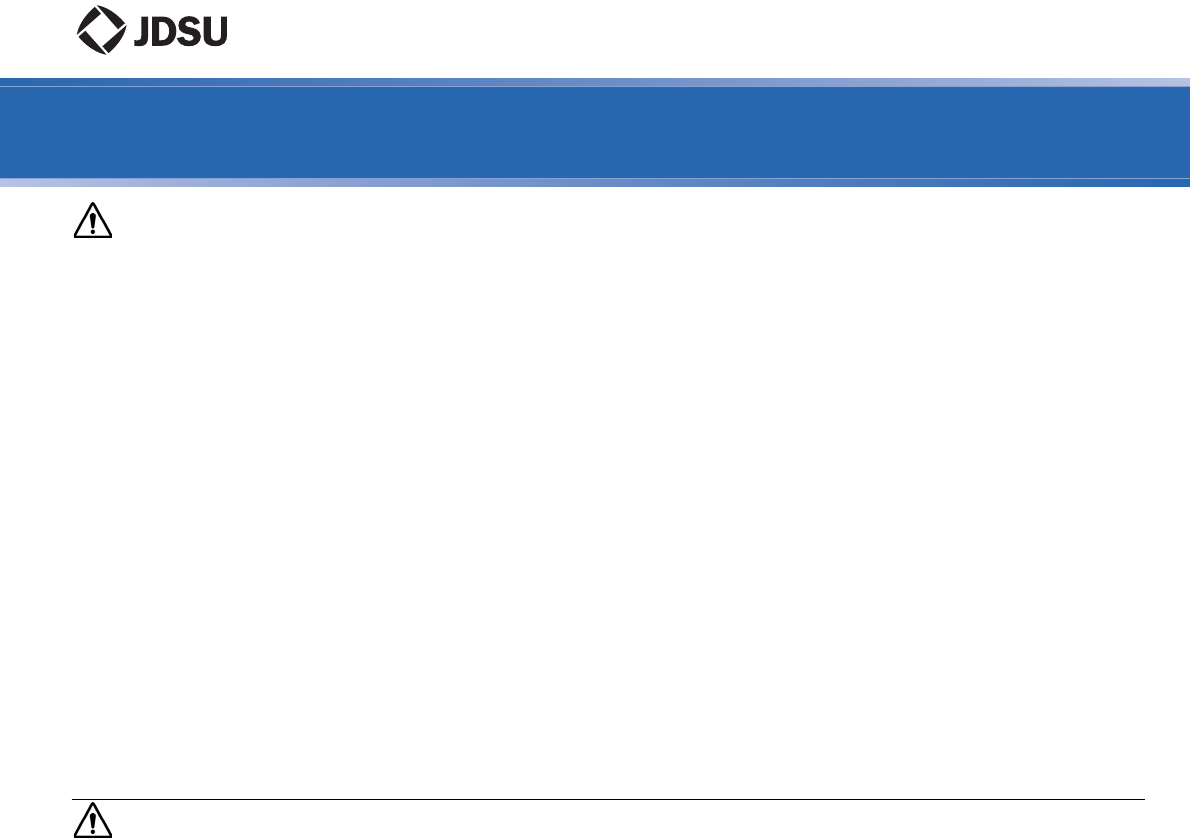
21134538, Rev. 003 SmartClass Triple Play Tester Safety Information 1
SmartClass Triple Play Tester Safety Information
Important safety instructions
When using the product, basic safety precautions should always be followed to reduce the risk of fire, shock, and injury to persons, including the following:
1Use only the AC Adapter/Charger supplied with the product. Do not use AC Adapter/Charger outdoors or in wet or damp locations. Connect the AC
Adapter/Charger to the correct mains voltage as indicated on the ratings label.
2Do not touch or otherwise come in contact with telephone conductors that could be exposed to lightning or accidental connection to power circuits
without first isolating them from the telephone network.
3Use appropriate cables when connecting to telecommunications circuits. Putting an RJ-11 connector in a RJ-45 port can damage the RJ45 port.
4 WARNING: Danger of extreme heat, fire, or explosion if battery is tampered with. Replace only with JDSU battery 21129596 (catalog number SCTP-
BATTERY). Dispose of used batteries according to the manufacturer's instructions.
5Do not attempt to service this product yourself, as opening or removing covers may expose you to dangerous high voltage points and other hazards.
Refer all servicing to qualified service personnel.
6CAUTION: If the equipment is used in a manner not specified by JDSU, the protection provided by the equipment may be impaired.
7Do not use on power circuits or on telecommunications network voltages over 300 VDC or 300 VAC Peak.
8The SmartClass TPS is protected by 500mA fuses. Do not touch the exposed contact of the test clamps.
9Charge the lithium ion battery using only the JDSU battery charger. The battery is to be used only with JDSU test products.
10 Be sure that TNV signals are not connected to SELV ports. If you need to access a line that may have TNV or higher voltages present using a SELV
port, you must do so through an interface device that is certified to provide a SELV connection point (see Table 1 on page 3).
11 CAUTION: To reduce the risk of fire, use only 26 AWG or larger telecommunications line cord.
12 Please see “Safety symbols” for safety symbols. Where the unit is labeled with a warning symbol, the operating manual must be consulted to learn
more about the nature of the potential hazard and any action that must be taken.
13 The copper testing interface is classified as Measurement Category I. It is not intended to be connected to circuits from Measurement categories II,
III, or IV. The maximum voltage, including transients is 300 Volts.
Save these instructions
Consignes de sécurité importantes
Lorsque vous utilisez ce produit, plusieurs consignes de sécurité primaires doivent toujours être appliquées afin de réduire le risque d’incendie, de
décharge électrique et de blessure corporelle :
1Utilisez uniquement l’adaptateur/chargeur CA livré avec le produit. N’utilisez pas cet accessoire à l’extérieur ou dans des locaux humides.
Raccordez-le à la tension de ligne CA correcte, conformément aux indications de l’étiquette signalétique.
2Ne touchez pas ou n’entrez pas en contact avec des conducteurs téléphoniques susceptibles d’être exposés à la foudre ou à un raccordement acci-
dentel à des circuits d’alimentation électrique, sans les avoir préalablement isolés du réseau téléphonique.
3Employez les câbles appropriés en se reliant aux circuits de télécommunications. La mise d'un connecteur RJ-11 dans un port RJ-45 peut endom-
mager le port RJ45.
4 ATTENTION : Si vous tentez d’ouvrir la batterie, une situation dangereuse peut apparaître (dégagement de chaleur extrême, incendie ou explosion).
Pour remplacer une batterie usagée, utilisez toujours une batterie JDSU du même type 21129596 (référence SCTP-BATTERY). Eliminez les
batteries usagées conformément aux instructions fournies par le fabricant.
5Ne tentez pas de réparer ce produit par vos propres moyens car l’ouverture ou le retrait de couvercles peut vous exposer à des points de haute
tension dangereux et à d’autres risques. Pour toute réparation, faites appel à un spécialiste qualifié.
6PRUDENCE : Si cet équipement est utilisé d’une manière non recommandée par JDSU, la protection intrinsèque pourra être mise en défaut.
7N'employez pas sur des circuits de puissance ou sur des tensions de réseau de télécommunications plus de crête de 300 volts continu ou de 300
VCA.
8Le TPS SmartClass est protégé par des fusibles de 500mA. Ne pas toucher le contact exposé les pinces de test.
9Dans le chargeur JDSU fourni, chargez uniquement une batterie de type lithium-ion. Cette batterie doit être exclusivement utilisée avec les produits
JDSU.
10 Vérifiez qu’aucun signal TNV n’est transmis aux ports TBTS. Si vous devez accéder à une ligne susceptible de véhiculer une tension TNV ou supéri-
eure en utilisant un port TBTS, vous devez intercaler un équipement d’interface certifié pour fournir un point de raccordement TBTS.
11 PRUDENCE : Pour réduire le risque du feu, employez seulement 26AWG ou plus grande ligne corde de télécommunications.
12 Veuillez voir les “Safety symbols” pour des symboles de sûreté. Là où l'unité est marquée avec un symbole d'avertissement, le operating manual doit
être consulté pour apprendre plus au sujet de la nature du risque et de n'importe quelle mesure qui doivent être pris.
13 L'interface d'essai de cuivre est classifiée comme catégorie I de mesure. On ne le prévoit pas pour être relié aux circuits des catégories de mesure
II, III, ou IV. La tension maximum, y compris des coupures est de 300 volts.
Mémorisez ces instructions

SmartClass Triple Play Tester Safety Information
Wichtige Sicherheitsinformationen
2 SmartClass Triple Play Tester Safety Information 21134538, Rev. 003
Wichtige Sicherheitsinformationen
Zur Verringerung von Brandgefahren, zur Vermeidung eines elektrischen Schlages und von Verletzungen sind alle grundlegenden Sicherheitsvorkeh-
rungen einzuhalten. Dazu zählen auch die folgenden Maßnahmen:
1Verwenden Sie ausschließlich das mit dem Produkt gelieferte Netzteil/Ladegerät. Verwenden Sie das Netzteil/Ladegerät nicht im Freien oder in
feuchten Räumen. Schließen Sie das Netzteil/Ladegerät nur an die auf dem Typenschild angegebene Netzspannung an.
2Berühren Sie weder direkt noch indirekt Telefonadern, die durch Blitzschlag gefährdet sind oder bei denen ein versehentlicher Anschluss an Hochs-
pannungsleitungen möglich ist, ohne diese zuvor vom Telefonnetz getrennt zu haben.
3Benutzen Sie passende Kabel beim Anschließen an Fernmeldeleitungen. Das Einstecken eines Steckers RJ-11 in einen RJ-45 Anschluss kann
diesen beschädigen.
4 WARNUNG: Bei Manipulationen an der Batterie (Akku) besteht die Gefahr einer starken Erhitzung, eines Brandes oder einer Explosion. Der
Austausch der Batterie sollte nur gegen eine JDSU-Batterie (Bestellnummer: SCTP-BATTERY) erfolgen. Entsorgen Sie gebrauchte Batterien
(Akkus) entsprechend den Anweisungen des Herstellers.
5Versuchen Sie nicht, dieses Produkt selbst zu warten. Beim Öffnen bzw. Abnehmen der Abdeckung besteht die Gefahr des Kontaktes mit gefährli-
chen Spannungsspitzen und anderer gesundheitlicher Risiken. Die Wartung des Produktes darf nur von entsprechend qualifizierten Fachkräften
ausgeführt werden.
6VORSICHT: Der Einsatz des Gerätes für andere als von JDSU angegebene Zwecke kann die vom Gerät gewährleisteten Schutzfunktionen beein-
trächtigen.
7Verwenden Sie nicht auf Energie Stromkreisen oder auf Fernmeldenetzspannungen über 300 VDC oder 300 VAC einer Spitze.
8SmartClass TPS wird von 500mA Sicherungen geschützt. Berühren Sie nicht den exponierten Kontakt Test-Klemmen.
9Laden Sie den Lithium-Ionen-Akku nur mit dem von JDSU gelieferten Ladegerät. Der Akku darf nur mit Testsprodukten von JDSU eingesetzt
werden.
10 Achten Sie darauf, dass TNV-Signale nicht an SELV-Anschlüsse angeschlossen werden. Wenn Sie auf eine Leitung, an der TNV-Spannung oder
höhere Spannungen anliegen können, über einen SELV-Anschluss zugreifen, dann müssen Sie hierfür ein Schnittstellengerät verwenden, das nach-
weislich einen SELV-Anschlusspunkt bereitstellt.
11 VORSICHT: Um die Gefahr des Feuers zu verringern, benutzen Sie nur 26AWG oder größeres Nachrichtentechnik Netzanschlußschnur.
12 Sehen Sie bitte “Safety symbols” für Sicherheit Symbole. Wo die Maßeinheit mit einem Warnsymbol beschriftet wird, muß das Benutzerhandbuch
beraten werden, um mehr über die Natur der möglichen Gefahr und aller möglicher Maßnahmen zu erlernen, die ergriffen werden müssen.
13 Die Kupfer Prüfenschnittstelle wird als Maß-Kategorie I eingestuft. Es soll nicht an Stromkreise von den Maßkategorien angeschlossen werden II,
III oder IV. Die maximale Spannung, einschließlich Ausgleichströme ist 300 Volt.
Bewahren Sie diese Hinweise auf
Importanti istruzioni di sicurezza
Quando utilizza il prodotto, l'utente dovrà sempre adottare precauzioni di base per ridurre il rischio di incendi, scosse elettriche e lesioni a terzi. Le precauz-
ioni comprendono quanto riportato di seguito.
1Utilizzare esclusivamente l'adattatore AC/caricabatterie fornito insieme al prodotto. Non utilizzare l'adattatore AC/caricabatterie in esterni oppure in
luoghi umidi o bagnati. Collegare l'adattatore AC/caricabatterie alla tensione di rete corretta secondo quanto riportato sull'apposita etichetta.
2Non toccare né entrare in altro modo in contatto con conduttori telefonici che possono essere stati colpiti da fulmini o collegati accidentalmente a
circuiti di potenza senza aver prima provveduto a isolarli dalla rete telefonica.
3Usi i cavi adatti quando collegano ai circuiti di telecomunicazioni. Mettendo un connettore RJ-11 in un orificio RJ-45 può danneggiare l'orificio RJ45.
4 AVVERTENZA: pericolo di estremo calore, incendio o esplosione in caso di manomissione della batteria. Sostituire esclusivamente con batterie
JDSU 21129596 (numero per ordinazioni: SCTP-BATTERY). Smaltire le batterie usate secondo le istruzioni della casa produttrice.
5Non cercare di riparare da soli il prodotto; l'apertura o la rimozione dei coperchi potrebbero esporre l'utente a tensione pericolosa e ad altri rischi.
Rivolgersi a personale qualificato per tutte le operazioni di manutenzione.
6ATTENZIONE: se l'impianto viene utilizzato in modo diverso da quello specificato da JDSU, ciò potrebbe compromettere la protezione fornita.
7Non usi sui circuiti di alimentazione o sulle tensioni della rete di telecomunicazioni oltre un picco VCA da 300 o da 300 VCC
8Il TPS SmartClass è protetta da fusibili 500mA. Non toccare il contatto esposto dei morsetti di prova.
9Per ricaricare la batteria agli ioni di litio, utilizzare esclusivamente il caricabatterie JDSU. La batteria va utilizzata esclusivamente con i prodotti JDSU.
10 Verificare che i segnali TNV non siano collegati a porte SELV. Nel caso in cui sia necessario accedere a una linea nella quale sono presenti tensioni
TNV o alte tensioni di altro tipo utilizzando una porta SELV, utilizzare un dispositivo di interfaccia omologato per la fornitura di un punto di collega-
mento SELV.
11 ATTENZIONE: Per ridurre il rischio di fuoco, usi soltanto 26AWG o la più grande linea cavo di telecomunicazioni.
12 Veda prego “Safety symbols” per i simboli di sicurezza. Dove l'unità è identificata con un simbolo d'avvertimento, il operating manual deve essere
consultato per imparare più circa la natura del rischio potenziale e di tutta l'azione che devono essere intrapresi.
13 L'interfaccia difficile di rame è classificata come categoria I di misura. Non è inteso per essere collegato ai circuiti dalle categorie di misura II, III,
o IV. Di Masurement. La tensione massima, compreso i passeggeri è di 300 volt.
Conservare queste istruzioni
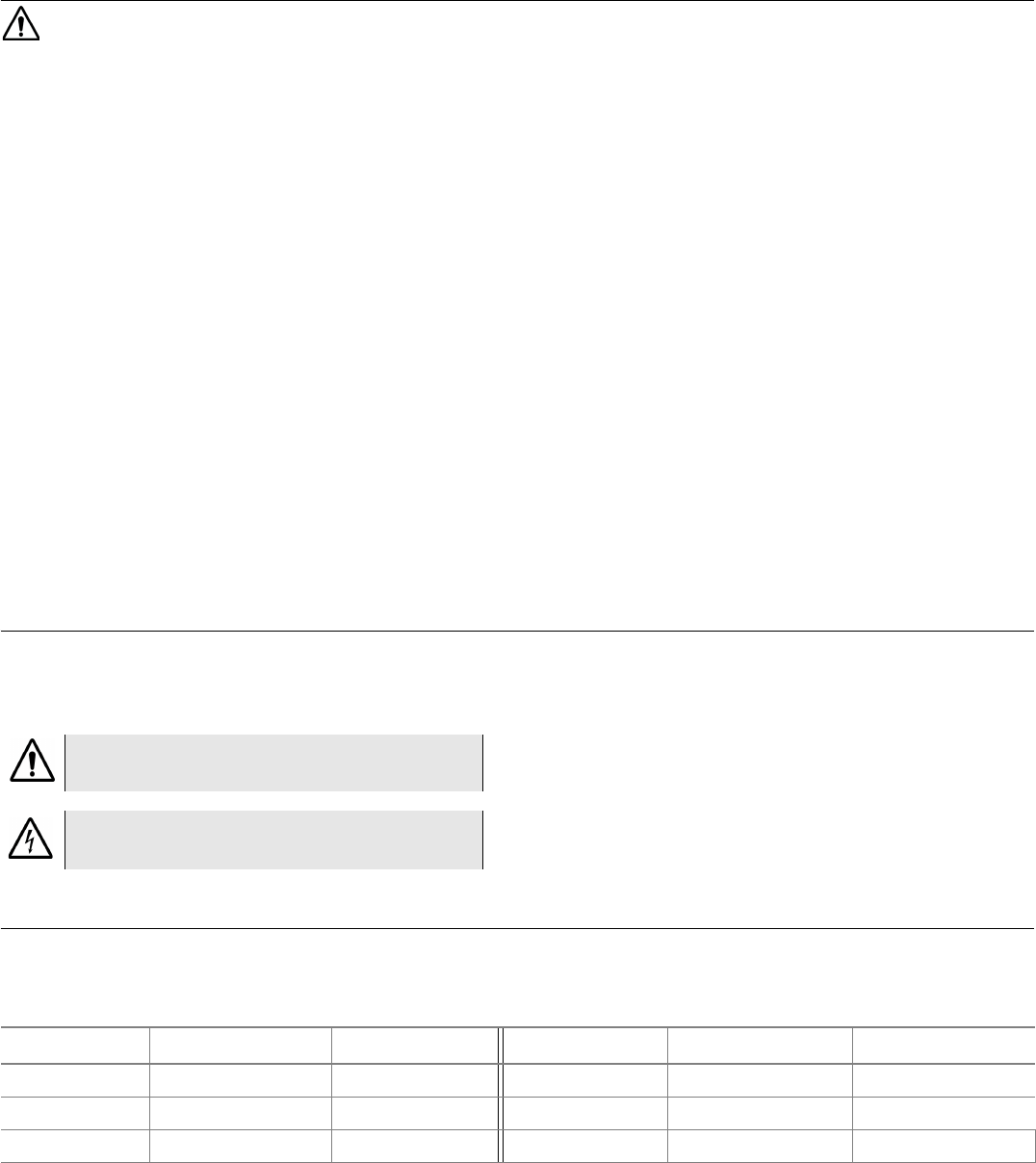
SmartClass Triple Play Tester Safety Information
Instrucciones de seguridad
21134538, Rev. 003 SmartClass Triple Play Tester Safety Information 3
Instrucciones de seguridad
Cuando use este producto, observe en todo momento ciertas precauciones básicas para reducir el peligro de incendios, golpes y lesiones personales,
incluyendo:
1No utilice un adaptador/cargador de alterna distinto al incluido con este producto. No lo emplee en exteriores ni en lugares mojados o muy húmedos.
Conecte el adaptador/cargador de alterna a la tensión de red correcta, indicada en la etiqueta del instrumento.
2No toque conductores telefónicos que pudieran estar expuestos a rayos o a conexiones accidentales con circuitos de alimentación, sin aislarlos
previamente de la red telefónica.
3Utilice los cables apropiados al conectar con los circuitos de telecomunicaciones. Poner un conectador RJ-11 en un puerto RJ-45 puede dañar el
puerto RJ45.
4ATENCIÓN: Existe riesgo de incendio o explosión si se sustituye la batería por una batería no adecuada. Utilice siempre baterías de JDSU
21129596 (número de referencia SCTP-BATTERY). Para desechar las baterías siga las instrucciones del fabricante.
5No trate de reparar este producto. Al abrir o quitar las cubiertas pueden quedar al descubierto elementos con tensiones elevadas. Consulte a un
técnico de asistencia cualificado.
6PRECAUCIÓN: Si este equipo se utiliza de forma distinta a lo especificado por JDSU, los mecanismos de protección previstos pueden dejar de
funcionar u operar inadecuadamente.
7No utilice en los circuitos de la energía o en voltajes de la red de telecomunicaciones sobre pico de 300 VDC o de 300 VAC.
8El TPS SmartClass está protegido por fusibles de 500mA. No toque el contacto expuesto de las pinzas de prueba.
9Para cargar la batería litio-ion, utilice siempre el cargador recomendado por JDSU. La batería debe usarse exclusivamente en equipos de JDSU.
10 Las señales TNV no deben conectarse a los puertos SELV. Si necesita acceder con un puerto SELV a una línea que pueda tener tensiones TNV o
superiores, use un dispositivo de interfaz capaz de proporcionar un puerto SELV.
11 PRECAUCIÓN: Para reducir el riesgo del fuego, utilice solamente 26AWG o una línea más grande cuerda de las telecomunicaciones.
12 Vea por favor los “Safety symbols” para los símbolos de seguridad. Donde la unidad se etiqueta con un símbolo amonestador, el operating manual
se debe consultar para aprender más sobre la naturaleza del peligro potencial y de cualquier acción que deban ser tomados.
13 El interfaz de prueba de cobre se clasifica como categoría 1 de la medida. No se piensa para ser conectado con los circuitos de categorías de la
medida II, III, o IV. De Masurement. El voltaje máximo, incluyendo transeúntes es 300 voltios.
Guarde estas instrucciones
Safety symbols
The following safety symbols are used on the SmartClass Triple Play Tester. All safety precautions must be observed when operating, servicing, or
repairing the SmartClass Triple Play Tester unit. Failure to comply with the following safety precautions or with hazards, dangers, warnings, and cautions
used throughout this document or related manuals violates the intended use of this instrument.
Interfaces and safety classifications
Tab le 1 lists the SmartClass Triple Play Tester interfaces, port designations, safety classifications, and the maximum working voltage of each port.
CAUTION
This symbol indicates caution due to a potential hazard.
ELECTRICAL SHOCK HAZARD
This symbol indicates an electrical shock hazard.
Table 1 Safety classifications of connector ports
Connector Safety Classification Working Voltage Connector Safety Classification Working Voltage
POTS TNV-3 120 V DC USB port SELV 5 V
DSL TNV-3 120 V DC T/A, R/B, Ground Hazardous Voltage 300 VAC & VDC peak
Ethernet SELV +5 V balanced AC Adapter SELV 12 V

Communications Test and Measurement Solutions
One Milestone Center Court
Germantown, Maryland 20876-7100 USA
Toll Free 1-855-ASK-JDSU • Tel +1-301-353-1650 • Fax +1-240-404-1996
www.jdsu.com
© Copyright 2013 JDS Uniphase Corporation. All rights reserved. JDSU, Enabling Broadband and Optical Innovation, Communications Test and
Measurement Solutions, and the JDSU logo are trademarks of JDS Uniphase Corporation ("JDS Uniphase"). All other trademarks are the property of their
respective owners. No part of this guide may be reproduced or transmitted electronically or otherwise without written permission of the publisher.
SmartClass Triple Play Tester Safety Information
4 SmartClass Triple Play Tester Safety Information 21134538, Rev. 003
Safety standards
The SmartClass Triple Play Tester meets the following safety standards:
– UL61010-1/CSA, 2nd Edition, Rev. 7/22/05: “Electrical Equipment for Measurement, Control, and Laboratory Use”
– EC/EN61010-1:2001, Rev 9/19/03, “Electrical Equipment for Measurement, Control, and Laboratory Use”
– UL 60950-1 1st Edition, Rev 11/26/03 “Information Technology Equipment” (for applicable clauses of TNV circuits)

